Sof Drashes
Gut Yontif – Yom Kippur Drash
October 1, 2021
By Alex Golub

The High Holy Days are a time of teshuvah. Between the beginning of Rosh Hashanah and the end of Yom Kippur we hope to have improved. And yet, there is a puzzle: Why do the people we read about on this holiday seem to get worse, not better? On Rosh Hashanah, we read of Abraham’s sacrifice of Isaac. At the end of Yom Kippur we read Jonah. This placement suggests that Jonah is somehow an improvement on Abraham. But could it really be that Jonah is a better role model for us than Abraham? Let us examine the matter more closely.
At first, Jonah does not strike us as a model of spiritual growth. When God calls on Abraham, Abraham answers the call and prepares to make the ultimate sacrifice — the death of his son. When God calls Jonah, Jonah runs away! In Jonah, there are people who unthinkingly obey God’s commands in the same way that Abraham does — but they are the goyim, not Jonah! When Jonah’s ship is beset with storms, it is the sailors who are eager to placate God, not Jonah. And when Jonah reveals God’s prophecy to Nineveh, the king obeys faster, and more readily, than Jonah ever does. As one commenter points out, in Nineveh even the donkeys are better at teshuvah than Jonah!
The solution to the problem is this: The High Holy Days do take us on a journey of moral development. It is a journey from the moral simplicity to moral nuance. Abraham may bargain with God over lives at Sodom and Gomorah, but on Rosh Hashanah his faith is simple, unquestioning, and un-nuanced. The Jonah of Yom Kippur, on the other hand, is pious, complicated, and wily. He’s been around the block. His journey inside the fish has been extensively drashed by commenters.
 Jonah helps the whale confront the apocalyptic beast it will meet at the end of time, as if he were Dr. Who. The fish takes him underground to the foundations of the temple of Jerusalem, where Korach’s family are davening. He is shown the path on the floor of the sea that Moses and the Israelites walked across. Just as Jonah goes on a journey in the fish’s belly, we too go on a journey on Yom Kippur. In fact, one side effect of Yom Kippur is that you feel as if you are inside a fish all day long. Like Jonah, we look forward to having a shower at the end of our spiritual journey.
Jonah helps the whale confront the apocalyptic beast it will meet at the end of time, as if he were Dr. Who. The fish takes him underground to the foundations of the temple of Jerusalem, where Korach’s family are davening. He is shown the path on the floor of the sea that Moses and the Israelites walked across. Just as Jonah goes on a journey in the fish’s belly, we too go on a journey on Yom Kippur. In fact, one side effect of Yom Kippur is that you feel as if you are inside a fish all day long. Like Jonah, we look forward to having a shower at the end of our spiritual journey.
On Rosh Hashanah, we are taught moral simplicity. It is a necessary lesson because, remarkably, we often know what the right thing to do is. We just don’t want to do it, because doing the right thing is often not easy or comfortable. On Yom Kippur, we are reminded of moral complexity. It is a necessary lesson because, remarkably, it’s often hard to know what the right thing to do is. We just tell ourselves we have an easy answer, because living with complexity is not easy or comfortable.
There is nothing easier than knowing that you are totally right, and other people are totally wrong. Just look at our politics today. There are right-wingers beating police on the head with flags (or, I should say, the flag poles) who claim to be patriots who believe Blue Lives Matter. There are left-wingers who believe Black lives matter but want the police defunded, as if that will make the lives in our neighborhood more secure! When someone beats a cop over the head with an American flag, does that mean that patriotism is criminal? When someone loots a store because they believe in human rights, does that mean human rights are wrong? No. It means simplicity is bad. The problem is not symbols or slogans. The problem is simplicity. We are not facing a battle between Democrats and Republicans, we are facing a battle between simplicity and nuance.
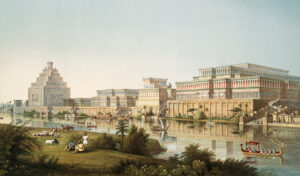 We need the moral clarity of Abraham. But let’s be honest, this clarity has the moral texture of a smoothie. Ok I shouldn’t have said that. I’m sure we could all use a smoothie right about now. We must grow from there to a place of moral complexity. We must learn the skills that Jonah has: We must learn to look around. To wonder what the other options are. To ask ourselves if there isn’t a better way. To ask what simplicity will cost us, and others. And we must never forget the one thing that Jonah knows from the beginning: his enemies, the Ninevites, have the capacity to change for the better, and they will do so when given the opportunity.
We need the moral clarity of Abraham. But let’s be honest, this clarity has the moral texture of a smoothie. Ok I shouldn’t have said that. I’m sure we could all use a smoothie right about now. We must grow from there to a place of moral complexity. We must learn the skills that Jonah has: We must learn to look around. To wonder what the other options are. To ask ourselves if there isn’t a better way. To ask what simplicity will cost us, and others. And we must never forget the one thing that Jonah knows from the beginning: his enemies, the Ninevites, have the capacity to change for the better, and they will do so when given the opportunity.
This Yom Kippur, Jonah chooses not to take the easy way out. Rather than doing what he is told, he choses a much longer and much riskier path. In 5782, may we be like him. Gmar chatimah tova.
Breathe: Yom Kippur 2021 Drash
September 29, 2021
By Alan Kosansky

On Yom Kippur, we read from the Machzor, “what we do this day can change our lives.” What we do from this moment until the shofar blows tomorrow night can change our lives.
This year, as last year, we are a Congregation. But we cannot congregate. The air we share may kill one of the dear friends amongst us. The simple and divine act of breathing has become a risk to our survival. It has created previously unimaginable obstacles to how we connect, how we congregate, and how we share each other’s lives. Our challenge in the coming year is how do we stay healthy and safe AND connected. How do we protect our lives and how do we imbue them with meaning through our connection to others? I believe we can answer this question if we take a few moments, both now and each day, to focus on our breath…both as the source of fears in these times of Covid, and even more so as the essence of our spiritual and physical connection to one another.
So let me share with you 5 thoughts on breath.
One, our breath connects us physically and spiritually to one another. Both in the moment, and across the centuries of time. A few years ago, in a Rosh Hashanah drash, Alex encouraged us to continue a centuries-long dialog amongst the generations of Jews that connects us to those who came before us and those who will follow us. This dialog has a physical component to it as well: Astrophysicist Ethan Siegel explains that in every breath we take, every inhale and word spoken, we breath in a portion of the exact same air that our ancestors breathed, and exhale atoms that our descendants will breathe for generations to come. Every single breath we take, connects us physically to our entire history, and our entire future. If we take a moment to notice this amazing scientific fact, then it connects us spiritually as well.
Two, we use our breath to inspire with word, song and sound. The shofar blast on Rosh Hashanah and the end of Yom Kippur is simply the sound of our breath, consolidated, stretched and transformed into sound, so that we can hear in our soul the miracle of our breathing. Story-telling is another powerful form for this dialog.
When the great Rabbi Israel Baal Shem-Tov
Saw misfortune threatening the Jews
It was his custom
To go into a certain part of the forest to meditate.
There he would light a fire,
Say a special prayer,
And the miracle would be accomplished,
the misfortune averted.
Later when his disciple,
The celebrated Magid of Mezritch,
Has occasion, for the same reason,
To intercede with heaven,
He would go to the same place in the forest
And say: “Master of the Universe, listen!
I do not know how to light the fire,
But I am still able to say the prayer.”
And again the miracle would be accomplished.
Still later,
Rabbi Moshe-Leib of Sasov,
Would go into the forest and say:
“I do not know how to light the fire,
I do not know the prayer,
But I know the place
And this must be sufficient.”
It was sufficient and the miracle was accomplished.
Then it fell to Rabbi Israel of Rizhyn
Sitting in his armchair, his head in his hands,
He spoke to God: “I am unable to light the fire
And I do not know the prayer;
I cannot even find the place in the forest.
All I can do is to tell the story,
And this must be sufficient.”
And it was sufficient.
Three, Kol ha’olam kulo
Gesher tzar me’od
Veha’ikar lo lifached k’lal.
The whole world
Is just a narrow bridge
and the main thing is to have no fear at all
I still remember vividly the first night of Aviva, my eldest daughter’s, life. We arrived home after a long day of Pam birthing Aviva. We lay Aviva down in a basinet next to our bed and Pam promptly fell asleep from the exhaustion of the birthing experience. I lay in the still of the night, listening to each and every breath of my new daughter, she still being less than 24 hours old. I was scared. I was scared that if I was not awake to confirm each breath, how could I be sure that she would still be breathing in the morning when we awoke. It was the most significant act of faith I have ever taken to allow myself to fall asleep, and trust that Aviva would continue to breathe through the night.
In these times of Covid, living cautiously but not in fear, sometimes takes an act of faith.
[Pause]
Our first breaths are at birth, our last breaths at death. In 2012 my dad had a stroke and then 3 days later a massive stroke that left him alive only because of the ventilator that enabled him to breathe. My sister and brother and I made the hard decision to remove him from the ventilator. The doctors informed us that he would then only breathe for 20 minutes or so. My first inclination was that I did not need to be present in the room for my Dad’s dying breath. However, on further reflection I remembered the ethos of my family and my Jewish community: life is about showing up, about being present for both the big and the small moments in each other’s lives. So my sister and brother and I sat with my father as each breath became thinner and more labored, and finally the last breath passed through his lips.
A Fourth reflection on breath: while we meditate on the miracle of breath, we would do well to also remember the too many in our country who have said “I cannot breathe” as their last living word before their death. For many in our country, this has been the story of the past two years as much as Covid. Hearing the personal stories of black parents coaching their teenage children how to be extra cautious during routine traffic stops has been eye-opening, if not heart-breaking. The parallelism between this story and the covid story is striking: there is a very thin line between that which sustains and protects us and that which threatens us.
If we are to transform our own lives, we can only succeed by doing our part to transform the society in which we live. Everyone’s breath is equally miraculous, every breath matters.
Lastly, five: you may consider starting each day with the following mediation from the morning blessings: Elohai neshamah shenatata bi tehorah hi. “My God, the soul, the breath, the neshamah that you have placed within me is pure”
Rabbi Zalman Schachter-Shalomi writes: “Our minds might insist that we go directly to the Infinite when we think of God, but the heart doesn’t want the Infinite; it wants a You it can confide in and take comfort in.” Amidst the jagged and often wrenching complexities of daily life, what a balm it can be to feel the Presence as close as my breath.
[Pause]
A hasidic tale tells of the disciple who asked his rabbi the meaning of community one evening when they were all sitting around a fireplace. The rabbi sat in silence while the fire died down to a pile of glowing coals. Then he got up and took one coal out from the pile and set it apart on the stone hearth. Its fire and warmth soon died out.
[Pause]
This day of Yom Kippur is a small replica of our life. We hunger for that which we deny ourselves. We think there is a well-planned script for what we are to do, but as the day passes, we realize we are improvising and working on intuition. The final closing of the gates at the end of Neilah seems very far away, yet it will be upon us and gone in what will seem like no more than a breath.
This past 18 months of a covid-19 world is yet another reminder that there is a very thin line between that which sustains us and that which threatens us.
May the next 24 hours, and the year ahead, be the beginning of a journey for you. A journey on which, in each breath, you experience more awe than fear, more connection than separation, and may you burn brightly and warmly with those near to you.
Gmar Hatima Tova.
Drash for Ki Tavo 5781
September 29, 2021
By Gregg Kinkley
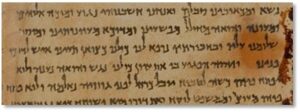
Sometimes, being assigned a drash rather than waiting for one you intentionally select ends up being a boon rather than a burden. That was certainly the case here. I had two preconceptions about this important parashah that I found were both wrong upon closer examination:
- Beginning of the End. I considered Ki Tavo just another parashah in Devarim that was in no other way remarkable except for containing the infamous Tokhekha (the curses). Instead, I find that it is the important beginning of the end of Moses’ narrative to Am Yisrael, his final charge to the people as they enter the Promised Land.
- House Without a Ki. I had lumped Ki Tavo in with Ki Teitzei (which immediately precedes it) as just another parashah full of “ki’s”. I find instead that Ki Tavo is not like other “Ki’s”: whereas in Ki Teitzei many paragraphs begin with that multivalent conjunction “ki,” Ki Tavo importantly begins with V’hayah ki tavo; “and it will be WHEN (not IF) you come into the land that HaShem has given you…”. The conclusion that you will enter the Land is already implicit: it is rather time to prepare for what must be done now that the Land will be occupied.
Many a drash has focused on the unusual or unexpected use of motion verbs in Hebrew (e.g., just two parashiyot hence, Vayelekh Moshe stresses Moses’ distancing himself from the people; in Lekh Lkha, the concept of going from the known to the unknown is alluded to). Here in Ki Tavo, we may ask why a verb of motion indicating direction towards the speaker (“to come”) is used, when Moses is pointedly being left behind and will not join his Instructed People in the Land. The sense of the verb Tavo here is not just “come” but “enter to reside”; an intentional change of state on the part of the addressed, an immersion. The phrase Ki Tavo therefore is not describing action from the point of view of the speaker, but rather from the vantage and psychological state of the referent: the people.
My approach to this discussion of Ki Tavo, in an attempt not only to elucidate but also to unify my remarks, will be to follow the old rabbinic method of exegesis known by the acronym PaRDeS (“paradise”): Pshat (surface meaning); Remez (metaphorical allusion); Drash (moralistic commentary); and Sod (deep or esoteric meaning).
Pshat: a list of what happens in this parashah
- Bikkurim: law of first fruits (with its verbal formula)
- Maaser: law of tithes (with its verbal formula)
- Exchange of vows (People to HaShem; HaShem to People)
- Torah chiseled on rock coated with plaster
- Chorus of Warnings with Stereo Amens from Gerizim and Eival
- List of Blessings (Good Results)
- List of Curses (Bad Results)
- Summary
On the Pshat level we are only looking at themes, at actions, at the continuity of the text/story. Although some interesting things are happening, they do not all appear extrinsically related. For those connections we need to search further, deeper.
Remez: the wedding
Given the rather cut-and-dried ordering of the contents of this entire parashah, the individual elements, both in their substance and their order, may at first appear arbitrary and rambling. On deeper reflection, one can begin to discern a familiar pattern – a remez or allusion to a sanctification, a kiddushin: a wedding between HaShem and His People.
1: Bikkurim, or the law of first fruits, is about humanity recognizing what HaShem has given us: that which we planted was given to us by Him, and not earned from our own efforts alone. The ceremonial verbal formula accompanying the bikkurim offering stresses our humble beginnings (“my father was a wandering Aramean”) and how we were snatched from this bootless, itinerant fate to become land-owning, crop-cultivating stewards of the Land through His mercy. This then is what the Groom brings to the marriage: the bride price, expressed as an obligation between God and Man.
2: Maaser, or the law of the tithe, is set forth to remind us of the duties between and among the people: not only to the priestly class, but also to the widow and orphan. It too is accompanied by a verbal formula, an affidavit of sorts, making the declarer swear that he has kept HaShem’s laws and not forgotten to give what must be given, do what must be done. Since this is of fiscal benefit to the people and society as a whole, this is an allusion to the money the bride brings with her into the union with HaShem – the dowery.
- The exchange of vows found in Devarim 26:17 – 18:
[17] You have avouched ( (האמרתthe Lord this day to be your God, and that you would walk in His ways, and keep His statutes, and His commandments, and His ordinances, and hearken to His voice. [18] And the Lord has avouched you ( (האמירךthis day to be His own treasure, as He has promised you, and that you should keep all His commandments.
How very much like the exchange of vows at a wedding this reads: “I take thee, HaShem, to be my God; and I take thee, Israel, to my treasured people.” Here the partition between the pshat narrative and the remez seems to fade away, the meaning of the words being so striking and fraught.
- When the text moves immediately on to describe a rock coated with plaster upon which the Torah is to be engraved, it seems that the conversation has indeed shifted dramatically – but in the world of remez this is but the next logical step: the lithic Torah stands as an eternal ketubah given by HaShem to his people, the seal of the sanctification. The laws and duties expressed therein protect the people and offer an eternal blessing.
- The chorus of warnings (“arur”) enunciated by the Levi’im, accompanied by the rest of Israel intoning a choral “amen,” reminds one of a typical wedding scenario where the officiant charges the couple with the rules and expectations of the parties in that holy estate, while the crowd of well-wishers, onlookers, and family all participate in praise and approval. And even though the text involved here is a selection of very negative things, the subject matter is relevant to marriage: laws of authority within the estate (man/God, parent/child, therefore man-wife – forgive the unintentional sexism implicit here); laws of sexual purity and taboos; laws of respect for property not one’s own (as two enter from an individual existence into a true partnership).
- The list of blessings that occur right after the “arurs” represents the Sheva’ Berachot of the wedding ceremony – quite a few more than seven to be sure, but the allusion is palpable.
Seen as an allusion to a holy union with HaShem, the topics and ordering of this parashah now fall into place.
Drash: Sotah 35b
In this delightful sugya in the Talmud, R. Yehudah and R. Shimon, perennial opponents when it comes to arguing dikduk from Torah, consider the purport and consequences of the exact words of the Torah where it is commanded that the people engrave the words of Torah on the rock covered with plaster:
ת״ר כיצד כתבו ישראל את התורה רבי יהודה אומר על גבי אבנים כתבוה שנאמר וכתבת על האבנים את כל דברי התורה הזאת וגו׳ ואחר כך סדו אותן בסיד אמר לו רבי שמעון לדבריך היאך למדו אומות של אותו הזמן תורה אמר לו בינה יתירה נתן בהם הקב״ה ושיגרו נוטירין שלהן וקילפו את הסיד והשיאוה
“The Rabbis taught in a baraisa: How did Israel inscribe the Torah? Rabbi Yehudah says they inscribed it on the stones, as it is stated: and you shall inscribe on the stones all the words of this Torah, and afterwards they coated them with plaster. Rabbi Shimon said to him: according to your words, how did the nations of that time learn Torah? (the inscription was covered up by the plaster according to R. Yehudah) Rabbi Yehudah replied: The Holy One Blessed be He endowed them with an extra measure of insight and they sent their scribes who peeled off the plaster and carried it away (i.e., a plaster cast copy in reverse of the inscription).”
From just these few verses of Torah, the Rabbis picked a fight over what seemed to them a contradiction in the literal reading of the process for incising the Torah on the rocks: is the chiseling to be done on the rocks directly, so that the plaster would be applied over the rock after the chiseling, obscuring the words of Torah, or do we cover the rock first with plaster and then chisel through the plaster?
The exegetical significance of this little extract centers around what it means to publish the Torah, to whom it is published, and by what means. Do we hide the Torah from the Nations, or are we commanded to spread it? And if we are to spread it, how? Rabbi Yehudah’s clever solution to Rabbi Shimon’s query (which, note, implies that he already expects it to be the duty of Jews to teach (or at least publish) Torah to the Nations, as he is concerned how that will happen if the words are plastered over) is that the Nations peel off the plaster, leaving in their hands what amounts to a reverse carbon copy, a plaster cast, of the Torah which they can “carry away” (assumedly to study). On an exegetical level, we then see that the Torah is to be given to the Nations, but separated from the Rock (i.e., HaShem, its direct Source) and given indirectly (printing from reverse image). The people Israel, on the other hand, have the original and the relationship with the Author: we have what is revealed and what is hidden!
Sod: the deeper structure of the parashah
Dichotomous revelation. We have seen at the beginning of this parashah that the laws of bikkurim are given, followed by an oral formula. The laws of maaser are then given, also with a corresponding oral formula.
The dichotomies here are salient:
- dues owed to HaShem (bikkurim) versus dues owed to Man (maaser to the priestly class, and alms to the poor on the third year of maaser).
- the need for an oral component (the formula) to the written requirement for both taxes.
- the dichotomy of the written law (Torah in plaster) and the oral expression of it (the Amen chorus on the Mounts).
This appears to be using staged elements to represent the trademark Jewish approach to divine law: a Written Law as explained and implemented by an Oral law. The template for the system that would be laid down in the Mishnah and Gemara are hinted at right here in the structure of the enunciation of the laws of Ki Tavo.
The Chorus of Arurs. When the Levites announced the specialized Arurs to the people arrayed on Mounts Gerizim and Eival, (along with the people’s amen), they were phrased as curses, but they were substantively nothing less than lo taasehs or negative commandments. This reminds us of the giving of the Ten Commandments at Sinai (another marriage metaphor for the Jewish people), but this time, in this telling, there are twelve commandments (the number of the tribes represented on the Mounts) rather than ten; they are told by the priestly class (God’s sheliach or agent on Earth) rather than HaShem Himself; and they are all negative commandments, rather than only half of them so.
Below is a list summarizing the general content of each of the twelve arurs into five categories, with the corresponding or relevant number of the Ten Commandments after each:
The Arurim:
- Authority: man to God, children to parent (#2, #5)
- Justice system for haves and have nots (#3, #9)
- Sex taboos (#7, #10)
- Two types of murder: secret and for hire (#6, #8)
- The seal: follow this law and be bound by it (#1)
| 1 | I am the Lord thy God |
| 2 | Thou shalt have no other gods before me |
| 2 | Thou shalt not make unto thee any graven image |
| 3 | Thou shalt not take the name of the Lord thy God in vain |
| 4 | Remember the sabbath day, to keep it holy |
| 5 | Honour thy father and thy mother |
| 6 | Thou shalt not murder |
| 7 | Thou shalt not commit adultery |
| 8 | Thou shalt not steal (understood as kidnapping) |
| 9 | Thou shalt not bear false witness against thy neighbour |
| 10 | Thou shalt not covet thy neighbour’s house |
| 10 | Thou shalt not covet thy neighbour’s wife |
| 10 | or his slaves, or his animals, or anything of thy neighbour |
The Blessings and the Curses. It is important to note that these blessings and curses read like consequences, not like laws (unlike the arurs on the Mounts that precede them). “If you follow all these commandments, then… (the blessings); but if you do not follow these commandments, then… (the curses).”
This manner of pronouncement reveals HaShem’s Laws not as criminal and civil laws of Man (“don’t do that;” “do that”) but rather as acts and their consequences as Laws of Nature (imagine the Law of Gravity being stated as Don’t float rather than If you let go of an object then it will fall).
Why so much repetition here? Why must every consequence be stated twice and in a positive/negative format? This is responsive to the halakhic requirement for the administration of the legal system on the people: no one can be held liable for the commission of an act that is the subject of a negative commandment unless he or she is (1) made to realize at that moment that the contemplated behavior is proscribed and (2) made aware of what the punishment will be should he or she commit the act. Having now fulfilled this requirement through the blessings and curses, the Law is now made binding on all the people through this form of mass publication.
The vows. The He’amars (“caused or made to say”: “spoken for”; “avouched”) Note the curious syntax of the two verses where the exchange of vows between HaShem and the People is made:
Et Adonai he’emarta hayom You avow the Lord today …
V’adonai he’emirkha hayom And the Lord avows you today…
The first vow, made by the people, has a syntax one would expect to find only in Klingon (!): Object, Verb, Subject; while the vow HaShem makes to the people has the expected order, at least by English standards, of Subject, Verb, Object. While Biblical Hebrew is often analyzed as “verb initial,” and without getting into secular scientific arguments of Chomskyan underlying structure, I think it fair to say that the first vow stands out as unusual, inasmuch as it begins with the grammatical particle signaling a definite direct object – not one’s first choice for beginning a sentence, irrespective of matters of stress. On the level of Sod, this could stand as a reminder that HaShem is always first, even when we perceive ourselves as the actor: He is always the Prime Cause.
And let us say, Amein.
בס״ד
Drasha Ki Teitzei
September 1, 2021
By R Daniel Lev
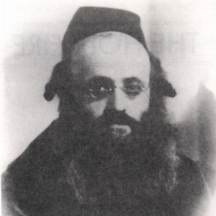 Like a number of rabbinically-inspired parshiot, this one will take a circuitous route from the first pasuk / sentence through a number of apparently unrelated ideas until it finally lands right back to the pasuk itself and provides a new meaning for it. And on top of that, we may end with a theme from the coming High Holidays.
Like a number of rabbinically-inspired parshiot, this one will take a circuitous route from the first pasuk / sentence through a number of apparently unrelated ideas until it finally lands right back to the pasuk itself and provides a new meaning for it. And on top of that, we may end with a theme from the coming High Holidays.
The teaching I want to share with you today comes from Rabbi Kalonymos Kalmish Shapira who lived in early 20th century Poland and died on November 3, 1943 in the Trawniki concentration camp. Some say he was the last new Rebbe in eastern Europe. He is best known as the Piazetsna Rebbe, named after the Warsaw suburb where he lived and provided care for children and other community members. Before he was taken to the concentration camp, he was able to have his writings buried in a large milk canister which was found after the war.
The Rebbe commented on the first pasuk of the Torah portion in Deuteronomy 21:10 that says: “When you go out to war against your enemies, and HASHEM delivers them into your hands, and you take them captive…”
כִּי-תֵצֵא לַמִּלְחָמָה, עַל-אֹיְבֶיךָ; וּנְתָנוֹ יְיָ אֱלֹהֶיךָ, בְּיָדֶךָ–וְשָׁבִיתָ שִׁבְיוֹ
Ignoring in this sentence the themes of war and triumph, the Piazetsna Rebbe brings up the idea of Chesed meaning Infinite Love. He offers a teaching from the second-generation Chassidic leader, Reb Dov Ber, the Maggid of Mezrich, who quoted Psalm 110:4 that says, “You are a priest forever” – Ata Kohein Le-Olam.
 The Maggid taught that the word for priest, Kohein, is the attribute of Chesed, Infinite Love. This notion probably comes from a midrash describing Aaron the Priest as a loving guy who served the community from the depths of his heart. In light of this, the Maggid re-translates the verse as saying, “You are Infinite Love forever.” From this we can understand why the Men of the Great Assembly, a semi-legendary body of priests, prophets, scholars and other leaders constructed many of the prayers we have today to include the formula: Baruch Atah… ”Blessed are You…”
The Maggid taught that the word for priest, Kohein, is the attribute of Chesed, Infinite Love. This notion probably comes from a midrash describing Aaron the Priest as a loving guy who served the community from the depths of his heart. In light of this, the Maggid re-translates the verse as saying, “You are Infinite Love forever.” From this we can understand why the Men of the Great Assembly, a semi-legendary body of priests, prophets, scholars and other leaders constructed many of the prayers we have today to include the formula: Baruch Atah… ”Blessed are You…”
These leaders offered this in order to bring us closer to the “You” who is Infinite Love. What is this “love?” Or, for that matter, what does it mean to “love G-d” or that “G-d is Infinite Love?” On the most intimate level it means connection. I’m sure you don’t feel connected to your loved ones because they look a certain way, are rich or give you things. What love is for most of us is a connection with our beloveds. Similarly, the Men of the Great Assembly wanted us to feel closely connected to HaShem – so they invited us to address the Divine as “You.”
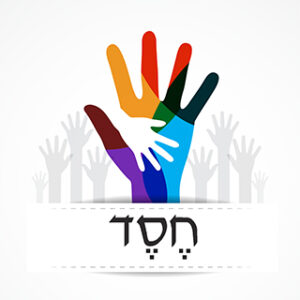 In doing this they shifted us away from the third person relationship we had with the Biblical-period G-d, such as, “He is Loving and Jealous.” Now, the closer relationship we have allows us to experience the Chesed / Infinite Love of the Divine Presence. As Rabbi Kalonymos Kalmish of Piazetsna said: “When we utter the blessing, ‘Blessed are you HaShem our G-d…,’ surely G-d is truly facing us.”
In doing this they shifted us away from the third person relationship we had with the Biblical-period G-d, such as, “He is Loving and Jealous.” Now, the closer relationship we have allows us to experience the Chesed / Infinite Love of the Divine Presence. As Rabbi Kalonymos Kalmish of Piazetsna said: “When we utter the blessing, ‘Blessed are you HaShem our G-d…,’ surely G-d is truly facing us.”
The Rebbe further differentiates our relationship with the Holy One by labeling the third person approach as Nistar, or hidden. We can also understand the more personal second person, “You,” relationship as meaning Nigla, or revealed. The Piazetsner said that at Mount Sinai, HaShem gave all of us the Torah as a community; it was Nistar, in the third person. However, the Torah teaching that is specific to each of us individually is hidden within the whole Torah given to the community. Though I received the general Torah like everybody else, my personal piece of Torah is usually inaccessible. However, when I am in more direct relationship with HaShem – by addressing Her as “You” (in the second person) – then the Nigla happens, my individual Torah is revealed.
The Piazetsna Rebbe expresses this by saying: “Although HaShem Teaches Torah to the entire Jewish people, this is not a teaching that is personal and individual to each person…so it is up to each of us to work to achieve that level where the (Infinite Presence) speaks to you individually.”
So how do we do that? The rabbi’s answer is simple: “through Prayer. By saying ‘You’ to HaShem a person achieves a revelation of G-d…He speaks directly to you…teaching you your individual Torah, directly and immediately. G-d says ‘you’ to the individual in return. When this happens, you can see and comprehend a part of the Torah that is uniquely yours…
I’d add that this can also occur at times when we are not formally praying. We do it when we bring the consciousness and awareness that imbues our prayers into other moments of the day.
OK – now for the moment we’ve all been waiting for: The Rebbe is about to directly comment on our Torah verse. Here it is again: “When you go out to war against your enemies, and HASHEM delivers them into your hands, וְשָׁבִיתָ שִׁבְיוֹ – and you take them captive…”
First of all, there is a long rabbinic tradition of re-imagining the “enemies” spoken of in this pasuk, and in the Torah in general, as representing our own inner struggles with harmful habits, destructive emotions or confusing thoughts. This has been further developed by Jews in the Musar ethical movement and those who hold Chassidic mystical perspectives. This pasuk invites us to do what we can to defeat these inner enemies.
 Next, the Piazetsner Rebbe comments on the end of the pasuk that says: “…so that you will take captives.” – וְשָׁבִיתָ שִׁבְיוֹ – Literally, you could read that Hebrew phrase as “You’ll captivate the captives.” But the Rebbe doesn’t read the meaning as coming from the Hebrew root-word, SHAVA – to capture. Instead, he reads it as SHUV – to return or restore – they both have somewhat similar letters. The Hebrew root word for return is related to TESHUVA – which can be translated as “turning your life around” from the misguided directions that do not serve us well. It is a foundational practice that we engage in during the High Holidays and beyond.
Next, the Piazetsner Rebbe comments on the end of the pasuk that says: “…so that you will take captives.” – וְשָׁבִיתָ שִׁבְיוֹ – Literally, you could read that Hebrew phrase as “You’ll captivate the captives.” But the Rebbe doesn’t read the meaning as coming from the Hebrew root-word, SHAVA – to capture. Instead, he reads it as SHUV – to return or restore – they both have somewhat similar letters. The Hebrew root word for return is related to TESHUVA – which can be translated as “turning your life around” from the misguided directions that do not serve us well. It is a foundational practice that we engage in during the High Holidays and beyond.
The Rebbe underscores this by translating the captives phrase into: “You will restore his restoration…’ He then goes on to cite other supportive Torahs: “And in the book of Aycha / Lamentations (5:21), the Jewish people say, ‘Restore us to You, and we will be restored’ – or “Return us to you and we will be restored” –
הֲשִׁיבֵנוּ יְיָ אֵלֶיךָ וְנָשׁוּבָה
The Rebbe continues: “And HaShem answers in Malachi 3:7 with ’Return to Me and I will return to you.” And apropos of Martin Buber’s philosophy of “I and Thou,” when we address HaShem as “You,” from a personal, heart-felt place during prayer, or at any moment, we can experience a return to the Source who will draw us back to Him even more closely.
I’d like to bless you, and please bless me back, that as we approach this coming Rosh HaShanah we should all receive our own, personal Torahs by taking a moment to talk with the Holy Presence. And that each of us, in our own way, will return to a higher level of who we are on the inside – to return to a better version of ourselves. Shabbat Shalom.
Drash for ʻEikev
By Sandra Z Armstrong
August 27, 2021

I once had a dream that my 90 year old friend, Mr. David Goodman was teaching me that living a Jewish life meant choosing from a whole array of desserts like the Viennese table of scrumptious options to satisfy all your cravings. I looked over to see the table of delicious options and Mr. Goodman said choose any of these options, each one will be wonderful and go do them. Mr. Goodman was a Torah scholar who read for our synagogue Temple Israel in NJ every Shabbat.
When he came down from the bimah after Torah reading, he often had tears in his eyes from the passion and emotion of the Torah. He reminded me a lot of Rabbi Morris Goldfarb.
I sat with Mr. Goodman every week and every Shabbat he taught me how to be Jewish by just observing him. Then there was Ziggy (he and Betty were both Holocaust survivors), Harry Grant very British with a bowler hat each week, Gerald Schraub, Marvin Amsterdam, Howard Schreiber, Steve Ehrlich and Lou Messulam. It was a small Shabbat minyan that I loved very much and I knew it wouldn’t last much longer as they would eventually move far away to retirement places or pass on. I took on the membership campaign as a mitzvah because I saw that we would be losing something more precious than gold. We would be losing our steady minyan to read Torah. At the very end of Mr. Goodman’s life, I visited him in his assisted living apartment. He showed me the items of the most importance to him. The framed picture of his Temple Israel Tribute for the many, many passionate years that he read Torah, showed us the way to mitzvot and lived a Jewish life. Included in his prized possessions were his tefillin and weathered prayer book.
 We all have models set before us of Yiddishkeit of people who taught us how to be good Jews. ʻEikev is the quintessential love song of a leader, Moses knowing that he would not make it to the promised land but forever until his last breath loving God and Torah. The Israelites were new people with a slave mentality and needed a tremendous amount of help and guidance in knowing HaShem’s ways.
We all have models set before us of Yiddishkeit of people who taught us how to be good Jews. ʻEikev is the quintessential love song of a leader, Moses knowing that he would not make it to the promised land but forever until his last breath loving God and Torah. The Israelites were new people with a slave mentality and needed a tremendous amount of help and guidance in knowing HaShem’s ways.
In our adult lifetimes, I am sure that each of us, even if we were not raised with all our mitzvot to follow, we had strong Jewish models of the direction to follow. We had guidance on how to keep what we find sacred to God and ourselves. And that my friends is the meaning of Congregation Sof Ma’arav. For we have faced many challenges in the last 18 months to keep Shabbat, to keep reading Torah, to honor our tradition and to do good under the eyes of HaShem. Our initial struggles with Zoom and not seeing each other in person were overcome for the love of this community. In the last 2 months when we went to a hybrid and in person service we took every possible care to follow the commandment of making Shabbat a holy experience for those faraway and also those of us here in this room today. Many hours, many ideas, thoughts, passion and feelings went into all these preparations.
Yet our rewards were great, we celebrated Shabbat with an incredible almost surprising amount of joy, whether we were just on Zoom or in a combined Zoom in person service. We never, ever will take for granted the ability to come together in a physical space and take out a Torah to read from the bimah. We have clung to the commandments in the best of possible ways. So I ask you, would Moshe Rebeinu, the greatest of our leaders, would Moshe be proud of us?
In ʻEikev and the book of Devarim, Moshe takes the creation story of a people and explains it to us in simple language. If you look at the reading for ʻEikev in the Torah, it is basic, simple, complete, like an arrow, his words come directly to our hearts. Other parashot in the Torah have new words, hidden values, and we search out the meanings. Not so for ʻEikev, as Moshe uses simple understandable repetitive words to recount the story of the birth of the Israelites into a strong people of faith. As HaShem created and gave birth to the world, so too does Moshe continue this creation story. He was born and designated to create the nation of Israel.
Our tradition teaches us to look back and to look forward almost simultaneously. Our own Biblical Hebrew language is who we are. For what other language other than Hebrew, in the very structure of their verbs of action “asa,” to do, to make, can flip back and forth between past and future within each action. We at Sof Ma’arav look back to keep and find joy in our beautiful community. The word for they kept is “shamru” they guarded Sof in the past. V’shamru they will guard Sof into the future. The “vav” consecutive links our Biblical past into our future days.
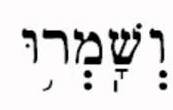 Moshe taught us HaShem’s words that man cannot live by bread alone. With food and being satiated, you go from one meal to the next. Trying to fill up on that enjoyment of the moment. When in reality, with community, mitzvot and love of Torah you are “full up” all the time and especially when celebrating Shabbat together.
Moshe taught us HaShem’s words that man cannot live by bread alone. With food and being satiated, you go from one meal to the next. Trying to fill up on that enjoyment of the moment. When in reality, with community, mitzvot and love of Torah you are “full up” all the time and especially when celebrating Shabbat together.
God warns us to never become complacent through Moshe’s words. When we prosper and are living a “good life” then we need to remember how we were created and why. To live a full life, a good life on earth reflected in heaven is to do “asa” mitzvot and never forget that we are humans, sometimes a little higher than animals. Our wants, needs and desires must be directed like an arrow toward heaven at all times.
Drash on Va-Etchanan
August 27, 2021
By Don Armstrong
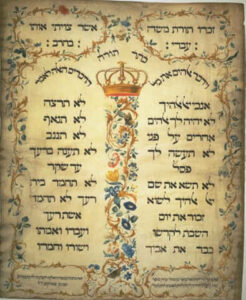
Devarim, the fifth and last moshianic book of the Pentetuch, lays the foundation for the monotheism of modern Judaism by highlighting the supremacy of Adonai. In the preface to Devarim on page 980 of Etz Hayim, Jeffrey Tigay notes that today’s parsha is, ”the most clear advocate of monotheism and the ardent, exclusive loyalty that Hashem’s chosen people owe to their loving, just and transcendent God.”
Commentators on today’s parsha, “Va-Etchanan,” emphasize that, despite its small size, Israel has an obligation to be a light unto all the nations of Hashem’s world. Moshe stresses Hashem’s covenant with the patriarchs that was affirmed at Mt. Sinai, Mt. Horeb and in Israel’s travels in the wilderness and which is reaffirmed when Israel enters the promised land.
The book of Devarim anticipates Israel’s enjoyment of Hashem’s bounty in the promised land, but this bounty and Israel’s welfare are conditioned upon maintaining a society that is governed by Hashem’s social and religious laws. These laws are Hashem’s gift to Israel; their observance secures the mutual closeness and love between them. The Torah’s humanitarianism is most developed in Devarim by emphasizing the ideas of social justice and Tikun Olam, with concern for the welfare of the poor and our duty to repair and maintain Hashem’s creation.
Devarim urges every Israelite to study and understand Hashem’s laws. It explains the meaning of events and the purpose of Hashem’s laws to obtain Israel’s willing, informed consent. Devarim also has strongly influenced later Jewish tradition. The core of Jewish practice is the daily recitation of the Sh’ma and the public reading of the Torah. Also based on Devarim are the duties to bless Hashem after meals, say Kiddush on Shabbat, affix mezuzot to door posts, wear tefillin and tzitzit, perform acts of charity for the poor and much more. Devarim’s impact on Jewish life cannot be overstated. No idea has shaped Jewish history more than monotheism, and no verse has shaped Jewish theology, consciousness, and identity more than the Sh’ma.
In researching my drash, I studied the “Va-Etchanan” drashes prepared over the last decade by Rabbi Jonathan Sacks, of blessed memory. So what is the Sh’ma? Rabbi Sacks said that it is the supreme testimony of Jewish faith. He noted that two ancient civilizations that shaped Western culture were very different in their respective world views: the ancient Greeks were masters of the visual arts (art, sculpture, architecture and theater), a sight-based culture of the eye. Ancient Jews, as a profound religious principle, were not.
Hashem, the focus of ancient Jewish culture and worship, is invisible. Hashem could be heard, but not seen. Thus, ancient Jewish culture was an oral culture of the ear. Despite the fact that Torah, the law of the Jewish people, has 613 commandments, Rabbi Sacks noted the astonishing fact that Biblical Hebrew had no verb for to obey. This affects our entire understanding of Judaism because it shows that despite our focus on the divine commandments, ours is not a faith that values blind, unthinking obedience. Instead, Hashem wants us to understand why the commandments were made so that we can develop a moral conscience. What Hashem wants us to do is not irrational or arbitrary; it is for each Jew’s welfare, the Jewish people’s welfare, and ultimately the welfare of all humanity.
 Rabbi Sacks also focused on a brief passage buried amidst the epic portions of today’s parsha that has large implications for our moral life in Judaism: “You shall diligently keep the commandments of the Lord your God, and his testimonies and his statutes, which he has commanded you. And you shall do what is right and good in the sight of the Lord, that it may go well with you…”. What is meant by the right and the good that is not already covered in the preceding verse? Rashi says it means that one should not adhere strictly to the letter of the law because the moral life may require one to compromise his rights or go beyond his duties under the law to produce a just result. Ramban agreed with Rashi but he went further saying that, “even where Hashem has commanded you, do what is good and right in his eyes, for Hashem loves the good and the right.”
Rabbi Sacks also focused on a brief passage buried amidst the epic portions of today’s parsha that has large implications for our moral life in Judaism: “You shall diligently keep the commandments of the Lord your God, and his testimonies and his statutes, which he has commanded you. And you shall do what is right and good in the sight of the Lord, that it may go well with you…”. What is meant by the right and the good that is not already covered in the preceding verse? Rashi says it means that one should not adhere strictly to the letter of the law because the moral life may require one to compromise his rights or go beyond his duties under the law to produce a just result. Ramban agreed with Rashi but he went further saying that, “even where Hashem has commanded you, do what is good and right in his eyes, for Hashem loves the good and the right.”
Ultimately this reflects the tension between the two great principles of Judaic ethics: justice and love. Justice is universal. It treats all people alike, rich and poor, the powerful and the powerless, making no distinctions based on color or class. But love is particular. A man loves his wife and parents love their children for what makes each of them unique. The moral life combines both aspects and this is why moral decisions cannot be reduced solely to universal laws. This is why the Torah speaks of the “right and the good” over and above its commandments, statutes and testimonies.
I conclude my drash with a paraphrase of the beautiful words of Rabbi Sacks in his Covenant and Conversation written in 2007:
In the silence of the desert the Israelites were able to hear the word of Hashem. And one trained in the art of listening can hear not only the voice of Hashem but also the silent cries of the lonely, the distressed, the afflicted, the poor, the needy, the neglected and the unheard. For speech is the most important of all gestures, and listening is the most human and divine of all gifts. Hashem listens and asks us to listen. That is why the greatest of all commands, the one we read in today’s services, the first Jewish words we teach our children, the last words of Jewish martyrs as they went to their deaths, are the words of the Sh’ma. It is Moshe’s command to Israel to listen and learn from Hashem and teach this wisdom to our children.
As we did earlier in our service today when we recited the Sh’ma, we covered our eyes to shut out the world of sight so that we could more fully enter the spiritual world of sound, not the world of Hashem’s creation but Hashem’s spiritual world of revelation. But if we create an open, attentive silence in our soul, we can hear Hashem’s still, small voice of love and revelation.
I pray that in today’s troubled and disquieting times, each of us takes the time each day to listen to Hashem’s voice and find comfort and solace in his direction and love.
Shabbat Shalom
Parashah Pinchas – Zelophehad’s Daughters
August 1, 2021
Drash by Robert Littman
 The Torah is the sacred story of the Jewish people for a period of our first 500-600 years, from our origins with Abraham to the death of Moses. It is a sacred story because it relates the interaction of God and history. The Torah contains a narrative, and woven into the narrative a law code, ranging from basic, almost universal laws of civilization, that is the Ten Commandments received by Moses on Mount Sinai, to mundane regulations such as separation of mixed fibers, and inheritance laws.
The Torah is the sacred story of the Jewish people for a period of our first 500-600 years, from our origins with Abraham to the death of Moses. It is a sacred story because it relates the interaction of God and history. The Torah contains a narrative, and woven into the narrative a law code, ranging from basic, almost universal laws of civilization, that is the Ten Commandments received by Moses on Mount Sinai, to mundane regulations such as separation of mixed fibers, and inheritance laws.
The fundamentalist view of the Torah is “Torah from Sinai,” which sees the Torah as a document dictated to God on Sinai: “This is the Torah that Moses put before the people of Israel, from the mouth of God by the hand of Moses” (Numbers 9:23).
Modern analysis of the text has shown that the Torah contains material from many periods and the text we now have reached its present form by the end of the 7th century BCE, though smaller additions and changes continued on until the text was finalized in the last centuries of the first millennium BCE. Minor changes continued until the complete fixation of the text in the 6th – 10th century CE by the Masoretes. For example, Goliath in the Hebrew texts of the Dead Sea Scrolls and Septuagint (Greek translation of the Hebrew Bible) was 4 ½ cubits (6 ft. 9 in.), versus 6 ½ cubits (9 ft. 9 in.) of the Masoretes.
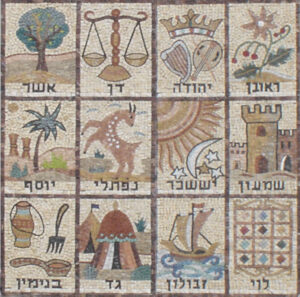 The story of Zelophehad’s Daughters relates to inheritance, particularly of land. While semi-Nomadic tribes like the B’nei Yisrael had inheritance of moveable property and wealth (as is the case among modern Bedouins), the description of inheritance seems to relate to land ownership and a period when the Israelites had settled in Israel. The laws set up for Zelophehad’s daughters represent inheritance of a settled land. The story in the Torah acts as the theological justification for the legal rights of inheritance that were practiced in ancient Israel.
The story of Zelophehad’s Daughters relates to inheritance, particularly of land. While semi-Nomadic tribes like the B’nei Yisrael had inheritance of moveable property and wealth (as is the case among modern Bedouins), the description of inheritance seems to relate to land ownership and a period when the Israelites had settled in Israel. The laws set up for Zelophehad’s daughters represent inheritance of a settled land. The story in the Torah acts as the theological justification for the legal rights of inheritance that were practiced in ancient Israel.
Many commentators throughout the ages have held Zelophehad’s daughters and their inheritance rights as some extraordinarily modern recognition of women’s rights. In fact, nothing could be further from the reality. The ancient Israelites organized their society as a patrilineal, patrilocal kinship group. Membership was assigned based on descent from a common male ancestor.
The Israelites were formed into 12 tribes. These tribes were a kinship based group, where membership was conferred on those who descended from one of the children of Jacob. This kinship group, called the shevet or matteh, meaning tribe, had smaller patrilineal kinship groups, the mishpachah (extended family) and beth-av (immediate family).
One of the overriding principles of the kinship group was the maintenance of the land within the family, and a strong prohibition against alienation of the land from the kinship group. A man would bequeath his land to his sons. However, what happens if he dies without sons, only daughters or no heirs. In the case of no heirs, the land would pass to his nearest patrilineal relative – father, brothers – or their patrilineal descendants. In the case of daughters, the daughters were married off to their nearest patrilineal relative, usually patrilineal first cousins.
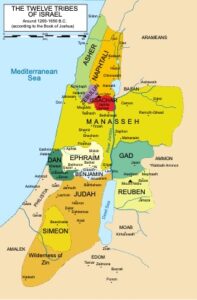 The land would then pass to the husband of the daughter, and thus remain in the patrilineal lineage of the beth-av. This also was a means of providing assurance that daughters would share in the benefits of their father’s property. This system of inheritance was almost identical to that practiced by other ancient patrilineal societies, such as the Greeks and the Romans. It was not unique to ancient Israel.
The land would then pass to the husband of the daughter, and thus remain in the patrilineal lineage of the beth-av. This also was a means of providing assurance that daughters would share in the benefits of their father’s property. This system of inheritance was almost identical to that practiced by other ancient patrilineal societies, such as the Greeks and the Romans. It was not unique to ancient Israel.
Sacred narratives thus are used to reinforce societal practices. How then do we react to the societal practices in the Torah that differ from our own? Today, in most of the world, women can inherit in the own right, and we follow this practice even in modern Israel. The Torah tells us to stone homosexuals. We no longer do this, nor many other laws of Numbers and Leviticus. How do we pick and choose what laws we do follow? That is a issue that Jews have struggled with for the last 1500 years. The answers are not simple, and the debate will continue as long as there are Jews.
Balak-Balʻaam Drash
August 1, 2021
By Marlene Booth
I’ve been thinking about storytelling a lot lately, about why we tell the stories we do, about who tells those stories, and about what we can learn by shifting the point of view of the storyteller. And the parshah of Balak is a perfect place to begin. Why, for starters, is there a story about a talking donkey? Why does this story appear here in Ba’midbar in the midst of the Israelites still wandering in the desert and kvetching to Moshe for more food, more water, and, with Korah and his followers, more power? Who is telling the story in Balak? What difference does that make?
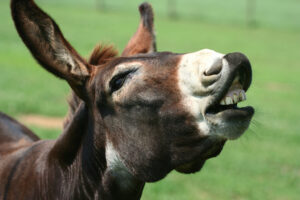
A donkey showing his teeth and braying.
Just to refresh your memory, in this week’s parsha, Balak, King of Moab, is afraid that the Israelites will attack his nation. He asks help from the pagan prophet, Balʻaam, to come to his nation and curse Israel. God does not allow Balʻaam to go but then he lets him go as long as Balʻaam prophesies only what God commands. So Balʻaam goes with Balak’s emissaries, riding on his trusted donkey. But 3 times en route, the donkey sees an angel with a drawn sword blocking the way and the donkey prevents Balʻaam from moving forward. Each time, Balʻaam beats his donkey. After the third time, the donkey speaks to Balʻaam, protesting his beatings and pleading her case as an always loyal donkey. In that moment, the angel the donkey has seen finally appears to Balʻaam and makes clear to him that if the donkey had not stopped moving, the angel would have killed Balʻaam. Nonetheless the angel allows Balʻaam to go to Balak but only to say words that God puts in his mouth. So Balʻaam goes to to do Balak’s bidding but all of Balʻaam’s curses toward Israel turn to blessings, including the famous poem we read at shachait, “ma tova ohalecha yaacov,” “how beautiful are your tents Jacob, your dwellings Israel. Blessed are they who bless you.” Balʻaam goes so far as to promise that the Israelites will triumph over their enemies, including Moab.
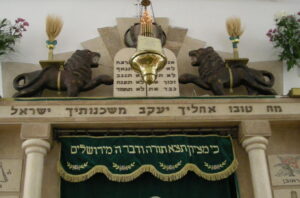 So, in this parshah, we have a talking, sensible donkey who sees more than her master can see, a pagan prophet who, though a pagan, blesses Israel and predicts the triumph of the Israelites—what’s going on here? Why is this story included in Ba’midbar, sandwiched between parshat chukat that deals with Moses’ sister Miriam dying, Moses’ brother Aaron dying, and Moses being punished for his anger in striking a rock by not being allowed to enter the Promised Land, and next week’s parshat Pinchas in which a census is taken, the daughters of Zelophechad plead for and gain their rights of inheritance, and Moses’ successor, Joshua, is named? Those parshiot seem on one level at least to deal with the founding generation passing on, a new person assuming leadership, rights of inheritance established, and the story set to continue in the Promised Land with a new generation. Parshat Balak proceeds as if untouched by the story of the wandering Israelites.
So, in this parshah, we have a talking, sensible donkey who sees more than her master can see, a pagan prophet who, though a pagan, blesses Israel and predicts the triumph of the Israelites—what’s going on here? Why is this story included in Ba’midbar, sandwiched between parshat chukat that deals with Moses’ sister Miriam dying, Moses’ brother Aaron dying, and Moses being punished for his anger in striking a rock by not being allowed to enter the Promised Land, and next week’s parshat Pinchas in which a census is taken, the daughters of Zelophechad plead for and gain their rights of inheritance, and Moses’ successor, Joshua, is named? Those parshiot seem on one level at least to deal with the founding generation passing on, a new person assuming leadership, rights of inheritance established, and the story set to continue in the Promised Land with a new generation. Parshat Balak proceeds as if untouched by the story of the wandering Israelites.
One possible explanation for Parshat Balak comes from storytelling. Who is telling the story? Whose perspective are we hearing? In Balak, we move away from the Israelites being the central characters and we see one part of the story of their wanderings not from their POV (or the omniscient narrator’s POV with the Israelites being the central actors) but from the POV of their enemies. What are they thinking about the Israelites? The scene of the action shifts, we leave the Israelites behind for a moment, and we see how others, in this case Balak, king of Moab, perceive them. Outsiders are beginning to fear the power of the God who protects the Israelites. Even a pagan prophet like Balʻaam listens to God and his angel and succumbs to God’s intervention. No less a scholar than Nechama Leibowitz argues that the pagan Balʻaam ultimately “gives himself up to the divine prophetic urge.”
Parshat Balak seems to be in BaMidbar not to move along our narrative but to interrupt it. Perhaps in the midst of establishing succession in Israel and showing repeated complaints and rebellions among the Israelites, the Torah wants us to take a breath, stop the action, and consider the scope of God’s influence, specifically from the point of view of outsiders. It is as if the Torah is saying, “nu, stop kvetching for a moment and look at what even our enemies say about God.” If God can turn curses into blessings, maybe we will make it to the Promised Land despite ourselves. Maybe Balʻaam and our talking donkey have much to teach us about seeing what’s in the road ahead and about listening, even when complaining is much more fun.
Shabbat Parashat Matot-Masei 5781
July 29, 2021
By Dina Yoshimi
Rosh Chodesh Menachem Av
Parashat Matot opens (BaMidbar 30:3) with God’s commandments regarding the making of vows to H”S (אִישׁ֩ כִּֽי־יִדֹּ֨ר נֶ֜דֶר לַֽיהֹוָ֗ה) and the taking of oaths imposing an obligation on oneself (אֽוֹ־הִשָּׁ֤בַע שְׁבֻעָה֙ לֶאְסֹ֤ר אִסָּר֙ עַל־נַפְשׁ֔וֹ).
BaMidbar, Chapter 30, verse 3 begins: אִישׁ֩ כִּֽי֨ a man who (makes a vow, etc.)…
BaMidbar, Chapter 30, verse 4 begins: וְאִשָּׁ֕ה כִּֽי and a woman who (makes a vow, etc.)…
Verse 3 addresses all concerns regarding a man who undertakes a vow or an oath; all matters regarding a man are accounted for in a single verse.
As for a woman, the matter begins in verse 4, and continues on until verse 16 (BaMidbar 30:4-16), addressing the various circumstances that may apply in the case of אִשָּׁ֕ה כִּֽי, a woman who makes a vow, etc.
What can I say? Women are complicated!
The text addresses when a woman’s vow or oath stands, and when it may be annulled; and, while the very fact that a woman’s vow or oath may – under certain circumstances – be annulled by her father or by her husband may send readers down the path of condemning “the traditional patriarchal society” or protesting “the treatment of women as property”, both of these purported “readings” of the text completely ignore what is actually written, to wit, that there are different laws regarding the taking of a vow or the swearing of an oath for men and women:
אִישׁ֩ כִּֽי֨ a man who (makes a vow, etc.)…
אִשָּׁ֕ה כִּֽי a woman who (makes a vow, etc.)…
NOT אִישׁ֩ כִּֽי֨ where the laws are only for men and there are NO laws for women because women cannot make vows to H”S or swear sacred oaths; and
NOT אִישׁ֩ כִּֽי֨ and we have to wait for the Rabbis to explain whether אִישׁ here only refers to men, or whether it refers to men and women alike.
No, it’s as clear as day: The Torah is telling us that there can be different laws for men and women, and, most importantly, that women can make vows and swear oaths.
Perhaps the most well-known example of a woman making a vow to H”S comes from the very opening of I Shmuel; the story comprises the haftarah we read on the first day of Rosh HaShanah, the story of Hannah. The story relates how Hannah, married to Elkanah, was childless while his second wife, Peninah, had given birth to his children. While on their annual pilgrimage to Shiloh to make an offering to H”S, Hannah is overcome with מָ֣רַת נָ֑פֶשׁ (marat nefesh ‘bitterness of heart/soul’) – she is inconsolable, even after her husband assures her of his unconditional love, whether she bears him children or not.
In the depths of her despair, pouring out prayers to H”S through her tears, she makes a vow (I Shmuel 1:11, וַתִּדֹּ֨ר נֶ֜דֶר): If H”S will grant her a son, she will dedicate him as a nazir to the service of H”S.
A married woman, in emotional turmoil, bordering on existential distress, vows to dedicate a child – the offspring of a mother and a father – and a male child, no less — the potential inheritor of the family name and inheritance –, without consulting the husband and father-to-be. If ever there was a vow to be annulled by a husband, this would be it.
And yet, when Hannah finally gets around to sharing this vow with her husband, after the child already has been born and named, her husband’s response is unpaternalistic, unpatriarchal, and unauthoritative. He says, עֲשִׂ֧י הַטּ֣וֹב בְּעֵינַ֗יִךְ “Do what is good in your eyes.” (I Shmuel 1:23) – not quite the image of woman as a downtrodden, dominated, powerless piece of property that some would read in the plain sense of the text.
This pushback against ascribing a male dominant, patriarchal system to ancient Israel resonates with the work of Dr. Carol Myers, Professor Emerita of Religious Studies at Duke University. Myers, in her 2013 Presidential Address to the Society of Biblical Literature (‘Was Ancient Israel a Patriarchal Society?’, Journal of Biblical Literature, 133(1), 2014) provides archaeological and textual evidence to argue that, “In the aggregate, [tasks undertaken by women in Ancient Israel] likely required more technological skill than did [those undertaken by men].” (p. 21) She cites anthropologist Jack Goody’s comment that, “…because women could transform the raw into the cooked and produce other essential commodities, they were seen as having the ability to ‘work … wonders.’” (p. 21).
Annul my vow at your peril, o spouse of mine!
But seriously – the point Myers aims to make is that, rather than seeing Biblical text as presenting us with a male-dominating-female society that has no place for women’s independence or voice, we would do better to conceptualize a society where “female–male relationships are marked by interdependence or mutual dependence” such that “…for many—but not all—household processes in ancient Israel, the marital union would have been a partnership.” (pp 21-22, emphasis added)
Aaah, the marital union…this phrase from Myers resonates with the closing verse of the section on vows in our parashah (BaMidbar 30:17):
אֵ֣לֶּה הַֽחֻקִּ֗ים אֲשֶׁ֨ר צִוָּ֤ה יְהֹוָה֙ אֶת־מֹשֶׁ֔ה בֵּ֥ין אִ֖ישׁ לְאִשְׁתּ֑וֹ בֵּֽין־אָ֣ב לְבִתּ֔וֹ בִּנְעֻרֶ֖יהָ בֵּ֥ית אָבִֽיהָ׃
These are the chukim (the decrees) that H”S commanded Moses, between a man and his wife, and between a father and his daughter in her youth, in her father’s house.
The mitzvot of Torah are often identified as falling into two categories: bein adam l’Makom (between a person and H”S) and bein adam l’chavero (between a person and his/her fellow); but here, this closing verse teaches us to see that there are other sacred relationships that must be recognized, valued and protected — relationships that form the very fabric of our family units, relationships that are as old as Creation itself.
The first and primary relationship is that between husband and wife. Rabbi Adin Steinsaltz reminds us (Biblical Images: Men and Women of the Book, p. 5) of the Talmudic teaching that “Adam and Eve came into being as a single creature with two faces or sides – the one, male; the other, female…woman was created from Adam’s tsela [a word that can mean “rib” or “side”] because she was to begin with a tsela, or a side or aspect of [adam ha-rishon] primordial man, who thus came to be two distinct persons.” R. Steinsaltz continues, “The upshot is that the relationship between men and women…has the character of the quest for something lost…male and female are essentially parts of a single whole, originally created as one being…”
As for the relationship of parent to child, Steinsaltz (ibid., p. 6) argues that procreation “is a secondary function [of the male-female relationship]…the birth of a child is a kind of bonus, a new creation…wondrously brought into being by the very act of reunification.”
These sacred relationships then are primordial and mysterious, they are the stuff of ongoing acts of creation – leaving (the house of one’s father) and cleaving (to one’s spouse). Perhaps it is no surprise that the laws regarding these relationships בֵּ֥ין אִ֖ישׁ לְאִשְׁתּ֑וֹ בֵּֽין־אָ֣ב לְבִתּ֔וֹ (bein ish l’ishto, bein av l’vito, between a man and his wife, and between a father and his daughter) are presented as חֻקִּ֗ים (chukim, decrees), that is, those decrees that transcend rational reason, that we are not meant to fully understand.
Thus, even as the Torah sets out with an appeal to our rational sensibilities – what could be more natural than differentiating rules for men from those for women? – this closing verse אֵ֣לֶּה הַֽחֻקִּ֗ים אֲשֶׁ֨ר צִוָּ֤ה יְהֹוָה֙ אֶת־מֹשֶׁ֔ה (eileh hachukim asher tzivah H”S et Moshe…) teaches us to challenge our expectations and question our assumptions; and, rather than accepting division and dominance, push ourselves to see, to learn, and to understand that we are inevitably bound up in relationships of oneness, of reconnecting with something lost, a wholeness we can only regain by seeing ourselves as tzela, as sides that seek to reconnect with each other.
Shabbat Shalom!
Drash—Shabbat Hazon
July 28, 2021
Special Guest Drash by Rabbi Natan Margalit, son of Fran Margulies
ציון במשפט תפדה ושביה בצדקה Zion shall be redeemed with judgement and those that return to her with righteousness.
Why the repeat? If Zion is redeemed, don’t we already know that those that return to her will also be redeemed?
So asks the Piaseczner Rebbe, Rabbi Kalonymous Kalman Shapiro. He is most famous for being the Hasidic Rebbe of the Warsaw Ghetto. His sermons from the time of the war are preserved in a book called Esh Koshesh, the Holy Fire. It was buried in a metal canister and hidden when he knew that he, too, would be taken out of the ghetto. He was brought to a the Trawniki work camp where he was part of a group of Jews, both secular and religious, who formed a mutual aid pact with one another. He swore that he would not accept a path to freedom without the whole group being free. And indeed, the underground came in a tunnel and offered, begged him to escape with them to freedom and life. But he had made a bond and an oath to the whole group. He was killed in the massacre of all the Jews in the Trawniki camp on November 3, 1943.
It wasn’t only his sermons from the ghetto that were buried in that metal canister. It was his whole life’s work. He had one published book that had come out before the war—on education of younger children, Chovot HaTalmidim—and it had established his reputation as a leader in progressive religious education at the time. But the rest of his life’s work including the book that I am citing now, Derekh HaMelekh, was buried in that canister.
So, coming back to our Haftorah, what exactly was the rebuke that Isaiah was giving Israel? They were doing all the rituals but it made God sick. It wasn’t just that they were hypocrites—they didn’t believe what they were saying in their prayers—but it was their actions which spoke louder than words. Violence, lies and theft were the actions of these supposedly pious worshippers.
The destruction has to do with their actions, and if we are to learn from this Haftorah, our actions as well. But looking deeper—what was it about those actions that were so wrong? They were self-centered. They ignored the good of others for their own gain; they trod on the dignity of the poor, they cheated the orphan and the widow, they profited from violence and lies. They put themselves at the center.
In his commentary on Shabbat Hazon, the Piaseczner writes about the importance of our actions, and how actions and thoughts are intertwined.
He is writing this commentary in 1936. As the leader of his Hasidic community, he feels the need to help his followers keep their faith strong even as they see very little evidence of God’s justice and mercy. Quite the opposite, they see evidence all around of evil seeming to be rewarded and the good being punished. He describes how even in people who want to believe that God is just and loving, thoughts of doubt can come into their minds. Even though they want to keep their faith strong, eventually these thoughts will wear it down, just as dripping water will eventually wear down a stone.
He asks: How can one avoid this almost inevitable weakening of faith through stray thoughts?
He answers: It depends on how much we put ourselves, even our thoughts, at the center?
He says if we put ourselves at the center in our day-to-day actions: when we want to sleep, we sleep, when we want something, we take it—then we’ll also be at the mercy of our own wandering thoughts because in our actions we’ve put ourselves at the center of our lives. The only way to not be at the mercy of our stray thoughts, and to keep ourselves solid in trust, he says, is to get in the habit of acting for others, giving of ourselves to serve others will reorient our sense of self and help us from putting ourselves at the center.
It reminds me of the Buddhist meditation bumper sticker I’ve seen: “Don’t believe everything you think.” When we center our sense of Being beyond our personal selves, we gain perspective and strength to not listen to all our stray thoughts.
When we do Tzedakah, he says, we give of ourselves. Not only do we help others, but we also reorient our own being, decentering ourselves and putting our energies into the larger whole.
So, he comes back to our verse from Isaiah: ציון במשפט תפדה ושביה בצדקה “Zion will be redeemed with justice, those that return to her with Tzedakah.” But שביה, “those that return to her,” can also be translated, “those that have gone backwards”. So, he interprets the second half of the verse to say, “Even after they are redeemed, they could backslide into their old habits of self-centered behavior… but, through Tzeddakah, that backsliding can be avoided and they can be redeemed.” Giving of ourselves for others changes us, makes us solid and keeps us on the path to redemption.
As we prepare for T’isha B’Av on this Shabbat Hazon, we reflect on the way that disaster comes into the world through habits of putting ourselves first, isolating ourselves from community, from those in need, from the earth and all its inhabitants. The way out of this is to reorient ourselves to the whole, toward giving of ourselves for the good of all. This shift in focus from isolated self to connected relationship is the key to going from the destruction of T’sha B’Av, and the destruction we see coming upon our world today, toward healing and building a thriving, flourishing world.
Shlach L’Chah
July 2, 2021
Drash by Alex Golub
Shabbat shalom. Today we exist at the intersection of two remarkable events.
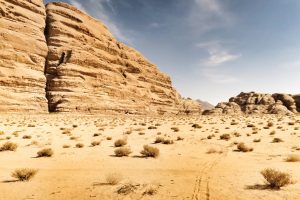 First, the remarkable story we have just heard: Moses sends twelve spies to scout out the holy land, only to find that all of the spies but Joshua and Caleb believe the local people are too strong and an invasion will fail. The Israelites believe them and complain bitterly that Moses should have left them in Egypt. God decrees that the Israelites will wander for 40 more years in the desert and all the haters will die, so that only Caleb and Joshua will get to enter the promised land.
First, the remarkable story we have just heard: Moses sends twelve spies to scout out the holy land, only to find that all of the spies but Joshua and Caleb believe the local people are too strong and an invasion will fail. The Israelites believe them and complain bitterly that Moses should have left them in Egypt. God decrees that the Israelites will wander for 40 more years in the desert and all the haters will die, so that only Caleb and Joshua will get to enter the promised land.
The second remarkable event taking place this week is, of course, the reopening of our shul with a full service and an in-person minyan. It has been a long process and I want to thank all the other people in this room with me today for making it happen — especially Sandy (who I’ll come back to in a bit). I’d also like to thank everyone watching, and everyone who kept up our observances virtually during this past COVID season, observances which, I’ll be the first to admit, I totally didn’t observe.
The theme that connects these two events is doubt. The Talmud compares the spies’ doubts to a man who worries his wife is a sotah: a woman suspected of adultery. The spies think of God like a partner who you suspect of infidelity. Did they, or didn’t they? Will they, or won’t they? On the one hand, it seems amazing that even now — after the ten plagues, after crossing the Red Sea, after receiving the ten commandments, and after eating manna from heaven — even now after all of the that, the Israelites are unsure of whether or not they can trust God. On the other hand, I imagine that after all that, my baseline sense of reality would be totally destroyed as well. When you live in unusual times, it’s hard to tell what’s normal and what’s not.
God, on the other hand, believes the spies doubt themselves rather than God. The spies say that they are too weak to defeat the Canaanites. “They are giants,” they say. “They looked on us as if we were grasshoppers.” A story in Numbers Rabbah has God replying to the spies, “How do you know what you appeared like to them? Maybe they thought you looked like angels compared to them!” In this drash, the spies’ greatest error is not that they do not trust God, but that they do not trust themselves: they project their own self-doubt onto others, assuming that other people have as low an opinion of them as they do. On this account, the spies’ lack of self-confidence is self-defeating. As Rabbi Sacks observes, “Those who say, “We cannot do it” are probably right.” Or, as Wayne Gretzky puts it: you miss 100% of the shots you don’t take.
The Lubavitcher Rebbe makes a slightly different argument: The spies’ negative report is the result of their fear of change. This is the theme of Molly Gloss’s excellent novel Dazzle of Day. In the novel, a group of Space Quakers flee an environmentally damaged earth in a giant space ark to find a new planet to call home. For centuries, they carefully tend gardens trying to keep the ship’s ecosystem balanced. When they finally arrive at their new home, they find the planet is brutal: cold, wet, and stony. They will probably spend the first five years of their lives eating nothing but kelp. Even though the colony ship’s ecosystem is collapsing, some people (like the spies in our sidra) want to stay on the ship forever and slowly succumb to extinction, since it would be easier than embracing the harsh reality of living in an actual world. I can identify with this fear of change. When I studied at the University of Chicago, I was a promising student with great potential. The day I graduated, I was just another unemployed person!
Transitioning to a new stage of life can be difficult. Rabbi Sacks calls this ‘fear of success’ — an often unconscious fear of the changes and new responsibility success brings.
Ladies and gentlemen, Sandy Armstrong is (metaphorically, of course) God. (I am sure this is not the first time Don has heard this). The minyan in this room today are the spies. Those of you joining us from home are Israelites. Today, we begin a transition to the ‘new normal’ of a pandemic world. Hawai‘i nei is our land of milk and honey, or as Matt Sgan suggests, Torah and kalo. We have the difficult task of doing what is safe. Doing what is safe is very different from doing what makes us feel safe. We need to move past what is comfortable and do what makes us successful. We must overcome our fear of change. We must not give in to our fear that we are grasshoppers and COVID is a giant. Instead, we must, like Caleb and Joshua, look at the challenges of reopening and say, “they are our bread” — the biblical Hebrew for “we’re gonna eat these guys for breakfast.”
 We are a people who have lived through a lot of suffering. As daunting and scary as reopening can be, we are reminded this Shabbat — and whenever we study Jewish history — that we are, as the saying goes, “lucky we live Hawai‘i.” The challenges we face are nothing compared to the challenges we have read about today in Torah, or the challenges that our parents and grandparents lived through in the 20th century. My grandmother lived through the Russian revolution — the Russian revolution. Surely, I can summon the courage to eat at Zippy’s without a mask after being vaccinated. This shabbat we remember that entering the promised land is hard…. and also, possible.
We are a people who have lived through a lot of suffering. As daunting and scary as reopening can be, we are reminded this Shabbat — and whenever we study Jewish history — that we are, as the saying goes, “lucky we live Hawai‘i.” The challenges we face are nothing compared to the challenges we have read about today in Torah, or the challenges that our parents and grandparents lived through in the 20th century. My grandmother lived through the Russian revolution — the Russian revolution. Surely, I can summon the courage to eat at Zippy’s without a mask after being vaccinated. This shabbat we remember that entering the promised land is hard…. and also, possible.
Shabbat shalom.
Korah
July 2, 2021
Drash by Mat Sgan
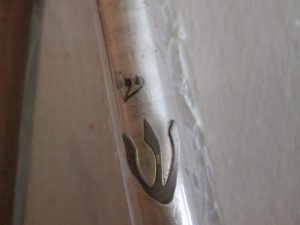 How come I am so ‘lucky.’ I get to follow Alex’s sprightly return-to-normalcy drash about spies or scouts, Sid Goldstein’s marvelously variegated and important Sof Newsletter, and Dina’s spiritual summary of what a return of a face-to-face with fellow congregants and with Torah for a service ‘from the heart’ can mean to all of us.
How come I am so ‘lucky.’ I get to follow Alex’s sprightly return-to-normalcy drash about spies or scouts, Sid Goldstein’s marvelously variegated and important Sof Newsletter, and Dina’s spiritual summary of what a return of a face-to-face with fellow congregants and with Torah for a service ‘from the heart’ can mean to all of us.
And I get to talk about Korah. Even his name causes shuddering. Korah, son of Izhar son of Kohath. Korah is not a name, it’s an anagram.
Yikes, this guy has what we Jews refer to as ‘Yikhes.’ He has pedigree — he is the great grandson of Levi, one of the original 12. As the wonderful line of Arthur Miller’s Death of a Salesman reads — ‘Attention must be paid.’
One gets the impression that these latest rebellions against Moses and Aaron are not impromptu. This situation has been building up and the two tribes involved, the timing and coordination of their mutiny, the justifications at hand, and the strength of their support are formidable. This is the last Torah description of the many great rebellions of the people, and it is tripled down. Korah and his Levites, Dathan, Abiram, and the Reubenites, and the Israelites themselves.
The Rabbis suggest that Korah challenges Moses about why he makes so many demands of the people. The demands make being Jewish too hard. One story is that Korah asks Moses whether a room full of Torahs would still require a mezuzah on the gatepost. Moses says ‘yes.’ Korah mocks that answer by saying that it is silly to think that a roomful of Torahs would need a mezuzah on its gatepost.
I like to give my own names to the sedrahs. I call this one ‘It’s personal.’ Korah is angry that his Levite clan’s entry into the priesthood has been usurped. Dathan and Abiram of the tribe of Reuben are angry that Moses has taken their primacy birthright and all the benefits that such entails from them. Many of the Israelites are angry at the treatment Korah received.
Moses and Aaron appeal to God. They have a fire pans show down. Korah calls on the whole community to support him. At this time, Moses dissuades them and most slip away. But those Reubenites who maintained the rebellion and Korah himself are “swallowed up into the earth.” Korah’s fire pan 250 are consumed by God’s fire itself. That’s called turning the tables or out of the fireing pan and into the fire! Then the people rebel in favor of Korah. In an ironic moment, Aaron has to save them.
The message is clear even if the story requires adaptation. The Jewish people will not be vanquished by others. Rather it is they themselves who will cause their own demise. Internal strife, insufficient learning, material obsession, private interest, and the failure to support Jewish ideas and institutions are the enemy. The failure to assume Jewish responsibility is the danger.
I hope that as I detailed a few points about this sedrah many of you were relating the information to what is happening in America and Israel today. Anti-Semitism is rising but that is not the major element of our Jewish future in America. Rather it is the Pew research report that our youth are not joining us in being Jewish. I cast no stones since my own failures in Jewish persuasion for my family seem to be coming too little and too late. And I watch the developments in Israel empty handed and empty headed. We can no longer merely challenge our internal rebellious people with a fire pan contest but somewhere some ideas, institutions, and programs must arise to call fellow Jews to arms about saving our heritage. What is it going to take and how are we going to do it?
On the positive side, I believe, is Sof Ma’arav. How fine it is that we preserved our marvelous traditions by adopting and adapting modern advances in communications, interaction, and cooperation. Much appreciation to the officers and the Board for their hard work and accomplishment. It’s personal.
Shabbat Shalom
Parsha Hukkat
June 28, 2021
Drash by Sandra Z. Armstrong

The continuing theme for Hukkat is separation, re-integration, separation and lustration.
Today, we are surrounded by the cleansing, purifying waters of the Pacific, our waters of lustration.
Our thirst for life is always quenched by living on an island surrounded by luscious, sparkling blue/green water and by meeting weekly as a Jewish Community.
We are of a Jewish nation, and as our tradition teaches, separated from other nations, sanctified by God through commandments.
To be holy is to understand that as God separated heaven and earth during the days of creation – we too must continue this creative path of becoming a solid people by adhering to our daily routines of distinguishing between pure/ tahor (טָהוֹר) — clean, pure from impure/tamei (טָמֵא).
For purity belongs to Heaven and impure is to be dealt with on earth.
In Hukkat, the point of distraction, as well as distinction is made over and over again-our goal is to be as pure as possible.
Rightly so, Hukkat stands/starts with the impurity of a body at death.
How to address this state of being for those who are still alive? How to clearly separate the pureness of living and the impurity involving death.
During the parsha, the Israelites were separated from water, they suffered greatly from thirst. The need to drink is so great that Moshe humanly strikes the rock without giving credit to HaShem for producing the water. At that very moment, his leadership was changed. He becomes separated from the deliverance of the Israelites into the promised land.
In Hukkat, his sister Miriam dies. She is the one who could draw water from barren wells in the wilderness. She rescued Moshe and placed him in the water among the reeds to save him from destruction.
His brother, Aaron dies and Moshe feels the continual pain and separation of his family dying.
The battles go on-between Edom, the Canaanties in the Negev, the Ammonites led by Sihon their king, to the fires of Heshbon, and onto King Og of Bashan. Some nations will not let them pass through and others just plain attack them. Hukkat tells us that despite the constant warfare, the Israelites succeed.
Moshe, as their leader, has the ability to move forward despite great losses and sorrow. So do the Israelites use this same model to move forward while learning to become a people created in the image of God. Strong, powerful, mighty. They separate from those who couldn’t do it, couldn’t make it spiritually within their nation.
As free people, they gain the identity of a nation who withstands pain, suffering, separations and many disappointments.
But they do something quite miraculous in this parsha, they pull it together and move ahead as HaShem leads them through more dangers with foreign nations.
And where do they end up in Hukkat? They end up at the top of the mountain, closer to the clouds of God’s presence in their midst. They survive and live. They are our people, they are our heritage, they have the spirit to strive for a better world and a better “makon”, place.
Throughout all their future conquests some – “One” ties their achievements all together.
Zechariah, 4:6 – Not by might, nor by power, but by my spirit, said the Lord of Hosts.
It is with My spirit that you will achieve the sanctity of peace, tranquility, blessings and hope into a heavenly future.
In God’s spirit may Congregation Sof Maʻarav continue to succeed, looking back to all our past achievements of the last 50 years, while looking forward at the same time, for they are equally important to all of us.
As this congregation, in the last 16 months has received the help and guidance needed to succeed and did it well!
Shabbat Shalom
Sandra Z. Armstrong
Drash on Parsha Sh’mini
June 6, 2021
By David and Beatriz Haymer
 Part 1: The Laws of Kashrut
Part 1: The Laws of Kashrut
Sh’mini is usually described as the Parshah containing the key instructions for the laws of Kashrut, specifically what may or may not be eaten. It does so, but this Parshah also starts with a continuation of details described in the previous Parshah regarding purgation and burnt animal offerings.
It is here that a startling event occurs when two of Aaron’s sons, Nadab and Abihu, while participating in the ritual offerings, make some sort of mistake involving “alien fire”. The exact nature of this mistake is not clear, but the consequences of it are – God sends forth a fire that instantly consumes them on the spot. Over the years, much has been written on this passage, but nevertheless, much about this event remains largely a mystery.
So, you might ask, why begin with an event that is so difficult to understand? Perhaps it is a sign that other things will follow in this Parshah that will also be difficult to explain or understand. This concept comes into sharp focus when talking about forbidden vs. permissible foods for eating.
To begin with, plants are easy – no restrictions, period. With animals, however, lots of specific rules are laid down. God says that we may eat anything that lives in water, except those things that lack fins or scales. We also know that some birds are acceptable because they are used in ritual offerings, but consumption of most other birds is not allowed. Insects are flat out forbidden, except that locusts, crickets and grasshoppers are given as an explicit exception.
Starting to see a pattern here? For every broad category of animal, there are both allowed and forbidden varieties. The rules drill down even further, drawing distinctions between animals that chew cud and have true hoofs which may be eaten vs those without true hoofs, even if they also chew cud, that are forbidden.
So, what really is the difference between an animal with a “true hoof” vs. one without? This is an example of another mystery because people don’t see how this can fit into any sort of rational system of classification.
I’m not at all bothered by it, however, because I know that all such classification schemes are subject to change. After all, going back to Genesis, when it is time to name all the animals in the garden of Eden, God commands Adam (meaning man) to name them. This naming forms the basis of taxonomy, the study of relationships that serves as a fundamental building block for all of biology. But, because man gives the names, man can change the names. Indeed, this is something that taxonomists do on a regular basis.
Part 2: Being Holy
This Parshah also contains a series of statements about holiness.
כִּ֣י אֲנִ֣י יְהוָה֮ אֱלֹֽהֵיכֶם֒
*For I the LORD am your God:
וְהִתְקַדִּשְׁתֶּם֙ וִהְיִיתֶ֣ם קְדֹשִׁ֔ים כִּ֥י קָד֖וֹשׁ אָ֑נִי
*you shall sanctify yourselves and be holy, for I am holy.
(And you will make yourselves holy, and you will be holy because I am holy)
וְהִתְקַדִּשְׁתֶּם֙ (V’hit kadishtem)
“And you will sanctify yourselves”, hit kadishtem is a reflexive verb, and it is also the mandate form. A reflexive verb is one in which the doer and receiver of the action is the same. God is commanding us to make ourselves sanctified, to be separate, set apart, distinct. The Hebrew reads “you will make yourselves holy. It’s not going to happen to us; we have to do it. We have to do it to ourselves.
Then, twice, in successive verses, God says וִהְיִיתֶ֣ם קְדֹשִׁ֔ים כִּ֥י קָד֖וֹשׁ אָ֑נִי
v’hitem kadoshim, ki kadosh ani
Sefaria translates this as “be holy”, but the original Hebrew actually says “and you will be holy because I am holy”. The future tense, you will, is used. We are being told “you will do this;” there is no option B or C.
וִהְיִיתֶ֣ם קְדֹשִׁ֔ים כִּ֥י קָד֖וֹשׁ אָ֑נִי – And you will be holy because I am holy.
But how do we make ourselves holy?! What does it mean “be holy”? Separate? Distinct? The theme of separation runs throughout Torah from Breshit when G-d separates light from the darkness and Shabbat from the days of creation, to G-d separating Abram from his ancestral context to a land unknown, to God taking the descendants of Abraham, Isaac and Jacob out of Mitzraim to be a people separate, different from all other peoples. These exemplify separation in states of consciousness, time, physicality, and practice. That is, separation in thinking, being, and doing.
The context in this Parshah where we are given these mandates of making ourselves separate and distinct, and being separate – that is, continuing to keep that distinction, revealed one answer to my question, “What does it mean to be holy?”
Here, God gives a guide for what we may consume to feed ourselves and those things that, in the words of Torah, will draw upon us abomination and make us unclean. We are given parameters for discerning what is acceptable and what is not. With these we can distinguish and separate that which nourishes from that which will pollute us.
We’ve often heard, when encouraging a healthy and wholesome diet, the adage, “You are what you eat.” Indeed, the vitamins, minerals, and other nutrients in the food we consume will be assimilated and integrated into our bodies. They become part of us, helping our body build or repair itself.
There are certain things that we can eat that may be “mmh… ono”; tasty; that smell and feel oh so good being eaten; but they do not contribute to the overall wellbeing, health and strength of our body. They will not help our body repair or renew itself. Not only do they not help our body function “Como Dios manda” (as God intended) but over time they will cause discomfort, distress, and ultimately disease.
That is what the list God gives here in Sh’mini is telling us; those forbidden things should not be considered nutrition. There are certain things we should not eat because, what we consume and what we come into contact with will determine our state of being. But let’s understand this beyond the pashat, the literal.
Looking for the “sod” I also ask myself, “What am I consuming in print, entertainment, thoughts, ideas, attitudes? Am I indulging in behaviors or negativity that initially feel oh so good but over time will be detrimental? Will exposure to or feeding on this uplift, nurture, heal, support or serve me?
So, why should we exert ourselves to be holy? G-d answered that before when telling us to be holy because He is holy: Ki ani Adonai Eloheihem: because Adonai is Eloheinu, our G-d. Our G-d is saying “because I am your G-d, the G-d of creation, miracles, and wonders; who took us out of Mitzraim; the final authority over life and death. Yes, that God!
God has given us guidelines. If I take care to discern, and then consciously choose that which revives, renews and repairs, I will be in a better position to be present for the others in my life.
May we all exercise the discernment God has given us, continually making wise, conscious choices, so we can live fully, intentionally, joyfully, and thus be a blessing to our closest others.
Drash on Parshat Naso
By Risa Dickson
 Naso is a parsha filled with what appears to be random and disconnected concepts and ideas. I’ve often heard that “real estate is expensive” in the Torah, and things arenʻt there by accident or randomly. So, as I read through Naso, it occurred me to that I don’t think we’re being told how to be a Nazirite, or really what to do if one thinks their wife is having an affair … only to throw in one of the most unique and important blessings in the Torah before getting back to specifics of the temple altar dedication. Rather than digging deeper, like I usually do in a drash, I’ve decided to pull up a bit and look at this from a more holistic and systematic perspective, to try and put some form and function around the larger picture of what might be going on here.
Naso is a parsha filled with what appears to be random and disconnected concepts and ideas. I’ve often heard that “real estate is expensive” in the Torah, and things arenʻt there by accident or randomly. So, as I read through Naso, it occurred me to that I don’t think we’re being told how to be a Nazirite, or really what to do if one thinks their wife is having an affair … only to throw in one of the most unique and important blessings in the Torah before getting back to specifics of the temple altar dedication. Rather than digging deeper, like I usually do in a drash, I’ve decided to pull up a bit and look at this from a more holistic and systematic perspective, to try and put some form and function around the larger picture of what might be going on here.
With that in mind, I invite you into my brain for a few minutes. The Parsha begins with a continuation of the census. A careful counting of the males aged 30-50 among the clans. Each clan is given their tasks within the Tent of Meeting and are resourced in a way that will enable them to complete these tasks. And after the odd twists and turns, the Parsha wraps up with a detailed description of each leader of the twelve tribes bringing their offerings for the inauguration of the altar. The inauguration of the altar. We are clearly at a powerful beginning for the Jewish people.
While the conversation on the census, and tasks, and resourcing and offerings seems relatively innocuous, what is happening is actually a shift in a model of leadership from a hierarchical God-like ruler to a distributed model in which leadership becomes a form of service: An extension of oneself in the service to something larger than ourselves. If we think about the contrast between Moses and the distributed responsibilities and authority of the clans vs. Pharaoh and slaves, we see a clear move towards a different model of organizing society. A society in which groups of people are given different areas of agency and power – all interwoven and dependent upon each other. I’ve noted before that physical reorganizations in the Torah are often accompanied by relational change between G-d and Israel. Wonder what’s going on here?
Next is a discussion of confession and restitution. While restitution is a theme with which I’m familiar, confession is really not part of my overall concept of Judaism. The discussion of confession and restitution led into one of marital infidelity and something that looks at first glance like a bit of witchcraft, whereby having a woman drink a potion will destroy her body image, render her infertile and potentially kill her, if she’s guilty. I recall a few years ago when I really heard this for the first time – I turned to Dina and said something sardonic like “Darn! I didn’t even earn these thighs and belly!” She looked at me (probably rolled her eyes) and said something like “That’s for young women!” But what an odd discussion in the middle of counting, organizing, and distributing power. Then there is the bit about how a woman would be compelled to drink a life-threatening potion because her husband was simply jealous? If there were no witnesses, and she was potentially innocent? What gives here?
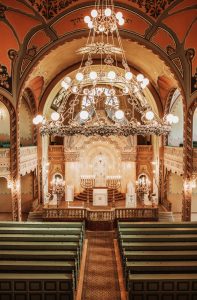 This then leads into an apparently random discussion of the Nazirite vow. I was interested to learn that, with the possible exception of Samson, the Nazirite vow was a time bound vow, and at the completion there are sacrifices – one for purification and one for well-being. This seemingly randomly strung together discussion then ends with the priestly blessing. Wow.
This then leads into an apparently random discussion of the Nazirite vow. I was interested to learn that, with the possible exception of Samson, the Nazirite vow was a time bound vow, and at the completion there are sacrifices – one for purification and one for well-being. This seemingly randomly strung together discussion then ends with the priestly blessing. Wow.
Let me punctuate here for a minute. What could all of these things possibly have in common? As I continued to ponder, it occurred to me that the relationship between Israel and G-d is often discussed as a marriage. And that as we left Egypt, G-d revealed himself in a different relationship with us, and one in which we were given the obligation of bringing God down to earth through our actions. And how each of the plagues was directed as a challenge at an Egyptian god. This was the last drash I did before Pesach.
We’re now being given instructions on how to set up the Tent of Meeting, how to inaugurate the altar, and we’re being given new roles – a structure for the relationships among the clans and between Israel and G-d. We are again negotiating a different space, a different relationship among ourselves and with G-d. At Sinai, G-d told us “Thou shalt have no other gods before me” – a potentially jealous husband? I did find some discussion in the Chasidic literature that the sotah (or unfaithful wife) may actually be an analogy for Israel. When the Jewish people have behaved as a sotah, they have then been tested with the bitter waters of galut (“because of our sins we were exiled from our land”). The Jewish soul is always called back to G-d. We may be persecuted, we may assimilate, but ultimately there is a moment which lays bare the question of who and what we are and our intimate and innate relationship with G-d is revealed.
Perhaps this is why the discussion of the Nazirite vow is discussed following the discussion of the sotah, and then followed by instructions to the Kohanim (Kahunas) of how to do the priestly blessing.
Behar Drosh
By Fran Margulies
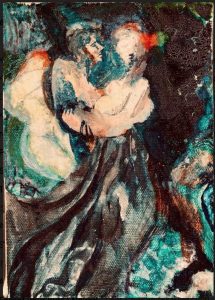 “When you enter the land I assign to you, the land shall observe a Sabbath of the Lord. Six years you may sow and prune and gather, but in the seventh year the Land shall have a Shabbat Shabbaton — a sabbath of complete rest, a sabbath of the Lord.”
“When you enter the land I assign to you, the land shall observe a Sabbath of the Lord. Six years you may sow and prune and gather, but in the seventh year the Land shall have a Shabbat Shabbaton — a sabbath of complete rest, a sabbath of the Lord.”
This shabbaton is also called elsewhere the Shmittah year. But we are not in Israel, and most of us do not plant all our food nor live off the land. So, as R. Goldfarb said: we should approach this command not literally but seriously. What can it mean for us?
Shmittah and Shabbat: The “shmittah year” is an expansion of the “Shabbat week,” not only because both the days and the years are counted in sevens but because both the words and their meanings are similar. Shmittah means release, for example “tishmetenah” in Exodus 23:10,11. Shabbat, as we know, means rest. Release, rest: similar ideas! Just as rest physically benefits me, my muscles, my body, my mind, so letting a field lie fallow, releasing it from work, so to speak, physically benefits it. The sodium in it is reduced and it becomes more fertile for the next crop.
But the two concepts of Shabbat and Shmittah also differ! Shabbat rest is what I do for myself. It is my taking my nap on Saturday and forgetting my work and worries of the week. Shmittah release is not about me as an individual but about my relationships, about mutuality. It is about me and the land: what I need from the land and what the land needs from me. It is about me and my servant or neighbor, about human interactions, about how I treat my servant and about what he owes me in return. Famously, Yom Kippur is decreed in this parshah. On Yom Kippur we release ourselves from guilt to others, from painful self-remorse, from festering grudges and unfulfilled vows.
So, fittingly, the content of our parshah moves from land management to people, to the humane treatment of Hebrew slaves and to their eventual release. And it did actually happen! I quote the historian Salo Baron: “The Hebrew slave began to disappear toward the end of the second Commonwealth. As rabbis took on more and more authority, a Hebrew servant suffering oppression could now invoke the protection of the courts. So that indeed in Palestine, there were no more Hebrew slaves” (Nahama Liebowitz, “Studies in Vayikra” p 274). But the lesson of Shmittah I most want to derive today is the need to occasionally loosen our forward momentum, to take a break from our incessant drive to control the world. The parsha BeHar Sinai is telling us that there are built in limits to all of our plans and ambitions. After all, God our creator could have made us completely subservient. But He restrained Himself! He pulled back enough to allow us to disobey him and even to reject him and disavow him … as we have so often done. He warns and he threatens and curses, but he gave us room! He gambled to allow for a more wonderful mutual relationship. Our freely acknowledging and praising him is a lot more gratifying than hearing the automatic praises of a puppet. He needed to trust us.
So too we must trust him. I return to the Shmittah plan. The farmers who would not grow anything in the 7th years and in the 49th year had to gamble they might not have enough to eat either that year or the next. Not planting or planning, letting go, meant they would have had to trust not in themselves but in God. God would provide! My takeaway from all this is a balanced approach to living, which I think is a very Jewish one. As Rabbi Milton Steinberg once said when he emerged into a sunny day from weeks of sickness: Life is so very beautiful, we must embrace it. But we must hold on to it with open arms.
Drash on Tsav (Command) Sedrah
May 1, 2021
by Mathew Sgan
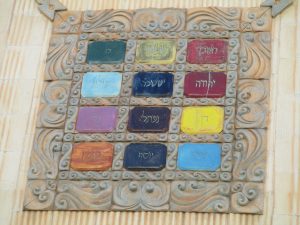 People tell me to start a drash with something humorous- But Sof jokesters like Naomi, Avi, and Gregg have used and punned all the material so I am going to give just the punch lines and rely on your memories for the build up of certain Jewish jokes-
People tell me to start a drash with something humorous- But Sof jokesters like Naomi, Avi, and Gregg have used and punned all the material so I am going to give just the punch lines and rely on your memories for the build up of certain Jewish jokes-
- He had a hat?
- Oh never mind, I found a parking spot – Forget about what I promised.
- Please next time choose some other group!
From the modern perspective it is easy, as so many of our fellow Jews like to do to find fault with all of the rituals and conditions found in this week’s sedrah. Moses is ‘commanded’ (tsav) to advise Aaron and his sons about various offerings, their conditions, and the right way of doing things. I tried to do a spread sheet to help us come to grips with all the actions taken by priests in the various offerings listed. I could figure out with the help of more than one reading and a few summary paragraphs that in this sedrah, there are eight offerings that can be distinguished. Each one is programmed, and I use that word defiantly according to who gets to eat or not eat the offering, when, where, and for what purpose.
As I said, trying to follow the directions for what the entire procedure involves is a special task even for one who is a Kohen, as I am lucky enough to be. What an inept priest I would have been had I been called upon to perform these priestly tasks some 3000 years ago. Anybody but Kohen Sgan, I can hear the family presenting the offering saying. And indeed, that’s the point, isn’t it. It was these rituals and the spirit and organization that they evoked that carried our ancestors through civil strife, spiritual malaise, wars with superior powers, exile, huge building projects, and continuing threats from rival belief systems and philosophies. A stiff-necked people indeed. We had to be then, and we have to be now.
In Tsav, it is the priestly class that gets most of the instruction. They are the ones who change their clothes to carry ashes. They are the ones who must be sure that the offering recipe and the ingredients are just so. They are the ones who bear responsibility for making sure the rituals mean more than the sum of their nutrition. The burnt, grain purification, and other offerings presented and described set the stage for the importance of offerings to the people. The last offering of the Sedrah goes beyond those presented by the priests. For the priests the offerings provide a professional and leadership status, and in doing so extend the meaning of offerings entirely. Not only do offerings have practical implications. spiritual significance, and dramatic presentations, they have devotional references for all the people.
Verse 21 of Tzav states, a sacrifice of well-being must be presented by him who offers his sacrifice of well-being before the Lord, his own hands shall present the Lord’s gifts. The last and best offering of this sedrah is not priests acting on behalf of their own influence, or the influence of their position. No, it is the offering of well-being which is given freely by the people – which is available to be eaten by everyone, and which is designed to establish a direct association between the people and the God they chose just as God chose them.
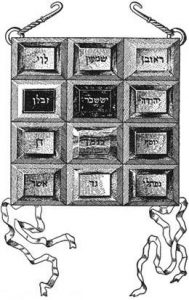 The priests and their actions have made a home for the lord in the midst of their nation, but the priests shall step aside while the people are in direct association with the Lord in their celebration of life and wellbeing. The priests have their roles and statutes, and the people support the priests, but in the last analysis, it is the obligation to be holy in the image of God’s holiness that directs the people. So it is, that when the sacrificial rituals no longer could be instituted, the Temple no longer existed, and the organization of Judaism was under existential threat, that the remnant of the priests and their Levite workers, along with the perseverance and belief of the people’s belief in and relation to God provided the strength, the knowledge, the background, and the code of Torah to enable Judaism to reestablish itself for an additional 2000 years of ongoing existence and fulfillment.
The priests and their actions have made a home for the lord in the midst of their nation, but the priests shall step aside while the people are in direct association with the Lord in their celebration of life and wellbeing. The priests have their roles and statutes, and the people support the priests, but in the last analysis, it is the obligation to be holy in the image of God’s holiness that directs the people. So it is, that when the sacrificial rituals no longer could be instituted, the Temple no longer existed, and the organization of Judaism was under existential threat, that the remnant of the priests and their Levite workers, along with the perseverance and belief of the people’s belief in and relation to God provided the strength, the knowledge, the background, and the code of Torah to enable Judaism to reestablish itself for an additional 2000 years of ongoing existence and fulfillment.
In the Tsav sedrah we have a foundational statement that led to the Holiness code of Leviticus; the miracles of the wilderness of Numbers; and the recap of Moses, as well as the shema of Deuteronomy. Tsav reflects Jewish thought which has added meaning to human existence, provided a divine moral compass, and insisted on equality before the law, dignity of the person, and social responsibility. Judaism promulgated the very concept of peace.
Today we seek sophisticated answers to our quest for a better world. Science, space technology, and competing ideologies threaten our day-to-day reverence. At the same time, from week to week, from sedrah to sedrah, we come to understand that our personal conduct, our way of living, our prayer and study, add up to the continued importance of Judaism to the world and, in turn, to the dependence of Judaism on the whole panorama of its own history, rituals, guidelines, and practices.
Drash on Parsha Kedoshim
April 24, 2021
By Avi Soifer
Rocks and Roles [and Rules] for the Chosen People
As usual, I have three main themes: 1. A Hard Place; 2. Amos; 3. Kedoshim
They suggest concentric circles in both our empathy and in our law.
But I begin with a lingering question. Why in the world is it Jewish custom to start kids with Leviticus as they begin to study Torah?
Even if the kids get some honey for their troubles, it makes no sense to plunge them into excruciating details about sacrifices, mandatory gymnastics for the high priest and his family, and a whole lot of things that are forbidden that children don’t begin even to understand.
Today we have combined parshot:
Achrei Mot: After the deaths of Aaron’s sons—lots of duties, lots of bathing and wearing linen—said by some rabbis to be a tribute to women, but who is washing all that?
[I think it is time for a reprise of Kay’s legendary drash in which she demonstrated the high fashion of the high priest’s outfit]
Many sacrifices are described in detail; goats are divided and one is sent to Azazel and Yom Kippur rites and responsibilities are specified, as are the duties of those wishing to make sacrifices. We also learn of many folks whose nakedness should not be seen by other folks, and even who should not sleep with who [or whom?]
It’s all still a little cloudy, yet preserved for eternity—or at least a long time—in the Cloud. Nonetheless, this parsha certainly does not rock out and you can’t really dance to it.
But there are rocks to discuss. Moshe and rocks, for example: if only Moshe had learned to use only words at his Pre-K (pre-Kedoshim] class in Pharaoh’s Court.
And remarkably we learned earlier this month of a leading current theory that some very large sauropod dinosaurs unknowingly transported rocks in their bellies from Wisconsin to Wyoming: over 1000 miles. (NY Times, 4.9.21)
Another example in nature, perhaps. of Rabbi Heschel’s “Radical Amazement?”
- The Jews as the Chosen People
“How Odd/ Of God/ To Choose The Jews”(Ogden Nash)
One legend has it that Jews accepted the chosen people assignment only when God held a huge rock [actually more a mountain] over the heads of the Israelites to “convince” them/us to agree to take on the Torah.
This echoes, in a somewhat round-about way, the opening lines of the portion of Amos, the Haftarah that generally accompanies Kedoshim.
Amos more than once is keen to remind the children of Israel that they are not so special after all.
Or, as my late lefty great aunt Rasel liked to say: “Not so hotsie totsie”
| Amos: described himself as simply “a cattle herder and a keeper of sycamores” and resisted the assignment to be a prophet pretty vigorosly—The Book of Amos emphasizes the gap between rich and poor, and condemns devotion to luxuries and mere forms of devotion; in fact, his prophesy rivals the curses in Moses’s final message near the end of Deuteronomy.
Because Amos lived around 750 B.C.E., he might even be considered prophetic because exile followed nearly 200 years later. Thus, says Amos: “Only you did I love above all the families of the earth; therefore, I will visit upon you all your iniquities.” (3.2) |
||
| But also, as Gayle read in today’s Haftarah:
“Are you not like the children of the Cushites to Me, O children of Israel? says the Lord. Did I not bring Israel up from the land of Egypt, and the Philistines from Caphtor and Aram from Kir?” (9.7) So how to remain or become God’s chosen people? An easy answer might be to follow the law. But what law? After all, we are encircled by law. We have, for example, the written Torah and also the oral Torah, and we also have minhag –custom—which intrigued Rabbi Goldfarb and which, remarkably, can at times take precedence over even what the Torah explicitly says. |
||
- Kedoshim
I signed up for this particular drash because it was Amira’s Bat Mitzvah drash: Memorably, in not an entirely neutral voice, she proclaimed: “Dad: Where are my last pages?” In fact, though I was innocent, Amira ad-libbed beautifully.
Her parsha was also my father’s and, one may hope, possibly that of Samuel Benjamin, who became one year old last week and thus was born in the right time frame.
Being the “Chosen People” obviously has had its numerous trade-offs over the millennia: In a way, it is like being assigned or chosen to be a juror or a judge in a very important case.
What should these roles entail?
- That core question—judge within the law or judge within righteousness?–It remains an important theme, even today. I have talked before about Bob Cover’s great work on antislavery American judges who nonetheless returned Blacks to slavery, all the while protesting that they had no other choice. Cover suggested that this may have been cognitive dissonance, but they did the deed in the name of the law.
There is a description of God as a judge in the Torah—basically echoes Kedoshim, but we are assured in addition that God does not take bribes—so would/could bribe God? And our prayers, for instance on Yom Kippur “to avert the severe decree” are…?
What does Kedoshim suggest?
That we are to follow the law and/or to do justice?
Perhaps to be neutral, to be impartial?:
But how impartial do we want or can we expect a legal decision-maker to be?
[Hawaiʻi and mixed jury in 19th century: half Chinese, half white, etc.]
“They say in Harlan County/ There are no neutrals there.” Labor wars of the 1920s and 1930’s
As Archbishop Desmond Tutu put it: “If you are neutral in situations of injustice, you have chosen the side of the oppressor.”
[He added: “Do your little bit of good where you are; it’s those little bits of good put together that overwhelm the world.”]
For all my skepticism about young children studying Leviticus, Kedoshim in Chapter 19 offers a remarkably interesting and rich array of themes :
Leave the edges of the field for the poor; harvest and use the fruit of a young tree only in the tree’s fifth year; don’t eat blood (or leftovers after the third day), etc.
And:
| 13 Thou shalt not oppress thy neighbour, nor rob him; the wages of a hired servant shall not abide with thee all night until the morning. | |
| 14 Thou shalt not curse the deaf, nor put a stumbling-block before the blind, but thou shalt fear thy God: I am the Lord | |
| 15 “You shall not render an unjust judgment; you shall not be partial to the poor or defer to the great: with justice you shall judge your neighbor.” |
[ You shall not go around as a slanderer among your people, and you shall not profit by the blood of your neighbor: I am the Lord.” (Lev. 19:15-16)]
And the verse said to be the core of the entire Torah:
19.18 Thou shalt not take vengeance, nor bear any grudge against the children of thy people, but thou shalt love thy neighbour as thyself: I am the LORD.
And who is that neighbor?
19:34 The stranger that sojourneth with you shall be unto you as the home-born among you, and thou shalt love him as thyself; for ye were strangers in the land of Egypt: I am the LORD your God.
EMPATHY/PROTECTION as central theme– Martha Minow: Making All The Difference: It is a matter of perspective, and we are the makers as well as the perceivers of difference
And a recent New Yorker cartoon:
Jubilant children of Israel crossing the dry land where the Red Sea parted. And one fish to another inside a huge wave on one side of the dry land, while the rest of their school of fish is swimming on the other side: “Now, I’m going to be late to work.”
Hierarchy and binaries would probably make life easier, but—blessedly—we live within concentric circles
Faulkner: “Whoever wins, it won’t be for good and it won’t be for long.”
W.C. Fields, upon being seen reading a bible: “Looking for loopholes”
Parasha Tetzaveh
March 27, 2021
by Morris Rabinko
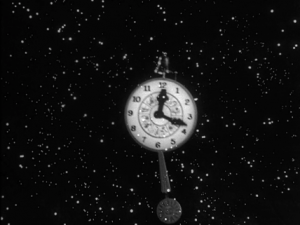
“You are about to enter another dimension, a dimension not only of sight and sound, but of mind. A journey into a wondrous land whose boundaries are that of imagination. That’s the signpost up ahead – Your next stop” . . . my drash.
Imagine, if you will, a rock in the middle of the ocean. Its name – Oʻahu. And imagine that by some strange twist of fate, three unrelated individuals, each a generation apart, find their way to this rock from thousands of miles away from a place we call – “New York,” a place with more than 2,000 high schools, but as it turns out, our three individuals attended the very same high school, a high school named the Bronx High School of Science, known by some as Bronx Science, and simply called “Science” by those who attended it. And imagine that these three graduates of Science, unknown to each other, not only ended up on Oʻahu, but perhaps by coincidence, or perhaps by fate or some other force at work, found themselves members of the same small Jewish congregation, a congregation known as Sof Ma’arav.
Well, my drash today is not the story of these three individuals – although I happen to be one of them, along with Marv Black and Brandon Wallis. No, my interest today is in the meeting of science and religion. Our parasha today, Tetzaveh, moves on from last week’s detailed description of the construction and furnishing of the mishkan (sanctuary) and the aron (ark), to an equally detailed description of the garments that the kohanim who preside should wear. Not being a fashionista myself, as I read the parashah trying to find my way to a drash, I felt like a ship at night, battered in stormy seas by wave upon wave of breastplates, ephods, headdresses, gems and stones, sashes, linens, and yarns, when a light beckoned to me in the darkness.
It was the Ner Tamid, usually translated as the Eternal Flame or Light, that HaShem instructed should be hung in the Ohel Mo’ed (the Tent of Meeting) outside the curtain that is over the ark. Our Etz Hayim indicates that this is the source of the Eternal Light that hangs above the ark in the synagogue to this day. This appears in Exodus 27:20, page 503 in Etz Hayim as translated therein, “You shall further instruct the Israelites to bring you clear oil of beaten olives – lama’or, l’ha’alot ner tamid – for lighting, for kindling lamps regularly.” Here, l’ha’alot ner tamid is not translated as “kindling the Eternal Flame,” as some translations do, but as “kindling lamps regularly.” I think this translation, as well as some that say “continually” instead of “regularly,” is truer to the original intent, as there are other words for eternal, such as lanetzach or l’olam (from the root alam – to hide, conceal, i.e., that which is beyond what we can see or know). Although the Ner Tamid may well signify HaShem’s eternal holy presence over the ark, the word Tamid is more focused on human action, the regular or continual act of keeping the fire burning, that the translation “eternal light” would not convey.
But what was it that attracted me like a moth to the flame of the Ner Tamid? Perhaps it’s that the words refer to time and light, which are both very central to Judaism. Regarding the role of light, besides the Ner Tamid we light nerot, candles, every Shabbat and on holidays. Etz Hayim explains beautifully what it is that makes light “such a favorite symbol of God:” “Perhaps because light itself cannot be seen. We are aware of its presence when it enables us to see other things.” “Similarly, we cannot see God, but we are aware of God’s presence when we see the beauty of the world, when we experience love and the goodness of our fellow human beings.”
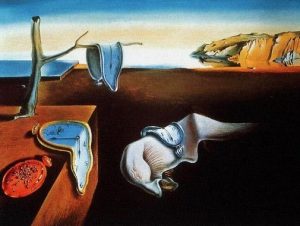
For the central role that time plays in Judaism, I turn to the words of Abraham Joshua Heschel, in his book The Sabbath, “Judaism is a religion of time aiming at the sanctification of time.” Regarding our ritual observances of the Sabbath, the New Moon, and the festivals, Heschel calls them our “architecture of time.” “The Sabbaths are our great cathedrals” and the Day of Atonement is our “Holy of Holies” that our enemies cannot burn down. And, Heschel writes, “Judaism teaches us to be attached to holiness in time.” He points out that the first time the word Kadosh, holy, is used in the Torah is in Genesis, where at the end of creation “God blessed the seventh day and made it holy.”
What I would add to Heschel’s description of time, is that like the previous description of light as something that we cannot see, we cannot see time either. It’s interesting to note what St. Augustine, the philosopher and Christian theologian, said of time: “if you don’t ask me, I know what it is, but if you ask, I don’t know.” And like we are aware of light’s presence by its enabling us to see other things, we are aware of time through the changes of other things. Aristotle in fact described time just like that, as the measure of change or motion. (And incidentally, the root of the word Tamid is probably related to the Hebrew word limdod, meaning “to measure” based on the root mud). And as light enables us to see God’s presence in the beauty of the world, we can see God’s presence in the change and creation all around us. In fact, that is how we usually understand God’s telling Moses on Mt. Sinai that Moses cannot see His face but only His back. It is through the trail that God leaves behind of change in the world that we can see his presence.
 Given this connection of Judaism to time and to light, just as I wondered if it was just a coincidence that brought Marv, Brandon and me to Sof Ma’arav, is it a coincidence that it was a Jew, Albert Einstein, who upset long held views on the nature of time and light. Before Einstein, the Aristotelian view of time as a measure of change evolved into Newton’s “clockwork universe” in which time and space were viewed as fixed and absolute. Einstein came along and showed in his general relativity that, in fact, time and space are relative, dependent on the velocity of the observer. And the speed of light, which, in a Newtonian understanding of the universe, would be measured as faster or slower depending on the frame of reference of an observer, i.e., the relative speed and direction of the observer’s motion, was determined in Einstein’s universe to be, counterintuitively, fixed and absolute, unchanging regardless of the velocity and direction of the observer.
Given this connection of Judaism to time and to light, just as I wondered if it was just a coincidence that brought Marv, Brandon and me to Sof Ma’arav, is it a coincidence that it was a Jew, Albert Einstein, who upset long held views on the nature of time and light. Before Einstein, the Aristotelian view of time as a measure of change evolved into Newton’s “clockwork universe” in which time and space were viewed as fixed and absolute. Einstein came along and showed in his general relativity that, in fact, time and space are relative, dependent on the velocity of the observer. And the speed of light, which, in a Newtonian understanding of the universe, would be measured as faster or slower depending on the frame of reference of an observer, i.e., the relative speed and direction of the observer’s motion, was determined in Einstein’s universe to be, counterintuitively, fixed and absolute, unchanging regardless of the velocity and direction of the observer.
We know from very accurate atomic clocks sent into space that the faster they go the slower time moves relative to a clock that remains on Earth. This slowing down of time is known as “time dilation” and, in fact, GPS navigation systems rely on algorithms to compensate for time dilation effects due to the speed of the satellites as they need to keep accurate time in relation to Earth-based clocks in order to correctly pinpoint positions. This is very real and the basis of the so-called “twin paradox,” whereby a twin sent into space on a high-speed voyage accelerating to speeds approaching the speed of light could return to Earth having aged 5 years, to find his twin who remained behind on Earth aged, say, 50 years.
 So what is my take-away from this meeting of science and religion, from what Einstein teaches us about the nature of time and light vs. what the Torah might be telling us? I start from the point of view of a massless photon – if a photon could have a point of view – traveling at the speed of light. Time within its frame of reference is unchanged as it travels light years from one end of the universe to another, arriving at the same time it left, in no time at all, while the rest of the universe has aged millennia.
So what is my take-away from this meeting of science and religion, from what Einstein teaches us about the nature of time and light vs. what the Torah might be telling us? I start from the point of view of a massless photon – if a photon could have a point of view – traveling at the speed of light. Time within its frame of reference is unchanged as it travels light years from one end of the universe to another, arriving at the same time it left, in no time at all, while the rest of the universe has aged millennia.
That imagery reminds me of Moses standing at the burning bush. Moses is standing on holy ground in the presence of HaShem. The bush is burning and emitting light, but the bush is not being consumed. We immediately know that Moses is “not in Kansas anymore.” But where, or when, is he? Has time stopped or is he outside of time? Does being in the presence of HaShem mean to be outside of time? This provides me a different way of thinking of the Shabbat. Within our referential frame – our home, the synagogue, our eruv? – everything seems the same, but the outside world has stopped. We do no work, because work is change, and change is time. We are outside of time in the presence of HaShem.
I think of the Zen koan, of the two monks arguing on the bridge as to whether the water is moving under the bridge or the bridge is moving over the water. The Master comes by and they ask him to resolve their argument, and he responds, “It is the mind that moves.” In a similar way, I see time as how our mind perceives the world, but we can change our perception by separating ourselves from the rest of the week. From this new point of view, Shabbat is not just a holy time of the week, it is a hole in time, that we create to be close to HaShem, outside of time. So perhaps on Shabbat we should imagine ourselves hitching a ride on a photon and see where it takes us. And I think I’ve already succeeded because I’m out of time. “Second star to the right and straight on till morning.”
Vayak’heil – Pikudei
March 13, 2021
by Naomi Olstein

As a people, we Jews have a ritual or a ceremony for practically everything. We are a punctilious people. (dictionary definition: careful and conscientious; meticulous attention to detail; showing great attention to detail). Where did we develop this character trait? One of the places is in this week’s parsha. Vayak’heil – Pikudei is a double portion that concludes the Book of Exodus. The paired Torah portions describe the building of the Tabernacle and the anointing of the priests. The parshiot primarily contain many verses of detailed plans and descriptions of rituals, some of which may be hard to visualize sitting in such a different world today.
The construction and use of the tabernacle as a symbol of the realization of Israelite peoplehood is a powerful model for us today.Rabbi Mordechai Yosef of Izbica, who lived in the 19th century, writes, “In the building of the Tabernacle…at first, each skilled individual did his/her own part of the construction, and it seemed to each one that his/her work was extraordinary. Afterwards, once they saw how their several contributions to the “service” of the Tabernacle were integrated — all the boards, all the sockets, all the curtains and all the loops fit together as if one person had done it all. Then they realized how each one of them had depended upon the other.” So too, today we each play an ongoing role in building and maintaining our own communities (like Sof Ma’arav). That service never ends.
Parsha Vayak’heil – Pikudei and the book of Exodus teach us about the power of community — of how important and how hard community building can be. While the patriarchs/matriarchs laid the foundation for Israel’s development, it isn’t until Moses and G-d reveal their relationship to the public that the Israelites begin to solidify as a people. Exodus follows the transformation from a Hebrew family to the Israelite people and nation. Exodus reminds us that for all the challenges of living as part of Am Yisrael, the people of Israel, it is not a static but rather a transformational force propelling us to the promise of a better world and of liberation for us all. Each Pesach, we look forward again to reading about leaving Mitzrayim and finding freedom. That will be here quite soon, in about 2 weeks (March 27).
In preparation, I recommend consulting a compendium of delicious recipes and punctilious instructions for preparing for the holiday, called “THE when you live in HAWAIʻI you get very creative during PASSOVER COOKBOOK.” I’m not sure if there are any hard copies available for purchase. Maybe there might be digital copies in our future. I added some details to my copy that I borrowed from a book entitled “Is it Kosher?” After clearing all Chometz out of your home (next week), “Burn chometz and make the following declaration: ”All chometz and leaven in my domain which I have seen and which I have not seen, which I have destroyed and which I have not destroyed, of which I have knowledge and of which I have no knowledge, shall be nullified and hefker (renounced property) like the dust of the earth.”
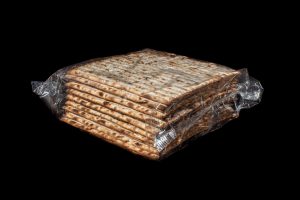
Drash on Parashat Ki Tisa 5781
March 6, 2021
by Malka Rappaport

To begin, I want to express my immense gratitude that God gave me not one, but two in-house Torah scholars (my incomparable parents) for me to turn to when I need some help distilling my ideas for d’rashot (as I very much did this week). So, ima and aba, thank you so much for giving me a solid foundation in Torah and preparing me to carry on the family business–as it were.
Of all the events in this week’s parasha ki tisa, there is one in particular with which I
know you’re familiar and one that is particularly uncomfortable. That is, of course, the episode of the Golden Calf. This is a story we have told and retold, so much so that its mark upon us is indelible. Oddly enough though, there are some details about this story that I think often get overlooked. As I scoured the words of this parasha in preparation for today, I really began to wonder about that. So that’s what I want to explore today.
As you may recall, the Golden Calf is serious because of what it represents. The whole
debacle surrounding its construction and subsequent worship is our deep dive back into the very idolatry that had nearly consumed us in Egypt. And after all, if we’re not on board with the whole one-God-only idea, the rest of the Jewish project is a bit of a no-go, right? That being the case, you might expect Torah to use particular language in the description of this event. For instance, the word עברה (aveira). Though often translated generally as ‘sin,’ the root of עברה (ע.ב.ר) actually means to cross over something –like a boundary. Thus, עברה is better translated as ‘transgression.’ Likewise, the word עוון (avon) will sometimes be casually translated as sin, but the root of this word (ע.ו.נ) actually means ‘crime’ or ‘offense.’
Thus, it would make sense that Torah would use at least one of these words to describe the actions of b’nei Yisrael with regard to the Calf. Does it? No. Torah uses the word חטא (het) -het, tet, alef –and עברה (aveira) and עוון (avon) are nowhere to be found. Now, the word חטא (het) definitely falls under the general category of ‘sin,’ but as you may know, חטא means, to miss something –like missing the mark. So how does that square with the gravity of this whole episode? After all, we know that God was so angered by this whole thing as to say to Moshe, ‘Never mind, I’ve had it with these people! I’m going to start over with your descendants.’
There’s an interesting gap that often occurs in the retelling of this story. That is, there
tends to be a gap between the initial Calf Incident and the reconciliation which the building of the mishkan represents. We obviously know how the narrative ends, and because of that our impulse in talking about this puzzling –perhaps even painful –incident is to skip straight to the nechemta (the consolation). The thought that God might actually have destroyed our ancestors is altogether too uncomfortable to really consider. But Torah presents us with no such gap, and we do ourselves a disservice if we simply skip ahead to the happy ending in our retelling. Yes, it is part of human nature to be averse to discomfort; the truth is though, that we learn the most about ourselves and life when we have the courage to be present with that discomfort.
The fact is that the resolution between us and God doesn’t come right away. In fact, there were some pretty harsh consequences for our actions –consequences we read about just a few minutes ago. For one, God sends a plague upon the Israelites. Torah doesn’t elaborate as to how many people died from it, or when it stopped (or how it stopped, for that matter), only states that it happened. Not only that, in a bizarre act of civil-war-esque violence, the Levites rally behind Moshe and go from gate to gate in the Israelite camp, killing some three-thousand people that had been involved in the Calf Incident. Finally, God tells Moshe to relay this message to us: רֶ֧גַע אֶחָ֛ד אֶֽעֱלֶ֥ה בְקִרְבְּךָ֖ וְכִלִּיתִ֑יךָ “if I were to go among you for even a moment, I would destroy you.”
Here we are, on our way to Israel –the land that God promised to Avraham, Yiztchak, Yaakov and their descendants –and God is telling us that we can no longer have a close relationship. This, to me, is the worst consequence of the Golden Calf; it represents a rift in our relationship with God that, after the ecstatic events of the initial Revelation at Sinai, must have seemed like utter desolation. In fact, Torah tells us that our ancestors were devastated and that they actually went into mourning.
This dissonance can resonate strongly –maybe sometimes too strongly. Haven’t we all
encountered a situation where we find ourselves hopelessly wondering how we will ever pick up the pieces? How will things ever be right or good again? While part of us likely maintains that better days lie must ahead, the way to get there is obscured by the fog of our dismay. Where do we go from here?
Well, you may recall that a few parashiot ago in בוא (Bo) Torah tells us וְגַם־עֵ֥רֶב רַ֖ב עָלָ֣ה
אִתָּ֑ם, that there was also a mixed multitude of people that came with us out of Egypt. Who were these people? And why did they come with us? More likely than not, they were non-Israelites, which means that they brought with them customs and beliefs that were incompatible, to say the least, with ours. Was it they that died in the mysterious plague? Or maybe the Levites slaughtered them? To modern sensibilities, the thought that there was a literal slaughter is basically untenable.
So, let me give you a metaphor: If our slavery in Egypt stands for spiritual confusion and lostness, then the “mixed multitude” becomes a metaphor for all the beliefs that no longer served us. We didn’t know we’d brought them with us because until the catalyst of the Golden Calf we were unconscious of them. Sooner or later these beliefs needed to be dealt with, because they were totally incompatible with the spiritual work God required of us. How often is it in our own lives that we realize what kind of toxic beliefs we’re holding onto only in the wake of painful mistakes?
Which brings us back to the word חטא (het). The Golden Calf was a mistake and though I argue in defense of our ancestors that it was done with total innocence, there was still the fallout to be dealt with. The mixed multitude of toxic beliefs had to be cleared from our midst before we could progress forward. After all, where is the room for God in our lives if so much space is being taken up by that which no longer serves us?
My friends, I truly hope that we are at the end of this long, heartbreaking, separation
from each other. And I believe that we have a tremendous opportunity here to take stock of the things that were part of lives before this pandemic that really no longer serve us going forward. True, sometimes changes come into our lives that we do not desire, and for which did not ask. And yet –even despite that –there is always room us to create something positive in due time from whatever fallout the change brings.
In a few weeks we, ourselves, are going to be leaving Egypt, and we have the incredible gift of knowing ahead of time that we’re leaving. Unlike our ancestors, this isn’t something that will be sprung upon us in the dead of night. Learning to be close to God isn’t easy work. But it is, possibly, the only work that is worth doing in life, and there are many, many avenues we can use to accomplish this.
Though the resolution to these intensely uncomfortable times in our lives may not yet be fully realized, now we can –indeed we must –ask ourselves, what kind of things we’re bringing into the future with us. While we, ourselves, are not making amends for some communal sin here in 2021 we do have the opportunity to construct a kind of mishkan that maybe we wouldn’t have considered before all of this. The point is that now is the time for us to draw close to God in our own lives. Closer and closer, because that closeness is what will ultimately propel us into our next phase of existence together –into a future that we may not have foreseen and that is entirely possible now. Shabbat shalom.
Community and a Day of Rest
March 5, 2021
B’Shallach Drash by Marlene Booth
How do you build community when there are no rules, no slave masters, no roadmap about where you’re going, how you’ll get there, whom to follow? How do you forge community and build shared memories to replace slavery in Egypt? What does it mean to see and experience life together at the same time? When Parshat B’Shallach begins, the primary action is, of course, the crossing of the Red Sea, a collective action that’s hard to beat.
 To prepare for this drash, I thought I’d go directly to an original text, the 1956 movie, The Ten Commandments directed by Cecil B. DeMille. In this movie whose special effects are laughable, Charlton Heston as Moses, stretches out his arms and the sea parts, with the Jews kvetching on and off during this action. As embarrassing as it is, when I saw the movie as an 8-year-old, I was overwhelmed and proud to be Jewish! In parshat B’Shallach, the first and most monumental experience the people share is the parting of the Red Sea, when the Israelites march through on dry land.
To prepare for this drash, I thought I’d go directly to an original text, the 1956 movie, The Ten Commandments directed by Cecil B. DeMille. In this movie whose special effects are laughable, Charlton Heston as Moses, stretches out his arms and the sea parts, with the Jews kvetching on and off during this action. As embarrassing as it is, when I saw the movie as an 8-year-old, I was overwhelmed and proud to be Jewish! In parshat B’Shallach, the first and most monumental experience the people share is the parting of the Red Sea, when the Israelites march through on dry land.
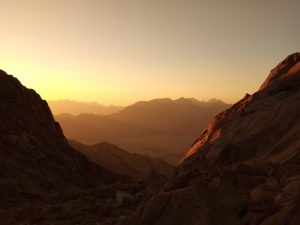 The Torah tells us, in chapter 14, verse 31, that after the Israelites are safe on dry land, they “saw the big hand (arm) that Ha’shem wielded against the Egyptians and they feared Ha’shem and believed in Ha’shem and his servant Moshe.” This fear and belief come after the actions of seeing and marching through the dry land. The Israelites live through and witness a monumental action together. At that point, in gratitude and amazement, Moshe and the Israelites together sing the Song of the Sea. And then they wander. As they wander, they are thirsty and want to drink the water they find, but the water is bitter. Moshe cries out to Ha’shem, a piece of wood appears, Moshe throws it into the water, and the water becomes sweet.
The Torah tells us, in chapter 14, verse 31, that after the Israelites are safe on dry land, they “saw the big hand (arm) that Ha’shem wielded against the Egyptians and they feared Ha’shem and believed in Ha’shem and his servant Moshe.” This fear and belief come after the actions of seeing and marching through the dry land. The Israelites live through and witness a monumental action together. At that point, in gratitude and amazement, Moshe and the Israelites together sing the Song of the Sea. And then they wander. As they wander, they are thirsty and want to drink the water they find, but the water is bitter. Moshe cries out to Ha’shem, a piece of wood appears, Moshe throws it into the water, and the water becomes sweet.
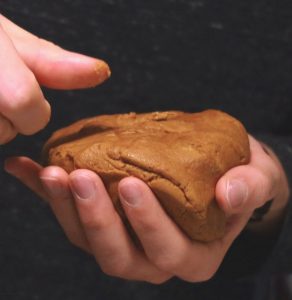 For a second time, the people witness together a great deed. Ha’shem asks in response through Moshe that the Israelites heed his commandments. And then they get hungry and want food and Ha’shem provides manna. And this is where the act of seeing and doing begins to manifest toward building community. Moshe tells the Israelites to gather a double portion of manna on the 6th day, but they do not listen to him, and they leave manna out without preparation and it stinks and becomes infested with maggots. He tells them again to gather a double portion on the 6th day, to leave it aside prepared for the 7th day, and this time they listen. So they see what Shabbat is, they experience a day of rest before it is commanded to them at Sinai. They have lived Shabbat, and so the commandment at Sinai makes sense.
For a second time, the people witness together a great deed. Ha’shem asks in response through Moshe that the Israelites heed his commandments. And then they get hungry and want food and Ha’shem provides manna. And this is where the act of seeing and doing begins to manifest toward building community. Moshe tells the Israelites to gather a double portion of manna on the 6th day, but they do not listen to him, and they leave manna out without preparation and it stinks and becomes infested with maggots. He tells them again to gather a double portion on the 6th day, to leave it aside prepared for the 7th day, and this time they listen. So they see what Shabbat is, they experience a day of rest before it is commanded to them at Sinai. They have lived Shabbat, and so the commandment at Sinai makes sense.
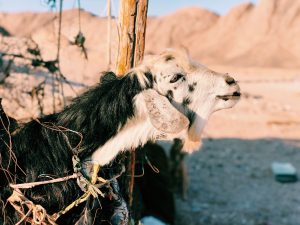 How do you make Shabbat concrete, how do you explain a day of rest when there has never been a day of rest for this formerly enslaved and now wandering people? The moment at Sinai has not yet occurred. How will they understand the commandment about Shabbat without the experience of Shabbat? And then, once again, the Israelites are without water and they kvetch. Moshe, following Ha’shem’s direction, uses his rod to strike the rock at Horeb, which is another name for Mt. Sinai, and water springs forth. So, the Israelites again together witness and see another sign of Ha’shem’s presence and majesty. Why are these actions important? The parting of Red Sea, the sweetening of the waters which were bitter, the gathering of a double portion of manna on the 6th day which does not go bad on the day of rest, and the production of water at Horeb are all actions that help the Israelites to forge a collective, and begin to build a shared history of their wanderings.
How do you make Shabbat concrete, how do you explain a day of rest when there has never been a day of rest for this formerly enslaved and now wandering people? The moment at Sinai has not yet occurred. How will they understand the commandment about Shabbat without the experience of Shabbat? And then, once again, the Israelites are without water and they kvetch. Moshe, following Ha’shem’s direction, uses his rod to strike the rock at Horeb, which is another name for Mt. Sinai, and water springs forth. So, the Israelites again together witness and see another sign of Ha’shem’s presence and majesty. Why are these actions important? The parting of Red Sea, the sweetening of the waters which were bitter, the gathering of a double portion of manna on the 6th day which does not go bad on the day of rest, and the production of water at Horeb are all actions that help the Israelites to forge a collective, and begin to build a shared history of their wanderings.
 In a related way, we’ve been wandering during COVID. These past 10 months, we’ve all been trying to find our way. And in the midst of this uncertain time, we have our weekly Zoom shul that builds collective memories and binds us together. We see each other – virtually – and, led by the extraordinary Sandy, we keep an eye on one another, and we check in and share not only the service but the good and the difficult in our lives. Sandy brings us together with her very kind comments – this extends also to Sofers who don’t do Zoom shul – that let us know that we are being seen and heard. When we once again return to in-person davening – ee’m yeertzay ha’shem – we’ll have the memories of Zoom shul to strengthen our next step. And lest we forget, Sandy will enthusiastically remind us of how extraordinary we are to move forward. Y’chi hey’dad! Kadima!
In a related way, we’ve been wandering during COVID. These past 10 months, we’ve all been trying to find our way. And in the midst of this uncertain time, we have our weekly Zoom shul that builds collective memories and binds us together. We see each other – virtually – and, led by the extraordinary Sandy, we keep an eye on one another, and we check in and share not only the service but the good and the difficult in our lives. Sandy brings us together with her very kind comments – this extends also to Sofers who don’t do Zoom shul – that let us know that we are being seen and heard. When we once again return to in-person davening – ee’m yeertzay ha’shem – we’ll have the memories of Zoom shul to strengthen our next step. And lest we forget, Sandy will enthusiastically remind us of how extraordinary we are to move forward. Y’chi hey’dad! Kadima!
A Mishpatim Drash
March 2, 2021
by Sandra Z. Armstrong
Today’s drash is dedicated to Sof Ma’arav’s newsletter, to our entire congregation for all their submissions, to Sid Goldstein, LynleyShimat Lys and Lorna Holmes.
Regarding our celebration on Shabbat today, I remember that Rabbi Abraham Joshua Heschel once remarked:
“People of our time are losing the power of celebration. Instead of celebrating we seek to be amused or entertained. Celebration is an active state, an act of expressing reverence or appreciation. To be entertained is a passive state: it is to receive pleasure afforded by an amusing act or spectacles. Celebration is a confrontation, giving attention to the transcendent meaning of one’s actions.”

At this time, I would like to say todah rabah to Sid for his passion and brilliant expertise in compiling a newsletter for three years and four months. Every month, he collects the materials from the congregation and compiles our Sof story for all of us to read. In addition, LynleyShimat Lys, our Web and newsletter designer, has incredible creative energy in positioning the articles with vivid pictures to correspond to content. Plus, Lorna Holmes is our editing pro for the newsletter. We give her a big mahalo for looking over all our entries to make sure that they are correctly presented!
Mishpatim is a gift to the Jewish people – a guiding force to protect and help by setting up rules to live by. We were given the Ten Commandments with many lo, “do not do this, do not do that,” in a straight list formation within the body of the Torah. In Mishpatim, the pattern of God’s communication to us changes to v’kee, if (or when), over and over again, clearly marked in designated lineage within the body of the Torah scroll to help us to understand along the way like stepping stones into a new and brighter future.
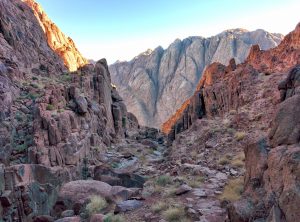
And here we are today, thousands of years later, celebrating the gifts that Moshe received of Torah, teaching us how as separate individuals we can be better and achieve more in a community of one. Our newsletter combines our voices and lives into a monthly description of us today as a people. To go back is to go forward, and to go forward is to go back. Some of you might know that I am talking about the Vav HaHipuch, or Vav Consecutive, in Hebrew. Actions in the Torah are presented as complete (past tense) and incomplete (continuing or future tense). How like our lives is the very textual context of the Hebrew language. We are consistently told in the Torah to look back, zachor, and, simultaneously, to move forward in our world, taking the lessons of the past with us.
In Robert Goldman’s book Tomorrow’s God, that Judy Goldman so lovingly produced, Robert says,
“In today’s Western world, when we think of time, we see ourselves as living in the present, marching ahead into an unknown future, with a completed past behind us, so that only the present remains ‘real.’ The future does not yet exist: the past no longer does. … Ancient Hebrews saw time quite differently. The way Hebrew prophets spoke about the past and the future in the biblical mind, past and future events are all alive.”
 According to Rabbi Morris Goldfarb, of blessed memory, in his Mishpatim drash on February 5, 2000 at Sof Ma’arav, “if the giving of the Ten Commandments is compared to a wedding, then Mishpatim is likened to the daily life of a married couple with obligations and responsibilities essential to a flowering of a mature and loving relationship. By deed as well as word, in Mishpatim, the covenant of the wedding day is realized fully.”
According to Rabbi Morris Goldfarb, of blessed memory, in his Mishpatim drash on February 5, 2000 at Sof Ma’arav, “if the giving of the Ten Commandments is compared to a wedding, then Mishpatim is likened to the daily life of a married couple with obligations and responsibilities essential to a flowering of a mature and loving relationship. By deed as well as word, in Mishpatim, the covenant of the wedding day is realized fully.”
Rabbi Goldfarb describes the three stages of a maturing human being:
- Stage one, Childhood; exodus from Egypt and HaShem is the parent (B’shallach)
- Stage two; Entrance into adulthood covenant between partners-no longer a child (Yitro)
- Stage three, Adulthood complexity, depth & fullness of a relationship experienced as rules are established (Mishpatim).
Rabbi Solomon Schechter offers a similar message of Mishpatim:
“Fulfillment is in the fruit, in the hundreds of details, which grow out of the general principles that orchestrate the continuing development of a full gratifying adult life. The peak moments are essential, but these moments pass. After the revelatory moment passes, after the high is over, then life begins and there Judaism must dwell, there we find the spirituality, the seeking for God in the involvement in mitzvot articulation not just in words but deeds, not just in strong feelings, but in cooperative behavior.”
Rabbi Lord Jonathan Sacks, of blessed memory, created his Covenant & Conversation series before his death so that we could continue to benefit from his great knowledge. Two of his Mishpatim excerpts are presented below.
Vision and Details, Mishpatim 5781
Our parsha takes us through a bewildering transition. Up until now, the book of Shemot has carried us along with the sweep and drama of the narrative: the Israelites’ enslavement, their hope for freedom, the plagues, Pharaoh’s obstinacy, their escape into the desert, the crossing of the Red Sea, the journey to Mount Sinai and the great covenant with God. Suddenly, we now find ourselves faced with a different kind of literature altogether: a law code covering a bewildering variety of topics, from responsibility for damages, to protection of property, to laws of justice, to Shabbat and the festivals. Without the vision, the details in our lives mean nothing. He states that the word Torah is untranslatable because it means several different things that only appear together in the book that bears that name. Torah means law. But it also means “teaching, instruction, guidance,” or more generally, “direction.”
The Torah is a book of narrative, history, and law, the formative experiences of a nation, and the way the nation sought to live its collective life, so as never to forget the lessons it learned along the way. It brings together vision and detail in a way that has never been surpassed.
In Doing and Hearing Mishpatim 5776
The people all responded together, “We will do, na’aseh, everything the Lord has said” (Ex. 19:8). When Moses went and told the people all the Lord’s words and laws, they responded with one voice, “Everything the Lord has said we will do, na’aseh” (24:3). Then he took the Book of the Covenant and read it to the people. They responded, “We will do and hear, na’aseh ve-nishma, everything the Lord has said” (24:7).
The first two responses, which refer only to action, na’aseh, are given unanimously. The people respond together. They do so “with one voice.” The third refers not only to doing, but also to hearing, nishma. “Hearing” here, means many things: listening, paying attention, understanding, absorbing, internalizing, responding, and obeying. It refers, in other words, to the spiritual, inward dimension of Judaism.
That is the difference between na’aseh and nishma. We do the Godly deed “together.” We respond to His commands “with one voice,” na’aseh.
But we hear God’s presence in many ways, for though God is One, we are all different, and we encounter Him each in our own individual way, nishma.
Let’s look at the Torah within the theme of separations:
- Genesis – Creation story: separate the waters above and below.
- Separate: Noah and the rest of the world with the flood
- Separate: Abraham from his birthplace to go forth into the wilderness a new path in his life to become the father of a great nation
- Separate: Esau and Jacob, Jacob becomes the transmitter of the covenant.
- Joseph is separated from his brothers only to save them in the end.
- Separate: The Israelites and take them out of Egypt.
Mishpatim is all about separations. The seventh year of shmitah separates from the first sixth for the land to rest; after six days of work / life, separate the seventh day for Shabbat. Separate first fruits, separate milk and meat, that which is given freely from the goodness of a mother to that which we consume because something had to be killed in order for us to live. Separate the holy observance of HaShem from the worshipping of idols, separate Moses as a leader, and again, the seventy elders from the rest of the Israelites to assist in judgments.

We are a nation created by God through separations. And yet we are a community of one under God. We function in a community of a minyan of ten, as a child separates from its mother at birth, so too do we continually separate by God’s command to do so in Mishpatim.
Yet, the one separation that God does not want is the separation of the soul / spirit / ruach from Him / Her. Through separations, we find holiness. We find holiness in walking in God’s ways and unifying our spirit. This is done within a community to the greatest extent. For study and prayer are meant to be our avenue to seeking HaShem in our lives. We perfect each other as we perfect our relationship and unification with God.
Commentary in Etz Hayim (456) describes Mishpatim as following:
“The laws of the Torah are cited not as the products of human wisdom and experience, but as a reflection of divine principles built into the world. Thus, the dignity of a human being is as much a permanent part of God’s creation as the law of gravity. Judaism is based not only on the major pronouncements of the Decalogue, but on the hundreds of minor ways in which we are called on to sanctify our relationships with other people.”
Our newsletter is the sanctification of our efforts to combine our thoughts and feelings into a written document to benefit the holiness in our relationships and how we, as Jews, view the world.
Drash for Parashat Yitro (5781)
February 28, 2021
By Dina Yoshimi
I think my Mom, aleha hashalom, wanted to give this drash. Yesterday, for the second time in two weeks, I awoke with that sense of urgency that comes when you’ve failed to fulfill an obligation to a parent. In my case, it was a deep and fervent sense that it had been too long since I talked to Mom and that I owed her a call.
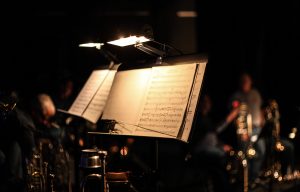 I still don’t know for sure what the dream is about, but since my Mom was my favorite Torah chevrusa, I’m guessing it’s my neshamah’s way of reminding me not to leave her out. So I will start with her favorite trope – the Torah as a symphony, and see where it takes me.
I still don’t know for sure what the dream is about, but since my Mom was my favorite Torah chevrusa, I’m guessing it’s my neshamah’s way of reminding me not to leave her out. So I will start with her favorite trope – the Torah as a symphony, and see where it takes me.
One symphonic theme that caught my ear this year is in Exodus 19:18:
וְהַר סִינַי, עָשַׁן כֻּלּוֹ, מִפְּנֵי אֲשֶׁר יָרַד עָלָיו יְהוָה, בָּאֵשׁ; וַיַּעַל עֲשָׁנוֹ כְּעֶשֶׁן הַכִּבְשָׁן, וַיֶּחֱרַד כָּל-הָהָר מְאֹד.
V’har Sinai ashan kulo mipney asher yarad alav Adonai ba’eysh; va’ya’al ashano k’ehshehn hakiv’shan, vayecherad kal hahar m’od.
All of Mt. Sinai was smoking because HaShem had descended upon it in the fire; its smoke ascended like the smoke of the furnace, and the entire mountain shuddered exceedingly. (Stone Chumash)
The images of smoke and fire evoke a passage from Parashat Lech L’cha (Genesis 15:17):
וַיְהִי הַשֶּׁמֶשׁ בָּאָה, וַעֲלָטָה הָיָה; וְהִנֵּה תַנּוּר עָשָׁן, וְלַפִּיד אֵשׁ, אֲשֶׁר עָבַר, בֵּין הַגְּזָרִים הָאֵלֶּה.
Vay’hi hashemesh ba’ah, va’alatah haya; v’hiney tanoor ashan v’lapiyd ash asher avar, bayn hag’zariym ha’eyleh.
So it happened: The sun set and it was very dark. Behold – there was a smoky furnace and a torch of fire which passed between these pieces. (Stone Chumash)
 In this passage HaShem reveals the future history of the Jews to Abram after casting a deep sleep over him. It appears in the Torah narrative almost immediately after HaShem relates to Abram that his descendants will be an enslaved and oppressed people b’eretz lo lahem in a land that is not theirs, for four hundred years, before HaShem will judge that nation, and the descendants of Abram “will leave biyr’choosh gadol with great wealth” (Genesis 15:14). The theme of Lech L’cha, leaving the land of one’s birth to journey to the bountiful land that HaShem has promised, resonates here in Yitro.
In this passage HaShem reveals the future history of the Jews to Abram after casting a deep sleep over him. It appears in the Torah narrative almost immediately after HaShem relates to Abram that his descendants will be an enslaved and oppressed people b’eretz lo lahem in a land that is not theirs, for four hundred years, before HaShem will judge that nation, and the descendants of Abram “will leave biyr’choosh gadol with great wealth” (Genesis 15:14). The theme of Lech L’cha, leaving the land of one’s birth to journey to the bountiful land that HaShem has promised, resonates here in Yitro.
The people have just left the only “homeland” they have ever known after several hundred years of bitter servitude. HaShem has judged Mitzrayim, and they do indeed leave with the spoils of their former taskmasters. They follow a leader who is committed to taking them to that same land promised to their forefather Abram hundreds of years earlier. The vision that HaShem set before Abram at that time is the vision Am Yisrael behold as they stand at Sinai: a smoking oven, a fiery torch that appears to them as amud eish, a pillar of fire. The unbounded timelessness of Jewish history is revealed: we will stand, we have stood, and we will always continue to stand at this point of going out from where we are and journeying to where we are convenanted to be.
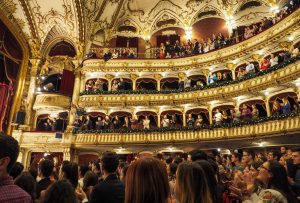 The resonances of this symphonic theme unfold even further through the words ashan ‘smoke’ and ba’eish ‘in the fire.’ These words, as well as the phrase ashano k’ehshehn hakiv’shan ‘its smoke like the smoke of the furnace” resonate with the phrase, kivshan ha’eish ‘the fiery furnace’, a phrase which – quite remarkably – also has ties to both Abraham Avinu and Y’tziat Mitzrayim, the Exodus from Egypt. The first connection is with the Aggadic story of Abram being thrown into kivshan ha’eish, the fiery furnace, by Nimrod, as punishment for his “crime” of destroying his father’s idols (Rashi on Genesis 11:28).
The resonances of this symphonic theme unfold even further through the words ashan ‘smoke’ and ba’eish ‘in the fire.’ These words, as well as the phrase ashano k’ehshehn hakiv’shan ‘its smoke like the smoke of the furnace” resonate with the phrase, kivshan ha’eish ‘the fiery furnace’, a phrase which – quite remarkably – also has ties to both Abraham Avinu and Y’tziat Mitzrayim, the Exodus from Egypt. The first connection is with the Aggadic story of Abram being thrown into kivshan ha’eish, the fiery furnace, by Nimrod, as punishment for his “crime” of destroying his father’s idols (Rashi on Genesis 11:28).
In the face of this test, Abram displays unwavering faith in HaShem and emerges from the fire unscathed (Artscroll, Pesachaim 118a, footnote 64). Quite unexpectedly, the splendid weaving of themes involves a Talmudic discussion of this very story. The discussion emerges as the Rabbis explore the origins of a line from one of the psalms that comprises Hallel Mitzri, the Egyptian Hallel – that is, the Hallel we recite during the seder as we commemorate y’tziyat Mitzraim and our salvation from slavery by HaShem. Just as HaShem protected Abram from the fiery furnace after he destroyed his father’s idols, so too were B’nei Yisrael protected from the murderous wrath of Pharoah after witnessing HaShem’s destruction of Egypt’s most powerful “idol”. The fundamental truth of the first commandment (Exodus 20:2):
אָנֹכִי יְהוָה אֱלֹהֶיךָ, אֲשֶׁר הוֹצֵאתִיךָ מֵאֶרֶץ מִצְרַיִם מִבֵּית עֲבָדִים: לֹא-יִהְיֶה לְךָ אֱלֹהִים אֲחֵרִים, עַל-פָּנָי.
Anochi Adonai Eloheicha asher hotzeyticha mei’Eretz Mitzrayim mibeyt avadim.
I am HaShem, your God, Who has taken you out of the land of Egypt, from the house of slavery (Stone Chumash) reaches across texts and time to form a sacred couplet with the line from the Hallel psalm discussed by the Rabbis (Psalm 117:2),
וֶאֱמֶת-יְהוָה לְעוֹלָם:
הַלְלוּ-יָהּ.
v’emet HaShem l’olam, Halleluyah
and the truth of HaShem is eternal, Hallelujah.
Okay. So is this drash the smoke and mirrors drash? Or is it the case that where there’s smoke, there’s fire?
Let’s consider the dissonance in the elements of these themes:
The narrative about Avraham Avinu is filled with bold, heroic action: Destroying his father’s livelihood, and taking the punishment for it. Accepting the many trials imposed on him by HaShem, and then after many years, questioning HaShem’s promise of countless offspring who will inherit a Land flowing with milk and honey while he remains childless, only to be shown while in a deep sleep, that his descendants will suffer for 400 years before the promised inheritance – yet keeping his faith all the same. Abrahams’s narrative is filled with faithfulness.
And the narrative of B’nei Yisrael? The heroics fall short: The people lose faith the moment they see the Egyptian charioteers coming for them; and even after this miraculous salvation, they grumble about the lack of food and water available to them. In this parashah, after having sanctified themselves in preparation for receiving the law at Sinai, Rashi teaches that, after B’nei Yisrael heard the first two commandments, they asked to “be excused” as they were unable to handle the intense sanctity of the moment (Makkos 24a in Stone Chumash, p.407).
Rabbi Amy Scheinerman in teaching about Talmudic perspectives on moving to Eretz Yisrael (The Talmud of Relationships, pp. 114-115) provides a bit of commentary about the behavior of Am Yisrael during and after the Exodus. While not intended as a commentary on Yitro, her discussion enlightens this dissonance somewhat. She writes:
“The Rabbis attributed to Moses a measure of courage, strength, and power that is sorely lacking among the biblical Hebrews and also the Jews of their own time. To the extent that Moses was a synecdoche for Israel, this painted a poignant account of a people raised from degradation to freedom whose self-image did not raise along with their condition. The Jewish people were imbued with a sense of strength from their covenantal connection to God and accompanying national story … but also with a sense of fragility imparted by the vicissitudes of history…
In essence, as the talmudic Rabbis and their descendants shaped traditional Jewish liturgy, they wove passivity into the Jewish foundational myth of the Exodus: Israel had come into being as a nation through God’s power and direction, with no substantive physical assist by the people, and despite their fear and reticence to leave slavery in Egypt. And when this staple text of the Jews was recited daily, weekly, year in and year out, it reinforced their sense of Jewish passivity, powerlessness, and dependence on God for substantive change in their conditions of life.”
Hmm…passive, powerless and dependent on HaShem. Perhaps this is what Yitro saw, as well, when he looked at the people his son-in-law had just led out of Egypt through HaShem’s providence and protection. In effect, an entire nation had been freed from slavery, yet, in practice, only one individual, his son-in-law, was empowered to act with authority, and that authority derived from his role as a go-between between the people and HaShem (cf. Exodus 18:15 “…Because the people come to me to seek God.”). Yitro’s contribution – a gift TO the Jews – was to propose a path to a political organization of power that was not rooted in Moses’ face-to-face relationship with HaShem, a path that would support locally-grounded structures for community coordination and conflict resolution.
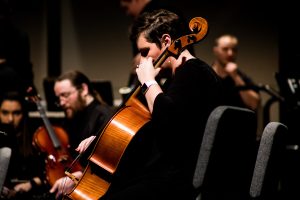 But we’re not finished with those dissonant chords yet: Let’s not forget that leyners don’t line up for Parashat Yitro to read the lines about his contribution to the social and political organization of B’nei Yisrael…there a few other key topics addressed in this parashah that carry significantly more weight in our tradition. Now what were those things called…? The 10 conventions? The 10 amendments? The 10 kumquats? Oh, right! The Ten Commandments! Aseret HaDibrot! Those super special commandments that made it onto the first set of stone tablets that Moses brought down from Har Sinai… AND the second set, too.
But we’re not finished with those dissonant chords yet: Let’s not forget that leyners don’t line up for Parashat Yitro to read the lines about his contribution to the social and political organization of B’nei Yisrael…there a few other key topics addressed in this parashah that carry significantly more weight in our tradition. Now what were those things called…? The 10 conventions? The 10 amendments? The 10 kumquats? Oh, right! The Ten Commandments! Aseret HaDibrot! Those super special commandments that made it onto the first set of stone tablets that Moses brought down from Har Sinai… AND the second set, too.
Now wait a second. Are you telling me that Yitro, a Midianite with 7 names and 7 daughters is the opening act for the Ten Commandments? And, on top of that, he gets top billing since it’s his name that provides the name for this parashah. How does it come to be that the most iconic section of Jewish law and the father-in-law of the most iconic figure in Jewish law come to share a parashah… And it’s the father-in-law who gets the glory?!
I would like to offer one more bit from Rabbi Scheinerman’s discussion (p. 116), as I believe it may help resolve these dissonant chords, and get us moving on to Musaf post-haste. The Rabbi brings up the ideas of Heinrich Graetz, a 19th century Jewish historian who argued (and here I quote from a quote in the Rabbi’s text):
“Judaism’s essence consists of the interplay between the idea of a transcendent God and the political reality into which this idea is always rendered concurrently. According to Graetz, this constant dialectal relationship between theology and politics means that ‘Judaism is not a religion of the individual but of the community. That actually means that Judaism, in the strict sense of the word, is not even a religion – if one understands thereby the relationship of man to his creator and his hopes for his earthly existence – but rather a constitution for a body politic.”
To fold in our themes as we wind towards the final measures of this symphonic drash: The narrative about Abraham Avinu suggests that being Jewish is about acting as an individual yet, when we arrive at Parashat Yitro, we know that HaShem didn’t just cut the b’rit with Abram, but rather, he made sure that we were ALL standing there at Sinai to accept it. And, Abram’s trial by fire wasn’t a singular demonstration of faith, for we too hold a seder each year; we, K’lal Yisrael hold a seder and reaffirm HaShem’s truth that He brought each and every one of us out of Eretz Mitzrayim mibeyt avadim – mei’avdut l’cheirut (from slavery to freedom). And, finally, although we Hebrew grammar fans know that the 10 Commandments are written in the singular command form, don’t let that bit of grammar fool you. These mitzvot, which we each took upon ourselves at Sinai, were not given until Yitro had helped us see that we were not just an am s’gulah, each one to be lovingly counted by HaShem, but also, a nation of leaders, and people of accomplishment, capable of community organization; and a nation of God-fearing people and people of truth, capable of judging fairly without bias towards rich or poor.
Thanks for your help, Mom!
Shabbat Shalom!
Drash Parashat Vayigash (5781)
February 3, 2021
by Malka Michèl
פרשת ויגש (parashat vayigash) is the penultimate parasha in ספר בראשית , the book of Genesis. It is primarily in the books of בראשית (Genesis) and שמות (Exodus) that we find the narratives for which Torah is the most well-known. When thinking about this particular parasha, and what I wished to explore with you all today, I kept coming back to that idea of narrative; the narratives that have been woven all throughout the book of Genesis, and also our own personal narratives. One of the most beautiful things about Torah – with which I think we can all agree – is how seamlessly it becomes a mirror for our own lives. As the Jewish people, we have carried various narratives (for better or worse) in our midst over the course of centuries. As individuals, we carry certain narratives inside us (for better or worse) over the course of our lives.
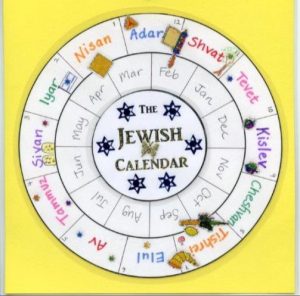 In Torah, we have a couple different narratives that play into this week’s parasha: first, we have the narrative that Yaakov tells himself upon seeing Yosef’s torn and bloody coat; that he would never again see the son that he so cherished. We have the narrative told by Potifar’s wife (that Yosef had behaved inappropriately with her) that ultimately got Yosef thrown in prison. Then, in a puzzling turn of events, Yosef insists on detaining his brother Shim’on while the rest of the brothers return to Canaan. Not only that, Yosef orders his servants to return the money his brothers paid for their provisions without their knowledge. What prompted such strange behavior from Yosef? What kind of narrative was he telling himself? That his brothers were still angry at him, and that he had to contrive a way of making sure they would come back to Egypt? We call Yosef a tzadik – a righteous person. Is that the behavior of a tzadik?
In Torah, we have a couple different narratives that play into this week’s parasha: first, we have the narrative that Yaakov tells himself upon seeing Yosef’s torn and bloody coat; that he would never again see the son that he so cherished. We have the narrative told by Potifar’s wife (that Yosef had behaved inappropriately with her) that ultimately got Yosef thrown in prison. Then, in a puzzling turn of events, Yosef insists on detaining his brother Shim’on while the rest of the brothers return to Canaan. Not only that, Yosef orders his servants to return the money his brothers paid for their provisions without their knowledge. What prompted such strange behavior from Yosef? What kind of narrative was he telling himself? That his brothers were still angry at him, and that he had to contrive a way of making sure they would come back to Egypt? We call Yosef a tzadik – a righteous person. Is that the behavior of a tzadik?
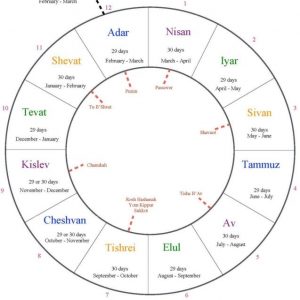 Humans are, if nothing else, complex creatures –a point which Torah strives over and over again to drive home –and it is possible to love, even adore someone while also recognizing that they have done things that are hard to stomach. At any given point in our lives it is totally possible that we carry narratives that conflict with each other and cause dissonance inside us.
Humans are, if nothing else, complex creatures –a point which Torah strives over and over again to drive home –and it is possible to love, even adore someone while also recognizing that they have done things that are hard to stomach. At any given point in our lives it is totally possible that we carry narratives that conflict with each other and cause dissonance inside us.
As Jews, we’ve already had our New Year celebration; as it happens, this year we’ve also already had our winter celebration. However, we live in a context that is not Jewish. Regardless of whether or not we celebrate the Gregorian New Year, the fact is that our surroundings affect us in ways that are both conscious and subconscious. This time of year is one of tremendous change and upheaval; it is a time of endings, of beginnings, and tremendous uncertainty. If I learned anything from my first semester in rabbinical school (and I have already learned many things) it’s that situations of discomfort are usually opportunities for us to turn inward and examine what kind of narratives (healthy or unhealthy) are driving the choices we make.
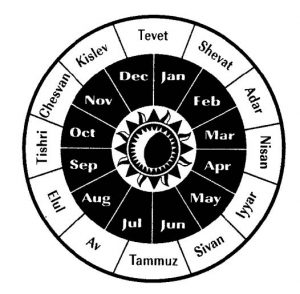 2020 has been a year of challenge and, in some unfortunate cases, extreme hardship. We have all been touched – in some way or another – by loss and the inevitable emptiness that comprises its wake. I don’t know about you, but I have been learning (the hard way) to ask myself, ‘What is the blessing in this?’ As irritating as that question can sometimes seem at first, it is a catalyst, and it is also distinct from the narrative that some horrific occurrence is somehow ‘part of God’s plan.’
2020 has been a year of challenge and, in some unfortunate cases, extreme hardship. We have all been touched – in some way or another – by loss and the inevitable emptiness that comprises its wake. I don’t know about you, but I have been learning (the hard way) to ask myself, ‘What is the blessing in this?’ As irritating as that question can sometimes seem at first, it is a catalyst, and it is also distinct from the narrative that some horrific occurrence is somehow ‘part of God’s plan.’
Our world is shifting and changing at a rate that can be staggering, and as time goes by, I feel more and more strongly that our concepts of God must also change. A God that tightly controls and engineers the events of history cannot be looked upon as benevolent in the wake of the atrocities that modern times have witnessed.
In the all the rich complexity of our lives, I don’t think that’s a sustainable concept of God, to be totally honest. After all, our own tradition has never had a rigid concept of God; anyone who knows Jewish text will tell you that a Jewish concept of God has changed dramatically throughout our history even over relatively short periods of time. When it comes to a Western notion of God, this is often one that has been heavily informed by Christianity, so it is worth asking ourselves if the image of God that society gives us lines up with what our rabbis teach about God.
My mother was telling me last night – as we sat around the Shabbat table – about the mussar practice of reflecting on a difficult event. The practice is to state only the facts. Just the events that took place without any editorializing or interpreting.
It occurred to me then, that the Torah is written in just such a way. Especially in the books of Genesis and Exodus, the events are relayed as just that – the events themselves. This is why our rabbis had such a field day with midrash; because there are so many blanks to fill in. This is also why, at least I believe, our ancestors recorded Torah in this particular way. It wasn’t because they weren’t creative and it wasn’t because they didn’t know how to tell stories. It was because they wanted to remove themselves (as much as possible) from the transmission of something that didn’t ultimately come from them. If they had expounded on their personal feelings of why Yosef was such a strange duck – for instance – then the narrative would have gotten muddled. Not only that, our ability to relate Torah to our lives would forever be inhibited by their perspective.
So, Torah comes to us again and again to remind us that even though we cannot always control the events of our lives, we do control the narratives that we spin from those events. Just as God began creating our universe from total chaos, this time of year is a huge invitation for us to shed the narratives that no longer serve us, that are inhibiting us, and that are keeping us from progressing in our lives.
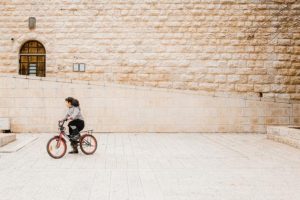 Imagine, for a moment, if Yaakov had stopped to ask his sons some questions about the bloody cloak before assuming the worst. What would have happened? Maybe the brothers would have hesitated, and Yaakov would have suspected some mischief. Obviously, that’s not how the narrative played out, and there was, ultimately, redemption in a story that was otherwise very tragic. My point is that sometimes it’s a good exercise not to take things at face value.
Imagine, for a moment, if Yaakov had stopped to ask his sons some questions about the bloody cloak before assuming the worst. What would have happened? Maybe the brothers would have hesitated, and Yaakov would have suspected some mischief. Obviously, that’s not how the narrative played out, and there was, ultimately, redemption in a story that was otherwise very tragic. My point is that sometimes it’s a good exercise not to take things at face value.
And speaking of face value, I believe we are entering a critical juncture in our evolution as the human species. This past Gregorian year has seen our world in the midst of tremendous change and even upheaval, and as Jews in the United States, we have the incredible luxury of being able to ask ourselves ‘What is the blessing in this?’ Now, that does not ever mean we stand by while injustice is perpetrated and our liberties are systematically revoked. No. It means that we learn to live in the dichotomy of inward reflection and outward motion.
 I believe we must take this opportunity to reflect inward, to look at the narratives that no longer serve us, because this will ultimately propel us into the next stage of our evolution. A stage where we can finally learn to embrace the tremendous power God has given us as individuals. Releasing old narratives is key though, because we have to make room for the change; this is a power that will not manifest in ways that we expect. It is not the power of force and control (which is an outward power), but rather the power of presence and knowing, something that no one can take away from us because it is part of our God-given essence.
I believe we must take this opportunity to reflect inward, to look at the narratives that no longer serve us, because this will ultimately propel us into the next stage of our evolution. A stage where we can finally learn to embrace the tremendous power God has given us as individuals. Releasing old narratives is key though, because we have to make room for the change; this is a power that will not manifest in ways that we expect. It is not the power of force and control (which is an outward power), but rather the power of presence and knowing, something that no one can take away from us because it is part of our God-given essence.
This is the power that will ultimately create a different world for us, and for our children, and our grandchildren. This innate power can be compared to what our rabbis call the שכינ ה (shechina) – or God’s more feminine aspect. God possesses both a masculine, outward sort of power, and a feminine, hidden power, and we are made in God’s image.
I think a lot about what our ancestors wrote concerning the coming of mashiach and the world to come. Perhaps somewhat naively, I used to think the messiah was a guarantee, but now I’m not so sure. After all, how can any outcome be guaranteed when God gave us free will? I haven’t given up hope though – not at all. In fact, I resonate more and more with the Kabbalistic idea that God gives us the invitation to be partners with Him in creation. That’s a heck of a lot more responsibility, to be sure, and sometimes I’m not sure if I’m up for the task. But I think I have to be. If I don’t want an endless replay of the misery of the past, the only way forward is to take a different approach. And I think the salient message here is that it’s totally possible. It’s possible for all of us because we don’t have to go it alone.
So, this Shabbat I bless all of us that we should be able to truly, deeply embrace our God-given essence and that we will create a better future for all of us.
Rich and Layered: Vaʻera Drash
February 2, 2021
by Risa Dickson
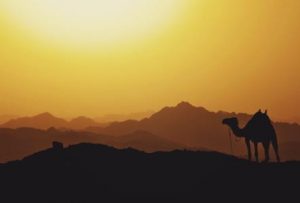 I tend to approach every Parsha with the question of “What’s in this for me?” I’m aware that millions of people throughout history have made incredible sacrifices, including losing their lives, so that I have the ability to stand here and discuss what I see in this Torah portion. Certainly, I have a responsibility to open myself up to what is in here, and how it informs my life. Torah is meant to be a living document and many of us know that every year, any given parsha resonates with different phases of our lives, with our current experiences or concerns, conundrums or moods.
I tend to approach every Parsha with the question of “What’s in this for me?” I’m aware that millions of people throughout history have made incredible sacrifices, including losing their lives, so that I have the ability to stand here and discuss what I see in this Torah portion. Certainly, I have a responsibility to open myself up to what is in here, and how it informs my life. Torah is meant to be a living document and many of us know that every year, any given parsha resonates with different phases of our lives, with our current experiences or concerns, conundrums or moods.
I’ve come to understand in my current reading of Va’era that it is a parsha so rich and layered with meaning that it’s impossible to find a singular message. While most of us are more than familiar with the story of the plagues, and the promises of deliverance with an outstretched hand, and the confines of Mitzrayim, there is so much more here than is immediately apparent. It’s a story where the basic narrative is so often repeated that I don’t know that I really understood that there was so much here.
So, I’m going to share a few things I learned that I guess I didn’t fully realize, or hadn’t integrated if I’d learned them before. Things that at this moment in my life resonate with me. And this is just a fraction of what I could tell you.
To begin, a piece of trivia — the first and last letter of the name of the parsha tell us
how many plagues are in this portion. The vav at the beginning and the aleph at the
end tell us that there are 7 plagues. This is also true for next week’s parsha. (Thank you Yudi Weinbaum for this).
 The last parsha, Shemot, ends with Moses arguing with G-d that in following G-d’s direction, things became much worse for the Israelites. Moses argues that he is clearly not the right person for the job, that he was failing in his task, in his leadership, and he was frustrated. Moses was the first of the prophets to kvetch. Did you ever hear of Abraham, Isaac, or Jacob complaining to G-d or questioning G-d? In fact, when G-d said to Abram, “Lech Lecha” – he was like, “OK.” Even when Abraham was asked to sacrifice his child, he didn’t question or argue.
The last parsha, Shemot, ends with Moses arguing with G-d that in following G-d’s direction, things became much worse for the Israelites. Moses argues that he is clearly not the right person for the job, that he was failing in his task, in his leadership, and he was frustrated. Moses was the first of the prophets to kvetch. Did you ever hear of Abraham, Isaac, or Jacob complaining to G-d or questioning G-d? In fact, when G-d said to Abram, “Lech Lecha” – he was like, “OK.” Even when Abraham was asked to sacrifice his child, he didn’t question or argue.
In the kvetching interchange, G-d responds to Moses. “I am the Lord, I appeared to Abraham, Isaac, and Jacob as El Shaddai (or Elohim), but I did not make myself known to them by my name YHVH.” This is a turning point in a new revelation of G-d and the relationship with our ancestors. A moment that resonates with the Kabbalistic idea of constriction and revelation (tsimtsum) of G-d’s presence in the world. It’s a powerful turning point and changes the nature of our relationship with G-d. It’s both an invitation and a direction to begin bringing G-d down to earth through our actions and our devotion.
In the Exodus story, it’s mentioned something like twenty times that G-d “hardens” or “makes heavy” or “strengthens” Pharaoh’s heart against the Israelites. Often the discussion at this point turns to Pharaoh and either his stubbornness or his free will. If G-d wanted Pharaoh to let his people go, then why did he harden Pharaoh’s heart? Rabbi Lord Jonathan Sacks has suggested that, if Pharaoh had no free will, then how can we hold him accountable? After all, aren’t we only held accountable where this is a choice?
 An interesting answer from Rabbi Lord Jonathan Sacks is that the Egyptians believed that upon their death the heart would be weighed against a feather in a moment of judgement. At the time of embalmment, the Egyptians removed all organs except the heart. A “heavy” heart would have affected Pharaoh’s eternal afterlife. And, a close reading of Va’era shows that Pharaoh actually hardened his own heart for the first five plagues. The act of G-d hardening his heart for the last five may have provided Pharaoh with the conundrum of pitting his ongoing private internal and current external public goals against each other, and given him the impetus to ultimately turn away from his wickedness.
An interesting answer from Rabbi Lord Jonathan Sacks is that the Egyptians believed that upon their death the heart would be weighed against a feather in a moment of judgement. At the time of embalmment, the Egyptians removed all organs except the heart. A “heavy” heart would have affected Pharaoh’s eternal afterlife. And, a close reading of Va’era shows that Pharaoh actually hardened his own heart for the first five plagues. The act of G-d hardening his heart for the last five may have provided Pharaoh with the conundrum of pitting his ongoing private internal and current external public goals against each other, and given him the impetus to ultimately turn away from his wickedness.
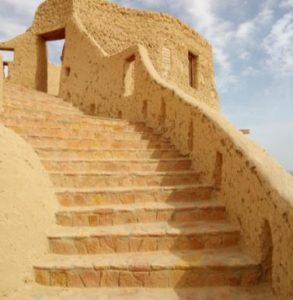 There is a striking Egypt-centric focus on the plagues. And a clear posturing of YHVH to be understood and recognized as the supreme G-d above all others. A commandment, in fact, that is coming shortly. Rabbi Lord Jonathan Sacks has noted that the point of at least three of the plagues was a direct challenge to an Egyptian god. For example, the first plague was directed against Hapfi, the god of the Nile; and the second plague of frogs was directed against Heqet, the Egyptian goddess of fertility and childbirth, represented in the form of a frog. The plague of darkness was directed against Ra, the sun god. The message of these plagues would have been clear to both the Egyptians and the Israelites: There is a power greater than the Egyptian gods – a message also implicit when Aaron’s staff consumed those of the magicians. The message was clear, the G-d of Israel is the G-d of all, and there is no other god before YHVH.
There is a striking Egypt-centric focus on the plagues. And a clear posturing of YHVH to be understood and recognized as the supreme G-d above all others. A commandment, in fact, that is coming shortly. Rabbi Lord Jonathan Sacks has noted that the point of at least three of the plagues was a direct challenge to an Egyptian god. For example, the first plague was directed against Hapfi, the god of the Nile; and the second plague of frogs was directed against Heqet, the Egyptian goddess of fertility and childbirth, represented in the form of a frog. The plague of darkness was directed against Ra, the sun god. The message of these plagues would have been clear to both the Egyptians and the Israelites: There is a power greater than the Egyptian gods – a message also implicit when Aaron’s staff consumed those of the magicians. The message was clear, the G-d of Israel is the G-d of all, and there is no other god before YHVH.
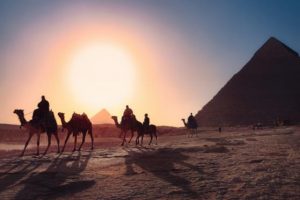 There are also some very interesting Kabbalistic interpretations of the plagues. For example, moving from Gevurah to Hesed in the river turning from cold water to warm blood – a symbol of life, and passion, and sensitivity to others, with the plagues ultimately moving back to a cold death in the final blow. But, despite my love and study of Zohar and Chasidus, that’s not what drew my attention this year. However, if you’re interested, I would urge you to explore this intriguing angle.
There are also some very interesting Kabbalistic interpretations of the plagues. For example, moving from Gevurah to Hesed in the river turning from cold water to warm blood – a symbol of life, and passion, and sensitivity to others, with the plagues ultimately moving back to a cold death in the final blow. But, despite my love and study of Zohar and Chasidus, that’s not what drew my attention this year. However, if you’re interested, I would urge you to explore this intriguing angle.
One of the themes I’ve observed in my learning through the years is that biblical stories of our ancestors are often ones in which they find themselves compelled to leave or are forced out of a place. They are compelled into movement that results in a transformation, a heightened self-awareness, and a new and different understanding of our world and of G-d. For example, Adam and Eve were forced out of Eden, and in the process became fully aware autonomous human beings with free will and an understanding of good and evil. Noah was forced to take his family and flee, and created a new world, Abram was told Lech Lecha – leave. “Go to yourself.” Joseph was sold by his brothers, and taken to Egypt, where he changed the course of history, and now at this moment the Israelites are compelled to leave Egypt.
 In hardening Pharaoh’s heart, it may also have been that G-d was making things so intolerable for the Israelites that they were compelled to leave. But they needed to leave so they could receive the Torah and ultimately make their homes in the land promised to Abraham, Isaac, and Jacob. YHVH told Moses “Tell Pharaoh to let my people go to worship me.” They needed to leave so that they could come to a realization of YHVH and bring godliness into the world through their actions and lives. But neither Pharaoh nor the Israelites were willing to listen to Moses – hence some of the kvetching and the sense of failure on his part, and the ensuing history of the plagues and the movement of an entire people out of Mitzrayim and into a moment of receiving a destiny.
In hardening Pharaoh’s heart, it may also have been that G-d was making things so intolerable for the Israelites that they were compelled to leave. But they needed to leave so they could receive the Torah and ultimately make their homes in the land promised to Abraham, Isaac, and Jacob. YHVH told Moses “Tell Pharaoh to let my people go to worship me.” They needed to leave so that they could come to a realization of YHVH and bring godliness into the world through their actions and lives. But neither Pharaoh nor the Israelites were willing to listen to Moses – hence some of the kvetching and the sense of failure on his part, and the ensuing history of the plagues and the movement of an entire people out of Mitzrayim and into a moment of receiving a destiny.
 Before his death, Rabbi Lord Sacks had prepared his drashot for this coming year. This year’s drosh for Va’era focused on the leadership of Moses. Rabbi Sacks says that the message is that leadership, even of the very highest order, is often marked by failure. He says that great humans are not those who are always successful in their efforts, but rather they are those who survive failure, who keep on going, who refuse to be defeated, and who never give up or give in. They are people who understand failure as a lesson, and from every failure refuse to be defeated, but rather become stronger, and wiser, and more determined. I think this sounds a lot like the Jewish people.
Before his death, Rabbi Lord Sacks had prepared his drashot for this coming year. This year’s drosh for Va’era focused on the leadership of Moses. Rabbi Sacks says that the message is that leadership, even of the very highest order, is often marked by failure. He says that great humans are not those who are always successful in their efforts, but rather they are those who survive failure, who keep on going, who refuse to be defeated, and who never give up or give in. They are people who understand failure as a lesson, and from every failure refuse to be defeated, but rather become stronger, and wiser, and more determined. I think this sounds a lot like the Jewish people.
 As we enter Pesach this year and consider the meaning of Mitzrayim in our own lives, as we retell the story so many of us have heard, or told every year for decades, maybe I’ve given you something to think about. Perhaps, the importance of allowing ourselves to be moved; moved from our own personal constrictions and into revelations and greater self-awareness. Maybe I’ve reminded you of the importance of pushing through and never giving up as we find ourselves continually forced and compelled into the new spaces of our respective lives.
As we enter Pesach this year and consider the meaning of Mitzrayim in our own lives, as we retell the story so many of us have heard, or told every year for decades, maybe I’ve given you something to think about. Perhaps, the importance of allowing ourselves to be moved; moved from our own personal constrictions and into revelations and greater self-awareness. Maybe I’ve reminded you of the importance of pushing through and never giving up as we find ourselves continually forced and compelled into the new spaces of our respective lives.
Darkness Drash
January 28, 2021
By Reb Daniel Lev
 Today’s parsha describes the last three plagues: locusts, darkness and death of the Egyptian first born. Since the light of Hanukkah ended about six weeks ago it might be helpful for us to rekindle some of its light as we first delve into the winter shadows that are multiplied many times over in the ninth plague of darkness. It might seem to some of us that much of this past Gregorian year has been filled with a pandemic darkness. Perhaps this parsha can shine a little light on how to transition out of the current plague that afflicts the world today.
Today’s parsha describes the last three plagues: locusts, darkness and death of the Egyptian first born. Since the light of Hanukkah ended about six weeks ago it might be helpful for us to rekindle some of its light as we first delve into the winter shadows that are multiplied many times over in the ninth plague of darkness. It might seem to some of us that much of this past Gregorian year has been filled with a pandemic darkness. Perhaps this parsha can shine a little light on how to transition out of the current plague that afflicts the world today.
If you recall, HaShem (“G-d”) tells Moses to call down darkness onto the Egyptians, and this resulted in their living in a blackout for three days. Specifically, it says in Shemot 10:21: “And HaShem said to Moshe, ‘Stretch out your hand upon the heavens that there may be darkness over the land of Egypt and Yameish (יָמֵ֖שׁ) darkness”
Some commentators translate the Hebrew word Yameish (יָמֵ֖שׁ) as “intensive,” so the sentence could read: “…and the darkness will Yameish (יָמֵ֖שׁ) – become darker, more intense…” We can learn a great deal more about this by hearing from rabbis throughout the ages.
Onkelos, the great Roman convert to Judaism, who lived a couple thousand years ago, wrote a complete Aramaic translation of the Tora. He understood Yameish (יָמֵ֖שׁ) to be similar to YA’AMEISH, which he translated as “to depart or remove.” He understood this to mean that this darkness departs from the usual night-time darkness and becomes even darker.
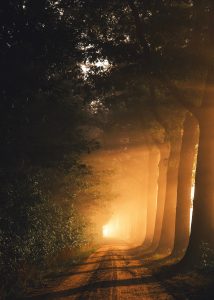 About a thousand years later, Rashi, the great French-Jewish commentator agreed with Onkelos, but then added two more understandings. First, he gave an Aggadic (metaphorical) interpretation that derived from another place in the Torah which said, “Mimasheish betzohoraim – You shall grope at noon as a blind man gropes in the dark” (Deut 28:29). This conveyed that was so dark that you had to feel your way around the walls or chairs to move anywhere. Rashi also said: “…for the darkness was doubled and redoubled and thick until there was in it mamash – substance.” You could feel the darkness. Rashi’s translation is: “Vayameish choshech – even darkness which may be felt (or touched).”
About a thousand years later, Rashi, the great French-Jewish commentator agreed with Onkelos, but then added two more understandings. First, he gave an Aggadic (metaphorical) interpretation that derived from another place in the Torah which said, “Mimasheish betzohoraim – You shall grope at noon as a blind man gropes in the dark” (Deut 28:29). This conveyed that was so dark that you had to feel your way around the walls or chairs to move anywhere. Rashi also said: “…for the darkness was doubled and redoubled and thick until there was in it mamash – substance.” You could feel the darkness. Rashi’s translation is: “Vayameish choshech – even darkness which may be felt (or touched).”
About two hundred years later the Sephardic commentator Ramban (Nachmanidies) said that the darkness was so dense that it was like a fog that came down from the sky and extinguished every light in Egypt. He also believed that this darkness was a substance you could feel. Amazing! He’s saying that unlike normal darkness that is dispelled with a single candle flame, this darkness – Yameish choshech – would snuff out all the light in Egypt. It had a substantial impact on all illuminations. Sforno, a renowned Italian rabbi, writing in the 16th-century agreed with Ranban saying that, “The natural darkness of night is simply air-that-has-no-light, but Yameish, this would be air so thick that light could not get in.”
In the 19th-Century the leader of the new “Orthodox” movement in Germany, Rabbi Shimshon Raphael Hirsch, extended the meaning that Onkelos offered about two thousand years earlier. Again, Onkelos said it meant “to depart.” Rabbi Hirsch said that the word Moosh “…also means ‘to go away,” which is the very opposite of ‘to touch.’ After all, to touch something is to draw near to it most directly…..(so this means) ‘to withdraw from exceptional closeness’….it denotes being in the vicinity of something, slightly close, touching without holding, touching but without connection.” Like ‘groping’ it is uncertain touching, as if we’re blind. “Touching something and then letting to go, again and again…”
 Now, what do these understandings of this intense darkness teach us? Mamash, what kind of darkness are we experiencing now in 21st-Century Hawaiʻi? Covid-19, political extremism and insurrection, recession. For many of my clients, and some of us, these problems can bring on depression and deeply upsetting stress. We sometimes feel that our troubles are a thick substance that makes it difficult for us to see any good in life.
Now, what do these understandings of this intense darkness teach us? Mamash, what kind of darkness are we experiencing now in 21st-Century Hawaiʻi? Covid-19, political extremism and insurrection, recession. For many of my clients, and some of us, these problems can bring on depression and deeply upsetting stress. We sometimes feel that our troubles are a thick substance that makes it difficult for us to see any good in life.
The negative thoughts and feelings seem very real to us – as if they fill and surround us like a dark shadow. And sadly, the heaviness of this mood seems to block out all the light. And what happens when the lights are blocked? – we get a little blind and end up groping around in the dark, kind of like tentatively touching life without grasping it, as Rabbi Hirsh suggested. This is perhaps what the Egyptians were experiencing in the dark, or maybe even earlier – while they lived in the darkness of Pharoah’s rule.
Let’s start moving toward the light to dispel the darkness. It says in chapter 10, verse 23 that in the darkness the Egyptians “…did not see each other.” Regarding this, the 19th-Century Chassidic Rebbe – Menachem Mendel of Vorki said, “There is no darkness or gloom greater in the world than this: That people do not see their fellows, but each one worries only about themselves.”
Regarding this insight, the 20th-century rabbi, and my Rebbe, Reb Shlomo Carlebach, (alav ve-shalom), said that while the Egyptian’s were dwelling in the dark, the Torah said, “But for the Children of Israel, there was light in their dwellings.” Reb Shlomo commented: “During the three days of darkness the Egyptians didn’t see one another. By us Jews, there was also the same darkness, but the Torah says that for Israel it was light. So the ordinary meaning is that for Egypt it was dark and for Yiddelach there was light. But the deeper meaning is that when it was dark for Egypt, they weren’t able to see anyone else. What do we Jews do when it’s dark? – We look for somebody else. When there is light, you don’t feel so lonesome. But when its dark, you mamash need somebody….so we walk around looking for people who are also lonesome… sometimes I’ll even look for someone who is in more darkness than I am – It’s like, I have to find that person.”
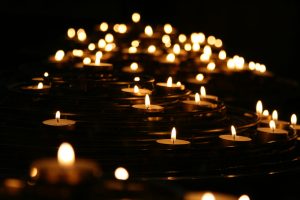 So once we find one another, things lighten up. So How come we had light and the Egyptians didn’t? How were we free from the bind and body-numbing thickness of their darkness? Two of many factors are this: The first starts with a question: “What did G-d want the Egyptians, and especially the Pharoah, to do in order to avoid the plagues? “Let my people go!” – We needed Pharoah to give us a “Get out of Egypt free card.” We needed to leave because of the nature of Egypt itself.
So once we find one another, things lighten up. So How come we had light and the Egyptians didn’t? How were we free from the bind and body-numbing thickness of their darkness? Two of many factors are this: The first starts with a question: “What did G-d want the Egyptians, and especially the Pharoah, to do in order to avoid the plagues? “Let my people go!” – We needed Pharoah to give us a “Get out of Egypt free card.” We needed to leave because of the nature of Egypt itself.
As some of you know the Hebrew word for Egypt is Mitzraim. This is related to the word Tzar, which means narrowness. So Egypt is the land of narrowness. And this is how the tangible darkness of depression and fear work. It narrows our perception of life so much so that we end up groping around in a desperate effort to depart from it, not knowing that it is our narrow perception that keeps us from leaving it.
And we Jews? We want to leave the narrowness of that place and go to the open spaces of freedom. (Which we finally did). How did they start the process? Earlier in Exodus it tells us that as a community we all opened ourselves to HaShem and cried out to G-d, Who heard us.
 So, the first way to free ourselves from the darkness happens when we mamash leave the narrowness behind by opening up our consciousness to the Source of creation and to be present in that creation rather than languish in dark thoughts and feelings.
So, the first way to free ourselves from the darkness happens when we mamash leave the narrowness behind by opening up our consciousness to the Source of creation and to be present in that creation rather than languish in dark thoughts and feelings.
It’s like George, one of my clients, who was having a very down day… But he managed to go to the beach. And as he stood on the sand looking out over the ocean, he began to feel himself lighten up as he fully took in the beach, opening up his senses to the world around him….
We can also do that by talking to G-d, or connecting ourselves to the life-affirming reality around us. That is one way we can create the light that dispels even the thickest of dark clouds.
 A second way to dispel the darkness comes from what the Vorki Rebbe and Reb Shlomo taught – to free ourselves from the darkness of extreme, selfish individualism and soul wrenching loneliness we can open our eyes to see other people and reach out to them, even online or by phone. As the Torah observed, “the Jews had light in their dwellings” – by joining together we make the light that dissolves the darkness
A second way to dispel the darkness comes from what the Vorki Rebbe and Reb Shlomo taught – to free ourselves from the darkness of extreme, selfish individualism and soul wrenching loneliness we can open our eyes to see other people and reach out to them, even online or by phone. As the Torah observed, “the Jews had light in their dwellings” – by joining together we make the light that dissolves the darkness
I want to bless you, and please bless me back, that through the various darknesses we face at this time, may we all open up our hearts and minds to see clearly the illumination all around us, and that as we reach out to one another may we share each other’s light carrying us all towards a better year.
Drash on Parsha Shemot
January 27, 2021
By Sid Goldstein
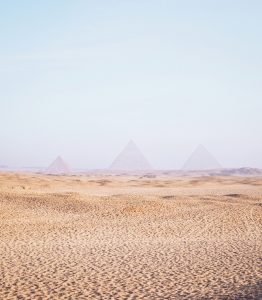
Shabbat Shalom Everyone.
“Who am I that I should go to Pharaoh?” said Moses to God. “And how can I possibly get the Israelites out of Egypt?”
On the surface the meaning is clear. Moses is asking two things.
The first: who am I, to be worthy of so great a mission?
The second: how can I possibly succeed?
God answers the second question. “Because I will be with you.” You will succeed because I am not asking you to do this alone. I am not really asking you to do it at all. I will be doing it for you. I want you to be My representative, My mouthpiece, My emissary, My human voice.
But God never answered the first question. “Who am I that I should go to Pharaoh?”
Perhaps in a strange way Moses answered it himself. In the Tanakh as a whole, the people who turn out to be the most worthy are the ones who deny that they are worthy at all.
The prophet Isaiah, when charged with his mission, said, ‘I am a man of unclean lips’ (Is. 6:5). Jeremiah said, ‘I cannot speak, for I am a but a child’ (Jer. 1:6).
Israel’s greatest king, David, echoed Moses’ words, ‘Who am I?’ (2 Samuel 7:18). Jonah, sent on a mission by God, tried to run away. Some of the Talmudic Rabbis speculated that Jacob was about to run away when he found his way blocked by the angel with whom he wrestled at night (Gen. 32:23).
The heroes of the Bible are not figures from Greek myth. They are not people born with a of a sense of destiny, understanding from an early age that they will achieve fame. They did not go to Eton, they did not go to Oxford, they did not go to Harvard. They were not born to rule.

They were people who always doubted their own abilities.
There were times when they felt like giving up.
Moses, Elijah, Jeremiah and Jonah reached such levels of despair that they prayed to die.
They became heroes of the moral life against their will. There was a task to be done – God told them so, and they did it.
Among the Jewish heroes , a sense of smallness is a sign of greatness.
So God never answered Moses’ question, “Why me?”
But, according to Rabbi Johnathan Sachs, there is another question within the question. “Who am I?” can be not just a question about worthiness. It can also be a question about identity. Moses, alone on Mount Horeb, summoned by God to lead the Israelites out of Egypt, is not just speaking to God when he says those words. He is also speaking to himself. “Who am I?”
There are many possible answers to this question. That is the paradox of Moses.
 The first answer: Moses is a prince of Egypt. He had been adopted as a baby by Pharaoh’s daughter. He had grown up in the royal palace. He dressed like an Egyptian, looked like an Egyptian and spoke like an Egyptian.
The first answer: Moses is a prince of Egypt. He had been adopted as a baby by Pharaoh’s daughter. He had grown up in the royal palace. He dressed like an Egyptian, looked like an Egyptian and spoke like an Egyptian.
When he rescued Jethro’s daughters from marauding shepherds, they went back and told their father, “An Egyptian saved us” (Exodus: 2:19).
His very name, Moses, was given to him by Pharaoh’s daughter (Exodus 2:10). It was an Egyptian name. I have read 2 different translations equating the name Moses with the ancient Egyptian word for “child” or for “son.”
The etymology given in the Torah, that Moses means “I drew him from the water,” tells us what the word suggested to Hebrew speakers.
So the first answer is that Moses was an Egyptian prince.
The second was that he was a Midianite. For, although he was Egyptian by upbringing, he had been forced to leave. He had made his home in Midian. He married a Midianite woman Zipporah, the daughter of a Midianite priest and was, we are told, “content to live there, quietly as a shepherd.”
 We tend to forget that Moses spent many years there. He left Egypt as a young man and was already eighty years old at the start of his mission when he was sent to confront Pharaoh.
We tend to forget that Moses spent many years there. He left Egypt as a young man and was already eighty years old at the start of his mission when he was sent to confront Pharaoh.
He spent the overwhelming majority of his adult life in Midian, far away from the Israelites on the one hand and the Egyptians on the other. So Moses was a Midianite.
Thus, when Moses asks, “Who am I?” it is not just that he feels himself unworthy. He also feels himself uninvolved. He may have been Jewish by birth, but he had not suffered the fate of his people.
He had not grown up as a Jew. He had not lived among Jews. He had good reason to doubt that the Israelites would even recognize him as one of them. How, then, could he possibly become their leader?
More important, why should he even think of becoming their leader? Their fate was not his. He was no part of it. He was not responsible for it. He did not suffer from it. He was not implicated in it.
Remember, the one time he had actually tried to intervene in Jewish affairs – he killed an Egyptian taskmaster who had killed an Israelite slave. The next day Moses tried to stop two Israelites from fighting one another – his intervention was not welcomed.
“Who made you ruler and judge over us?” they said to him. These are the first recorded words of an Israelite to Moses. He had not yet dreamt of being a leader and already his leadership was being challenged.
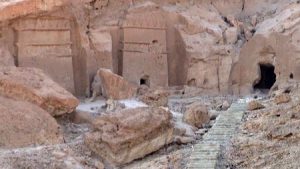 Consider, now, the choices Moses faced in his life. On the one hand he could have lived as a prince of Egypt, in luxury and at ease. That might have been his fate had he not intervened. Even afterward, having been forced to flee, he could have lived out his days quietly as a shepherd, at peace with the Midianite family into which he had married.
Consider, now, the choices Moses faced in his life. On the one hand he could have lived as a prince of Egypt, in luxury and at ease. That might have been his fate had he not intervened. Even afterward, having been forced to flee, he could have lived out his days quietly as a shepherd, at peace with the Midianite family into which he had married.
It is not surprising therefore, that when God invited him to lead the Israelites to freedom, he resisted.
So another question emerges here: Why did God know that he was the man for the task? One hint is contained in the name Moses gave his first son. He called him Gershom because, he said, “I am a stranger in a foreign land” (Exodus 2:22).
This tells you that Moses never quite felt at home in Midian. That was where he lived, but not who he was.
But the real clue is contained in an earlier verse, the prelude to his first intervention. “When Moses was grown, he began to go out to his own people, and he saw their hard labor.” (Exodus 2:11).
The book says that these people were his people. It was a transforming moment, not unlike when the Moabite Ruth said to her Israelite mother-in-law Naomi, “Your people will be my people and your God my God” (Ruth 1:16). Ruth was not Jewish by birth. Moses was not Jewish by life.
But both knew that when they saw suffering they simply could not walk away.
The famous Austrian Rabbi Meyer Abovitz called this brit goral – the covenant of faith.
It lies at the heart of Jewish identity to this day.
There are Jews who believe and those who don’t. There are Jews who practice and those who don’t. But there are few Jews, who when their people are suffering, can simply walk away saying, “this, has nothing to do with me.”
Rabbi Akiva defines those who walk away as “separating themselves from the community “and says that such separation is a sin for which you may be denied a place in the book of life.
This is what the Haggadah means when it says of the wicked son that “because he excludes himself from the people, he denies a fundamental principle of faith.”
What fundamental principle of faith?
Faith in the collective fate and destiny of the Jewish people.
Who am I? asked Moses.
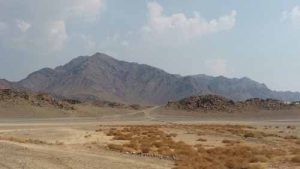 He wrestled with his soul and he argued with God. But finally, he was faced with the answer he didn’t want to hear. I will always be Moses the Egyptian and Moses the Midianite. Yet, when I see my people suffer I am forced to be Moses the Jew.
He wrestled with his soul and he argued with God. But finally, he was faced with the answer he didn’t want to hear. I will always be Moses the Egyptian and Moses the Midianite. Yet, when I see my people suffer I am forced to be Moses the Jew.
And if being Moses the Jew imposes responsibilities on me, then I must shoulder them.
So Moses went forth to meet Pharaoh
Shabbat Shalom Everyone.
Gregor Mendel and Parshah Vayetze
January 13, 2021
A Drash by David Haymer
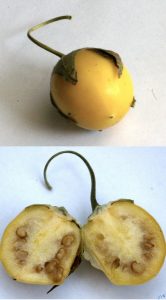 First, to echo comments made by Dan Bender and others, let me begin by saying that this Parshah is packed with dramatic events. In this one Parshah, we learn about (not in order): Jacob figuring out how to use a rock for a pillow, Jacob’s ladder (and other dreams), and Jacob looking for a wife but ending up having children with 4 different women. In this Parshah we also have Rachel taking her father’s idols and the mystery of the mandrakes. Mandrakes are flowers or plants of some sort. The word in Hebrew to describes these is a “Duda’im.” Here, some mandrakes were picked by Reuben for his mother Leah. The mandrakes are thought by many to be sexual stimulants, but Ibn Ezra cautions that they actually cause “nocturnal emissions.” Anyhow, it’s interesting that Rachel ends up getting the mandrakes, but they don’t work for her – it is Leah that gets pregnant again! Finally, as pointed out by Don Armstrong last week, we also have the continued use of deception in the interactions between the main players in these stories – more on this later. For this Drash, I want to focus on Jacob’s skill as a shepherd, specifically what he does in breeding the sheep and goats in his care. Why do I think this is important? First, I’m sure you all recall the name of Gregor Mendel, the Augustinian monk that is widely regarding to be the founder of modern genetics. I firmly believe that Mendel read about Jacob’s work with animal breeding in this Parshah, and that he benefitted from it for his own experiments (albeit with peas, not sheep).
First, to echo comments made by Dan Bender and others, let me begin by saying that this Parshah is packed with dramatic events. In this one Parshah, we learn about (not in order): Jacob figuring out how to use a rock for a pillow, Jacob’s ladder (and other dreams), and Jacob looking for a wife but ending up having children with 4 different women. In this Parshah we also have Rachel taking her father’s idols and the mystery of the mandrakes. Mandrakes are flowers or plants of some sort. The word in Hebrew to describes these is a “Duda’im.” Here, some mandrakes were picked by Reuben for his mother Leah. The mandrakes are thought by many to be sexual stimulants, but Ibn Ezra cautions that they actually cause “nocturnal emissions.” Anyhow, it’s interesting that Rachel ends up getting the mandrakes, but they don’t work for her – it is Leah that gets pregnant again! Finally, as pointed out by Don Armstrong last week, we also have the continued use of deception in the interactions between the main players in these stories – more on this later. For this Drash, I want to focus on Jacob’s skill as a shepherd, specifically what he does in breeding the sheep and goats in his care. Why do I think this is important? First, I’m sure you all recall the name of Gregor Mendel, the Augustinian monk that is widely regarding to be the founder of modern genetics. I firmly believe that Mendel read about Jacob’s work with animal breeding in this Parshah, and that he benefitted from it for his own experiments (albeit with peas, not sheep).
Some background on Mendel:
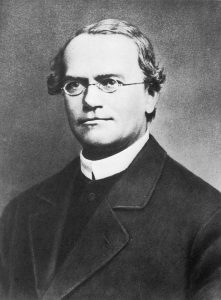 As I said, Mendel was an Augustinian monk (Augustinians are a Catholic order that dates back to 1244). He worked at a monastery in Bruun (or Brno), formerly part of Austria, now in the Czech Republic. The monastery exists today and is still a functioning Abbey for the Augustinians. Bea and I were able to visit there a couple of years ago, and it is absolutely amazing that it survived two world wars among other destructive events in history. Mendel eventually became the Abbot (head) of the monastery, and in this position, he certainly had to be familiar with the Bible. He is also known to have studied Hebrew – why else would he learn Hebrew, except to read the Bible? Mendel was also mentored in his religious work by another monk – Franz Cyril Napp, a noted Old Testament scholar. Napp himself was very interested in sheep breeding, in part because at that time it was the major industry in that region of Austria. In this capacity Napp was a member of the board of the local sheep breeder’s society, and they carried out a great deal of work on breeding different varieties of sheep. Napp also sponsored the building of Mendel’s greenhouse right on the grounds of the Abbey to allow him to pursue his scientific research.
As I said, Mendel was an Augustinian monk (Augustinians are a Catholic order that dates back to 1244). He worked at a monastery in Bruun (or Brno), formerly part of Austria, now in the Czech Republic. The monastery exists today and is still a functioning Abbey for the Augustinians. Bea and I were able to visit there a couple of years ago, and it is absolutely amazing that it survived two world wars among other destructive events in history. Mendel eventually became the Abbot (head) of the monastery, and in this position, he certainly had to be familiar with the Bible. He is also known to have studied Hebrew – why else would he learn Hebrew, except to read the Bible? Mendel was also mentored in his religious work by another monk – Franz Cyril Napp, a noted Old Testament scholar. Napp himself was very interested in sheep breeding, in part because at that time it was the major industry in that region of Austria. In this capacity Napp was a member of the board of the local sheep breeder’s society, and they carried out a great deal of work on breeding different varieties of sheep. Napp also sponsored the building of Mendel’s greenhouse right on the grounds of the Abbey to allow him to pursue his scientific research.
 I find it fascinating that this was a time (~1860s) when the church encouraged interaction with the scientific community. Mendel and his colleagues clearly did not see a divide between science and religion, instead they looked to both areas for interest and inspiration. OK, but what is my evidence that Mendel actually used the Bible in his work? Only a few of his sermons have survived, but one that he gave on Easter gives great insight into his use of material from the “Old Testament.” In the Christian world, Easter sermons usually focus on the resurrection of a Jewish guy that lived in the area of Eretz Israel during the Roman occupation of the region just over 2,000 years ago (hint: First letter of his name is J). Mendel does refer to this J guy in the sermon – but as a gardener! He also talks about resurrection, of course, but here he uses the example of growing plants from seeds. To quote from the sermon “… Man must give every ounce of his work to this effort, and then God will give its flourishing. Our beloved God gives the seed, the talent, the grace, and man has only to work, to accept the seed…”
I find it fascinating that this was a time (~1860s) when the church encouraged interaction with the scientific community. Mendel and his colleagues clearly did not see a divide between science and religion, instead they looked to both areas for interest and inspiration. OK, but what is my evidence that Mendel actually used the Bible in his work? Only a few of his sermons have survived, but one that he gave on Easter gives great insight into his use of material from the “Old Testament.” In the Christian world, Easter sermons usually focus on the resurrection of a Jewish guy that lived in the area of Eretz Israel during the Roman occupation of the region just over 2,000 years ago (hint: First letter of his name is J). Mendel does refer to this J guy in the sermon – but as a gardener! He also talks about resurrection, of course, but here he uses the example of growing plants from seeds. To quote from the sermon “… Man must give every ounce of his work to this effort, and then God will give its flourishing. Our beloved God gives the seed, the talent, the grace, and man has only to work, to accept the seed…”
 To me, this strongly parallels the instructions given to Adam and Eve by God after they leave the Garden of Eden to do their own work with the soil to grow plants, and I don’t think it is a stretch to believe that Mendel saw it the same way. But what specifically in Vayetze would have interested Mendel? Here, I believe it is Jacob’s work in animal breeding. The Parshah describes how Lavan (Jacob’s uncle and his father-in-law) first agreed to give Jacob all the spotted and speckled animals from his flocks as compensation for his work. However, Lavan then immediately proceeds to give all the spotted and speckled ones to his sons and skips out of town. What was Jacob to do? Lavan’s deception left him only animals with solid colors, most likely sheep that were pure white and goats that were pure dark (black or brown). Jacob then uses various tricks to get these sheep and goats to breed, and lo and behold, they produced speckled and spotted offspring! What did this mean to Mendel? First, Jacob showed that the sheep and goats of solid colors carried “hidden” genetic material that could produce the spotted and speckled coat color patterns. The recognition of this kind of hidden (or recessive) genetic variation later become one of Mendel’s most important contributions to genetics.
To me, this strongly parallels the instructions given to Adam and Eve by God after they leave the Garden of Eden to do their own work with the soil to grow plants, and I don’t think it is a stretch to believe that Mendel saw it the same way. But what specifically in Vayetze would have interested Mendel? Here, I believe it is Jacob’s work in animal breeding. The Parshah describes how Lavan (Jacob’s uncle and his father-in-law) first agreed to give Jacob all the spotted and speckled animals from his flocks as compensation for his work. However, Lavan then immediately proceeds to give all the spotted and speckled ones to his sons and skips out of town. What was Jacob to do? Lavan’s deception left him only animals with solid colors, most likely sheep that were pure white and goats that were pure dark (black or brown). Jacob then uses various tricks to get these sheep and goats to breed, and lo and behold, they produced speckled and spotted offspring! What did this mean to Mendel? First, Jacob showed that the sheep and goats of solid colors carried “hidden” genetic material that could produce the spotted and speckled coat color patterns. The recognition of this kind of hidden (or recessive) genetic variation later become one of Mendel’s most important contributions to genetics.
Second, in his work with peas, Mendel also first spent years establishing varieties of the plants that were pure breeding for various characteristics before he did his famous crossing experiments. If he had not done this, and instead used impure strains of peas (like Jacob’s animals), he would have never been able to make sense out of his experiments. My intention now is to try and find more of Mendel’s sermons to see if they contain additional biblical references, even if we have to go all the way back to the monastery at Brunn to try and find them! In the meantime, thanks to all of you for encouraging me to explore this connection between science and religion that I find fascinating.
Dualities: Vayishlach Drash
January 13, 2021
By Fran Margulies
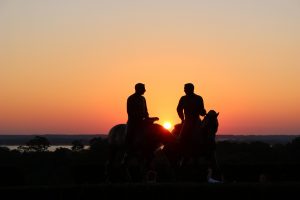
Jacob/Israel, one of our founding fathers, comes to us out of our mythic past. I say “mythic” because I think his story fits the dictionary definition of myth as “an ancient story of an ancestral hero who serves as a fundamental type in the world view of a people.” So how is his story fundamental to us? Well, for sure he is heroic, moving a giant boulder that blocks a well, falling passionately in love with a beautiful woman, wrestling an opponent during a night long battle. Was it a draw or a victory?
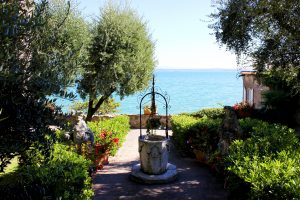
Whatta guy!
But his story is more complicated, so let’s look further. I said “Whatta guy” because, at first, it seems the Jacob story is a masculine one, emphasizing physical strength, dominance, and courage. But as it develops, it does move inward and deeper and becomes about human nature. The first most striking thing about this story is all the doubling in it!

Everything happens in twos! It starts with twins struggling in Rebecca’s womb. It continues with two brothers of contrasting appearance, one hairy, the other smooth, one indoorsy, the other a hunter. Jacob has two wives, one beautiful, the other flawed, one very fertile, the other almost barren. Jacob himself is both impulsive and patient, falling in love at first sight, but then willing to work free for twenty long years to pay his bride prices.
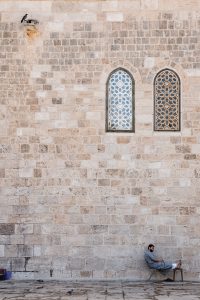
In competition with Laban he divides his flocks in twos, strong and weak, speckled and dark. On his voyage home, he divides his belongings into two camps. Most striking, of course, is in his double name, both Jacob and Israel. And even more striking is the fact that the text continues to use both of his names even after he is renamed! At the end of his life, we see a cross-handed, DOUBLE blessing of his two grandsons, Ephraim and Menassah.
I note also that Esau’s anger and bitterness turn unexpectedly into the opposite, a generous and surprising welcome to his brother!
Jacob does have a strong sense of God’s providence throughout his story. Yet even that is opposed and doubted. He needs reassurance! On his journey from home, he bargains: “If you will protect me, God, I will worship you and build you an altar!” On his journey back home, even though now a big man, rich and successful, he still wheedles and bargains with God: “Katonti!” “I am small – Please help me! Don’t forget – you promised!”
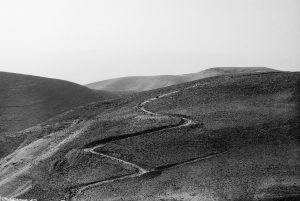 Jacob runs away from danger at the beginning, then stands and faces it at the end; he has a nighttime struggle before fording the cross currents of Jabbok River as it joins the Jordan! His mysterious opponent is, we are told, both human and divine.
Jacob runs away from danger at the beginning, then stands and faces it at the end; he has a nighttime struggle before fording the cross currents of Jabbok River as it joins the Jordan! His mysterious opponent is, we are told, both human and divine.

I propose that all of these oppositions are not only dramatic but they give energy and drive to the story. You need a positive and a negative to have an electric current. Jacob was a man who was both bad and good, who cheated and in turn was cheated.
So how then is this story fundamental to our religion, to us? How does Jacob tell our story? Well, opposites together make a whole. The struggle may be fierce but the whole continues, is stable. Think Yin and Yang, black and white shapes entwined within a single circle.
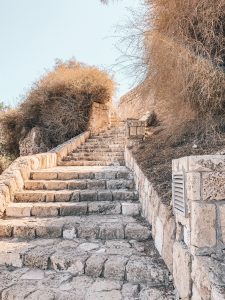
William Faulkner said in his Nobel Prize speech that he needed to write about the “human heart in conflict with itself.” Well, this story and Judaism is indeed about that! We have battled outside enemies through all of our history. We argue with each other all the time. And we have never been afraid of confronting our inner selves and the frightening mixture of motives we find. Underlying it all is a sense of a larger encompassing wholeness, a sense that somehow all of opposition fits into the single divinity which sustains it all.
Vayera: Inquiry or Seeking
November 29, 2020
A Drash by Carolann Biederman
 My drash is dedicated to the enthusiastic members of our Sof Book Group, who offer insights, inspiration, opinions, reflections and their personal stories, related to the discussion of the book at hand. Everyone has a voice and the space to express it. Together we’ve read 115 books, so far. The group, which I’m privileged to moderate, was founded in 2005, and it’s still going strong on Zoom. In another time, we would have a Shabbat book exchange during the oneg – but maybe next year. Thank you all and thank you to everyone who helped me prepare for the drash. It’s also Jewish Book Month sponsored by The Jewish Book Council. The Council is the longest-running organization devoted exclusively to the support and celebration of Jewish literature. Book Month is a reminder of the vast array of amazing stories waiting to be discovered. Our Book Group selections and, our “first book,” the Torah, offer readers meaningful themes, lessons, actions and their consequences. We are challenged to discover our own insights through words, situations, and choices of the characters.
My drash is dedicated to the enthusiastic members of our Sof Book Group, who offer insights, inspiration, opinions, reflections and their personal stories, related to the discussion of the book at hand. Everyone has a voice and the space to express it. Together we’ve read 115 books, so far. The group, which I’m privileged to moderate, was founded in 2005, and it’s still going strong on Zoom. In another time, we would have a Shabbat book exchange during the oneg – but maybe next year. Thank you all and thank you to everyone who helped me prepare for the drash. It’s also Jewish Book Month sponsored by The Jewish Book Council. The Council is the longest-running organization devoted exclusively to the support and celebration of Jewish literature. Book Month is a reminder of the vast array of amazing stories waiting to be discovered. Our Book Group selections and, our “first book,” the Torah, offer readers meaningful themes, lessons, actions and their consequences. We are challenged to discover our own insights through words, situations, and choices of the characters.
Vayera וירא is the fourth chapter of Genesis. The title comes from ראה – (rah ah) to see. It’s one of the most dramatic, action-packed portions, and includes seven heavenly / human interactions. The main characters are:
- The Lord, in direct dialogue with Abraham, and with other men and women through angels, dreams and visions.
- The three heavenly messengers.
- Abraham and Sarah, and later, Isaac.
- Abraham’s nephew Lot and his family.
- Assorted Kings of the fertile Jordan Plain.
Today’s reading, Genesis בראשית 19:1 – 20:18 is sandwiched between Sarah’s laughter regarding her motherhood, Abraham’s negotiations with the Lord and two Kings, the birth of Isaac, and the Akedah, the binding of Isaac. There is a LOT going on. This parashah reminds us of the Lord’s power to destroy what he’s created, and instructions about kindness to others, morality and immorality, using Abraham, Lot and the Sodomites as examples. My focus is on Lot and his family, to highlight hospitality and generosity as guiding principles – the mitzvah of welcoming strangers – within the Jewish mandate to repair the world. The theme is echoed in today’s haftarah. But I won’t ignore behaviors that led to the catastrophic destruction of Sodom, Gomorrah, and the other cities of the plain.

Prior to this portion, Lot is portrayed in relation to his uncle Abraham. Lot has benefited from this relationship and grown wealthy, and his path parallel’s Abraham’s, but not completely, and with very different results. The word Lot לוֹט can be translated as “to wrap, to cover, to conceal,” which hints that his ability to see clearly is compromised. How does this square with what Lot sees in Genesis 13:10, Lekh L’kha? This earlier information reminds us of the lushness of the Jordan plain, the richness of the land, and the wealth and comfort in which Lot was thriving. “And Lot raised his eyes, and he saw the entire plain of the Jordan, that it was entirely watered; before the Lord destroyed Sodom and Gomorrah, like the garden of the Lord, like the land of Egypt, as you come to Zoar.” This passage helped me to visualize the depth of the destruction to come, which turned a land akin to Eden into one of barrenness and desolation. Let’s assume Lot learned by observing Abraham: which actions lead to a righteous life. Yet, when they go their separate ways, Lot chooses to move his tents closer to Sodom, on the plain, and then into a home in the city.
There is a physical and symbolic distancing between Lot and Abraham. Abraham has vision: his hospitality to the “men” (אנשים – anashim) starts the parashah. Abraham hears of the Lord’s plan for destruction, pleads the case for Sodom, and bargains down to spare it for the sake of ten righteous people. Lot has vision: he is able to see the “men,” though we see the word used as messengers/angels מלאכים – malachim who arrive at the gate in Sodom. He invites the “men” then strongly insists that they come to his home and rest. (And the text returns to (אנשים – anashim).

Lot’s mitzvah of offering hospitality to the strangers is mixed up with a confusing message that comes next, about sexual and moral practices. This is the situation: Genesis 19:5, “And they called to Lot and said to him, “Where are the men who came to you tonight? Bring them out to us and let us be intimate with them.” Is this the Sodomite custom of hospitality – gang rape? Lot offers his daughters as sexual substitutes, and the angels intervene and stun the Sodomites with blinding light. They offer Lot and his family a path to flee before the destruction begins. And yet… Lot’s sons-in-law and two married daughters like it just fine in Sodom. Lot hesitates, as do his wife and the two unmarried daughters. They must be taken by the hand to get them moving out of the city to safety.
This is the result: Genesis 19:29, “And it came to pass, when God destroyed the cities of the plain, that God remembered Abraham, and He sent Lot out of the midst of the destruction when He overturned the cities in which Lot had dwelt.” Does this imply that instead of ten good men, there was only one good man – Lot? Or is Lot saved only because of his relationship with Abraham? There is certainly harsh judgment for Lot’s nameless wife who pauses to look back. Instead, can we see her showing compassion for those left behind, longing for her family, friends, and the life she’s leaving? Thinking about Genesis 19:33-38, how about the nameless daughters, sole survivors in a cave with Lot, who connive to have sex with their father to continue their own line – that resulted in the birth of Moab (meaning “from father”) — “he is the father of the Moabites” and Ben-ammi (meaning, “son of my kin”) — “he is the father of the Ammonites.”
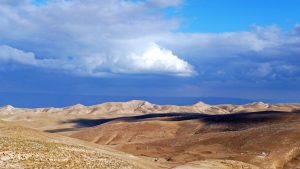
I have no answers and choose not to judge. On the surface, the Sodomites’ failings seem to be: initiating violent attacks on strangers, being eager and ready for their normal custom of gang rape, and expressing indignation that Lot, a new resident but now shunned as a stranger, attempts to impose his morals on their behavior. There’s another insight, revealed later in Ezekiel 16:49, “Behold this was the iniquity of Sodom your sister: pride, abundance of bread, and careless ease were hers and her daughters’, and she did not strengthen the hand of the poor and needy.” What stays with me is the practice of hospitality and kindness to strangers, the poor, and needy, with Abraham as an exemplary role model.
These stories are frequently repeated in the Torah. From the mistakes of the people of Sodom, we can learn the essential character traits that allow one to live in balance with the Creator and creation. What’s the takeaway? Lot is portrayed as both a solid citizen and a flawed human being. Every day, like Abraham and Sarah and Lot, we are faced with myriad choices and make decisions; do we see clearly how to live a good life and come closer to Ha Shem; or do we slip, shift, stumble, fall — and then, try again. I’m inspired to strive every day to find balance and draw closer to Ha Shem with joyful gratitude for the gift of life. Wishing the same for you.
A Biological Perspective on Parshat Noah
November 3, 2020
By David Haymer

The story of the flood and its aftermath in Parshah Noah represents, in many respects, another creation event. The flood wiped out much of the life existing at that time. From a biological perspective, this was a mass extinction event, and we know that such events have occurred in history. Millions of years ago, for example, the Permian extinction wiped out most of the life on earth. Each of these events is, however, always followed by a flourishing of new life. This too is reflected In Parshat Noah in that immediately after the flood, God again tells us to be “fruitful and multiply”, and that there will animals, birds and fish on the earth. For us in particular, this commandment is fulfilled through a lineage from Noah’s son Shem that goes all the way to Terah, the father of Abram (later Abraham). Finally, in what first may seem like an interruption, we are also told here, through the Tower of Babel story, how our lineages will spread throughout the world into new habitats created by the subsiding of the flood.
Another of the important biological lessons to be gleaned from the Noah story is that we can prepare for mass extinction events by preserving either whole individuals, or at least material from them, in order to reestablish life after an environmental catastrophe. Noah did this by building an ark to bring his wife, their sons, and their sons’ wives, along with males and females of other living things to repopulate the world. For animals, Noah was told specifically to bring one pair of the “unclean” animals and seven pairs of the “clean” animals (Genesis 7:2) to help maintain a diverse collection of living things in the world to come. In part because of this description, Noah’s ark has been thought of as something akin to a zoo. But this analogy is weak in that zoos are primarily designed to exhibit animals, and they have had only limited success in saving or replenishing forms of living things threatened by extinction. Perhaps a better way to think of this part of the Noah story is that it inspired us to create modern versions of the ark in the form of repositories designed to preserve the “germplasm” or genetic material of different organisms. Such germplasm repositories have been built around the world. They store frozen sperm, eggs, cells, and whole embryos of different living things with the idea that in the event of environmental catastrophes, this material can be used to reestablish these forms of life for the future.

The rainbow is another important element of the flood story. A rainbow is a beautiful thing to behold, and it is described as the promise of God that such a catastrophic flood will not occur again. But the rainbow also contains material for biological lessons. What do you need to form a rainbow? At a minimum it requires light and water, both of which are essential for life. The water comes in the form of rain. This is important because although vast oceans on our planet may be the crucible where life began, its waters must be cleansed through rain cycles to provide for our continued sustenance. The other essential ingredient, the light, comes from the sun. This light warms the earth and drives photosynthesis, the biological process that is the basis for most of the food chains on our planet. Finally, when we look up and see a rainbow, we also see projected in the sky an incredible spectrum of colors contained within the sunlight. This effect is produced by filtering the sunlight through rainwater droplets in the same way that a prism separates visible light into different wavelengths. Many of the diverse plants and other living things we have on our planet utilize these differing wavelengths of sunlight to maximize photosynthesis. In these ways, the rainbow can also serve as a reminder that we will continue to have what is needed for life to flourish.
Bereshit
November 3, 2020
A drash by Robert J. Littman
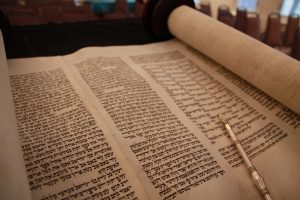
This week we begin again the annual reading of the Five Books of Moses in synagogues the world over with Bereshit. We hear about the creation of the earth, sky, and land, the creation of man and woman and the Garden of Eden and the expulsion from it. The Hebrew Bible stands as a history of the people of Israel, beginning with Abraham. The Five Books of Moses tells us the story of Abraham from the middle of the second millennium BCE, down to the death of Moses in the 13th century BCE. It is more than a narrative history; it is a sacred history–sacred in that it is story of the encounter of our ancestors with God, and their interaction with Him. It is also a tribal history. The ancient Israelites organized themselves into patrilineal kinship groups. They divided their societies into tribes and clans. Membership in those groups was measured from a common male ancestor. The Five Books of Moses tells the history of those kinship groups. Abraham begat Isaac, Isaac Jacob and Jacob 12 sons. Those children became the eponymous founders of the 12 tribes of Israel. All Israelites knew what tribe they belonged to and so all Israelites could trace their origins back to Abraham. Patrilineal kinship groups also take in new members. From whom do these new people descend? We get a clue when we give a Hebrew name to a convert to Judaism. The convert chooses a Jewish name, which exists in the form , ___son (daughter) of _____. Since there is no Jewish father, all converts become the son (daughter) of Abraham avenu-“Abraham our father” and are adopted into the lineage so that they have the honored place of being direct descendants of Abraham.
We as human beings are curious and want to know our origins-and so we want to know from whom Abraham is descended. So the first section of Genesis is added to this genealogical sacred history. Abraham’s patrilineal ancestors are traced back to the first man, Adam. God created Adam, and then Eve from Adam’s rib. Thence the male descendants of Adam are listed, generation to generation, down to Noah. After Noah and the flood, the descendants of Noah are listed down to Abraham. Thus it is a simple exercise create a family tree through the male from Abraham back to Adam. Since we as Jews can trace our descent from Abraham, we too now can trace our descent all the way back to the first man. When I was a young schoolboy and began the studies of other non-Western cultures, I learned their origin stories were not set in the Middle East. Polynesians see the origin of man in Polynesia, not somewhere at the opposite side of the world. We know from science that man originated in Africa, not in the Middle East. Then how can we regard the origin myths of the Garden of Eden, which Genesis locates in present day Iraq, bordered by the Tigris and Euphrates rivers? Once we understand that our ancestors were Semites, who originated in the Near East, the answer becomes clear–that is the only part of the world that they knew.

The text of Genesis itself says Abraham came from Ur of the Chaldees (an anachronism since Chaldees did not exist at the time of Abraham). “Ur” is a Babylonian word for “City.” Many Babylonian cities bear the name of Ur. Abraham came from one of these, perhaps in Syria or in Babylon. The origin stories are permeated with Babylonian culture and religion. Babylonian religion was polytheistic. Early Israelite religion was henotheistic – the belief that there was one god for the Israelites. The religion becomes monotheistic in the first millennium BCE. In incorporating Babylonian polytheistic beliefs into the creation stories, the polytheistic elements were removed. Genesis calls Eve “the Mother of All Living Things.” Her name itself means “life.” Eve looks like a demoted mother goddess. Mother goddesses in Babylon and the Near East were also often depicted with a serpent consort or aid. Thus the Babylonian images are clearly present.
The Garden of Eden becomes a story of the creation of human consciousness – the woman/mother goddess Eve makes an insentient race into “mankind” by giving him knowledge. But man cannot both possess immortality and knowledge because he would be god. So God, to prevent other gods, takes away man’s immortality by expelling him from the Garden. The allegorical nature of the story also can be seen in the name of Adam. Sometimes he is called “Adam” and sometimes “The Adam.” Clearly Adam stands for more than just a name. Perhaps we should translate his name as “Earthling” to capture the Hebrew “adamah” earth. So how do we as Jews today see the story of creation and Garden of Eden? Perhaps it is best to regard it as our ancestors’ attempt to understand the origins of man through their incomplete understanding of science and the universe. It is not a mistaken explanation, but rather an explanation filtered through their eyes at that time. New knowledge lets us react in new ways to the interaction of God and men in new language. Besides, our ancestors may have gotten some things right – we believe in the Big Bang, and they wrote “God said: Let there be light.”
Inviting the Presence: A Drasha for Rosh HaShanah 5781
October 2, 2020
By Reb Daniel Lev
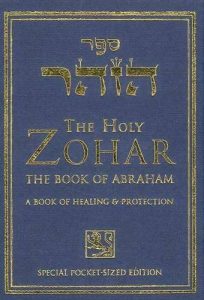 In Deuteronomy 30:11-14 it says: “For this commandment which I command you this day, it is not too hard for you, neither is it far off. It is not in heaven, that you should say: ‘Who shall go up for us to heaven, and bring it unto us, and make us hear it, that we may do it? Neither is it beyond the sea, that you should say: ‘Who shall go over the sea for us, and bring it to us, and make us hear it, that we may do it? But the word is very close to you, it’s in your mouth, and in your heart, that you may do it.” If the word of G-d is so close, how come I can’t usually hear it or feel it? First, let me ask: Who or what is G-d?…..What a question!. I want to point to one way of understanding spirituality. Some of you know that we’ve had many Jewish views of what G-d is. Since I’m going to be talking about G-d, who is and is not a He or a She, I will avoid the binary by referring to G-d as both He and She, so don’t get confused – I also will at times refer to G-d by the traditional Hebrew name, HaShem – which means “the name. Let’s briefly look at how the Zohar, a powerful mystical commentary on the Torah, interprets the first line in Genesis. Traditionally, the first line is translated as: breisheet bara elohim, “in the beginning G-d created.”
In Deuteronomy 30:11-14 it says: “For this commandment which I command you this day, it is not too hard for you, neither is it far off. It is not in heaven, that you should say: ‘Who shall go up for us to heaven, and bring it unto us, and make us hear it, that we may do it? Neither is it beyond the sea, that you should say: ‘Who shall go over the sea for us, and bring it to us, and make us hear it, that we may do it? But the word is very close to you, it’s in your mouth, and in your heart, that you may do it.” If the word of G-d is so close, how come I can’t usually hear it or feel it? First, let me ask: Who or what is G-d?…..What a question!. I want to point to one way of understanding spirituality. Some of you know that we’ve had many Jewish views of what G-d is. Since I’m going to be talking about G-d, who is and is not a He or a She, I will avoid the binary by referring to G-d as both He and She, so don’t get confused – I also will at times refer to G-d by the traditional Hebrew name, HaShem – which means “the name. Let’s briefly look at how the Zohar, a powerful mystical commentary on the Torah, interprets the first line in Genesis. Traditionally, the first line is translated as: breisheet bara elohim, “in the beginning G-d created.”
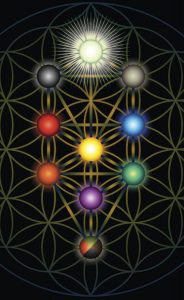
The symbol of Kabbalah, the Tree of Life, is nested here in sacred geometry, the ancient Flower of Life matrix.
However, in creative rabbinic fashion, the Zohar reads this differently: “With beginning He created G-d.” I have to ask: “Who is the He that created G-d?” The word bara can mean “he created or it created.” The Kabbalists, Jewish mystics, would answer that it was the eyn sof who created G-d. Eyn Sof means the “Never-ending One,” referring to the Source of the Universe…a neutral name beyond words and images. To the mystics, this is what G-d is all about. Since this teaching from the Jewish mystical tradition – the Kabbala – calls into question our usual understandings of G-d I’ve had to consider another definition.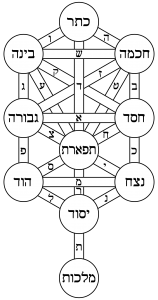
Here it is: HaShem, G-d, is our capacity to bring sacred Presence into the world, or at least to develop our awareness of the Presence. To illustrate this, I want to take an example from paganism. My blessed, departed teacher, Rabbi Zalman Schachter-Shalomi (alav ve-shalom), told astory of about the great 19th-century Hindu saint, Ramakrishna. One day he was standing before a statue of the goddess Kali and he knew that he was only standing before a stone statue – the goddess was not there. Then Ramakrishna began to pray to Kali and open up his heart to her as the god-essence he wished to be close to – and in no time the statue filled with the spirit of Kali. Now I know that’s a hell-of-a thing for a Jewish rabbi on Rosh HaShanah to talk about! However, there is a deep truth in it. From a Jewish spiritual perspective, one can say that HaShem is everywhere and in everything. But we are not always on the level to be aware of Her Presence that stands before us. For that to happen, we must invite HaShem to fill our life in each moment. As it says in Psalm 16:8, “Shviti HaShem lenegdi tamid,” “I will place HaShem before me always.” We must use our natural capacity to bring up into our awareness the sacred Presence. We can do this at home, or in nature, or even here in our service with a zoom screen in front of us, like we’re watching “Temple TV” or we just turned to the “Rosh HaShanah Channel.”
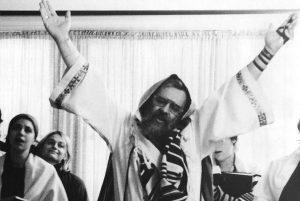
Even here we can bring our attention to focus on our intention that the Eyn Sof, the Infinite Presence is before us: Right here, right now. Like the Hindu saint, we can invite the Spirit of the Holy One into this prayer moment, filling everything with His presence. And, as Jews, we don’t need a statue to do that.
Recently I was very ill with a non-Covid flu. That didn’t make it any less miserable to endure the month it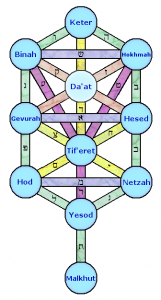 lasted. On the one hand, I could have just rolled around and felt sorry for myself, which I did on occasion, and then eventually it would be over and I’d say “glad that’s over” and “let me get back to life, damn it! “ On the other hand, being kind of a religious guy, I directed my prayer toward HaShem and invited Her to join me in the middle of my pain and suffering. In time, just like the statue of Kali filling with her spirit, my body started to fill with a feeling of The Presence of HaShem. I’m bringing this up today because we are all afflicted by the pandemic and its negative outcomes. It is hitting us in our kishkas – in our guts. So the question is: “How do we get through this?” What can we do beyond following all the safety measures? Well, speaking as a spiritual kind of guy I’d encourage all of us to take a chance and open ourselves to the Presence of HaShem – however you may think of her: maybe as a classic Deity, or Lover and Friend, or Nature, or the Eyn Sof, or the Force, or even as the fabled Cosmic Muffin. Invite Him in, however you conceive of Him. Because as you do this, you can receive the healing and renewal you need during these challenging times. Times that challenge our health, our politics, our livelihoods and our loved ones.
lasted. On the one hand, I could have just rolled around and felt sorry for myself, which I did on occasion, and then eventually it would be over and I’d say “glad that’s over” and “let me get back to life, damn it! “ On the other hand, being kind of a religious guy, I directed my prayer toward HaShem and invited Her to join me in the middle of my pain and suffering. In time, just like the statue of Kali filling with her spirit, my body started to fill with a feeling of The Presence of HaShem. I’m bringing this up today because we are all afflicted by the pandemic and its negative outcomes. It is hitting us in our kishkas – in our guts. So the question is: “How do we get through this?” What can we do beyond following all the safety measures? Well, speaking as a spiritual kind of guy I’d encourage all of us to take a chance and open ourselves to the Presence of HaShem – however you may think of her: maybe as a classic Deity, or Lover and Friend, or Nature, or the Eyn Sof, or the Force, or even as the fabled Cosmic Muffin. Invite Him in, however you conceive of Him. Because as you do this, you can receive the healing and renewal you need during these challenging times. Times that challenge our health, our politics, our livelihoods and our loved ones.
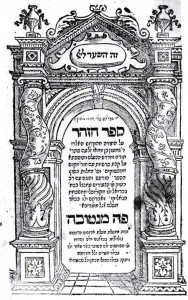 As you invite in the Presence today, now, in any way you choose, you’ll eventually feel lifted up during the service and this, among other experiences, can help you enter the New Year in a new strong way of your own. By opening up to something larger than our daily ego we can enter the Holy, raising our consciousness to a higher level than it was last year. In part that’s what Rosh HaShanah and Yom Kippur are all about. So I want to bless you – and please bless me back – that this Rosh Hashanah, during any of the Marathon services, while the Hebrew prayers are flying fast and furious, that you take a moment, with your eyes open or closed, to stop from time to time and allow yourself to open up to the Source of the Universe, for even 5-minutes, to invite her to fill you up, or to bless you with a deep awareness of Her Presence. I bless you that you allow yourself become mindful of of the Presence….and even if you think you’re just imagining things, that you act “as if” it’s real, if that gets you through. And I bless you that as you do this, you’ll become pleasantly surprised at what beautiful things you can discover on this Rosh HaShanah.
As you invite in the Presence today, now, in any way you choose, you’ll eventually feel lifted up during the service and this, among other experiences, can help you enter the New Year in a new strong way of your own. By opening up to something larger than our daily ego we can enter the Holy, raising our consciousness to a higher level than it was last year. In part that’s what Rosh HaShanah and Yom Kippur are all about. So I want to bless you – and please bless me back – that this Rosh Hashanah, during any of the Marathon services, while the Hebrew prayers are flying fast and furious, that you take a moment, with your eyes open or closed, to stop from time to time and allow yourself to open up to the Source of the Universe, for even 5-minutes, to invite her to fill you up, or to bless you with a deep awareness of Her Presence. I bless you that you allow yourself become mindful of of the Presence….and even if you think you’re just imagining things, that you act “as if” it’s real, if that gets you through. And I bless you that as you do this, you’ll become pleasantly surprised at what beautiful things you can discover on this Rosh HaShanah.
Shanah Tovah!
Rosh HaShanah Drash: 9.20.2020
October 2, 2020
By Avi Soifer
In a time of crisis: “Don’t just stand there, do something!”—A response, I think from Truah: Don’t just do something, stand there. I think of the ancient religions of Mesopotamia: “[T]he sign of the god or goddess is the capacity to raise the hand to the ear and hear what another is saying.” I think of Rabbi Heschel and the need to be attuned to hear “the silent sigh.” George Hudes, in a drash several years ago, compared hearing to seeing—to George, hearing as “the most intimate and powerful language of hope.” And there is the old philosopher’s chestnut: “If a tree falls in the forest and no one hears it, did it make a sound?” Sadly, we know that even if it didn’t make a sound, that tree and countless others may very well make a raging forest fire.
Listening and Standing Up:
Take your time to stand there and listen, and do so with care and attention to nuance, and then act. And grasp the obligation to be an upstander, rather than a bystander. Do something, even if it is out of the ordinary, even if it is not neutral. Still, do it with care for others: with kindness.
Sof Ma’arav coalesces important little things, and Rabbi Rosalind fits right in. Sof Maʻarav coalesces summer camp and the Dali Lama, differences, but with group spirit, with Sandy as the ultimate camp counselor. I think of Sid’s recent drash: stories and memory equal identity; and we are a nation of storytellers, often with a humorous twist, even if it is bittersweet.
Zoom and a pandemic, or a pundemic, for example:
- Tell a quarantine joke, but you’ll have to wait 2 weeks to get it—and there will be a test.
- Only inside jokes.
- Quaranteens in 2033.

Alyssa Masor
There are Neo-Hasidic tales— Alyssa Masor, wrote a Columbia University PhD thesis about “Neo-Hasidic Tales” in 2013. Yiddish writer I.L. Peretz wrote “And Maybe Even Higher” 120 years ago, while Peretz was imprisoned for three months for giving an unauthorized talk to workers.
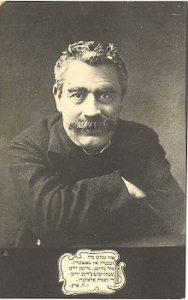
I.L. Peretz
Then we have the Nemirover Rebbe, who would disappear every year during the Yomim Noraim, the High Holidays. His followers were sure he went to heaven to battle Satan over all their sins. But then a dubious Litvak came to town. Litvaks were thought to cram their heads full of Talmud and explicit text, leaving people with their mouths open, but they were said to lack appreciation for ethics. Just after ma’ariv on Rosh Hashanah, this Litvak sneaks into the Rebbe’s house and lies under his bed. Towards morning, as the household gradually awakens, the Rebbe lies in bed and groans for over an hour: “To hear the Rebbe’s groan would dissolve you in pity. But a Litvak’s heart is made of iron.” So he lies there, and finally the Rebbe arises, washes and prays, and gets out a bundle of peasants’ clothes. The Rebbe puts on the clothes, with a big rope in the pocket of the coat, and he grabs an axe on the way out of the kitchen. You can guess what follows: He chops down a tree, cuts up the wood so it is small enough to fit in a stove, and goes to the broken-down house of a lonely widow. He claims to be selling wood, but she has no money. The Rebbe speaks in peasant dialect, says his name is Vasil, and that she need not pay him immediately because he knows she will be good for the six groshen. She doubts, but he says, “What? I have faith in you for the six groshen, but you don’t have enough faith in God that He will arrange?” He sets the fire and says the correct penitential prayers, with a groan. And the wise-guy Litvak stays and becomes a Nemirover Hasid himself. One of the Hasidim tells others that when the Rebbe disappears each morning on the Yomim Noraim, he goes to heaven. The Litvak says, quietly, “And maybe even higher.”
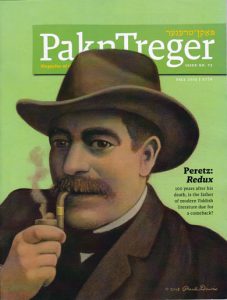
I. L. Peretz, Cover of PaknTreger
Thinking about this story:
It reminds us of the critique of Hasidim at the time: that they had too much faith in the Rebbe, in miracles, in dynastic succession, that there was too much drinking, and oppression of women. This is reminiscent of the Protestant attack on the Catholic Church during the Reformation.
Lessons here?
Trust in the Rebbe, even if he is not doing what the rules say—social justice is trump (and I use that phrase with care). There is no magical realism here as there is in Sid’s great stories in his new book. After all, Walter O’Malley really was the Satan, for moving the Dodgers out of Brooklyn.
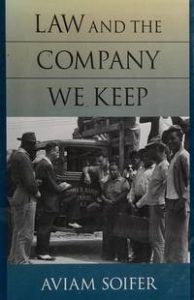
Cover ot Avi Soifer’s book
I reflect on Justice Ginsburg here, and about my book, Law and the Company We Keep, and concerns for the community from 25 years ago. When is a community not a cult, or an oppressive multinational corporation? As Frederic Maitland says: “[C]ollectively… is the smudgiest word in the English language.” And, in Bob Goldman’s second book, lovingly and posthumously published by Judy last year, Bob emphasizes a “richer sense of self” of the sort that one could find in Ancient Israel, one that tethers a person to the group’s future. Bob in turn connected this to Albert Einstein’s theory of time, and in timely fashion to the Jewish concept of olam.
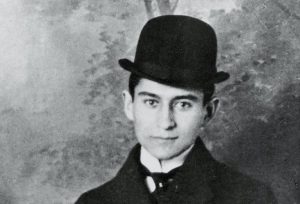
Franz Kafka
Within Jewish communities, of course, there have traditionally been arguments, schisms, and worse. Often they involved personalities; sometimes they revolved around core arguments such as whether redemption could or could not be hastened through human agency. Bob Goldman quoted Kafka, however, noting that “The Messiah will come only when he is no longer necessary.” And Einstein believed that “We cannot stand aside and let God do it.” We are lucky, fortunate, blessed to have some room and some protection for our own little, eccentric, and beloved community. On remembrance: I think of the Baal Shem Tov’s words about redemption. But Kafka says, “Even the past has to be earned.” Heschel says, in “On Linking the Generations:” “The authentic individual is neither an end nor a beginning but a link between ages, both memory and expectations….To us, recollection is a holy act; we sanctify the present by remembering the past. To us Jews, the essence of faith is memory. To believe is to remember.” Yet there is a wonderful Midrash: God had to issue a recall for the world to return to his shop, because he forgot to include the ability to forget.
Thinking of MJB and our own crucial intangibles:
How wonderful it has always been to see Sandy’s welcome to newcomers; Hefcibah and Matt helping Marv to his seat when he arrives; the give and take while setting up the kiddush; gossip, but my mother’s “character analysis;” the personalized shabbat shalom; the minuet of cars waiting or not in the parking lot and the conversations en route. But, undaunted, we persevere via Zoom (Golly, Golly): Just since July 4th, for example, we have enjoyed talks by Hefcibah and Naomi about leadership, zealousness, and the problematic role of Ha’shem. Malka moved everyone present—even via Zoom—with her thanks to our community in the context of her crossing of thresholds, and Beah underscored simple caring as a storied basic distinction between heaven, and the less appealing destination. Marc Flitter and Dan Lev illustrated the intriguing intersection of the brain and the psyche, respectively aided, by Greggele’s brilliant teaching of Talmudic reasoning and Dan’s inspiring introduction of mystical thought. And Sid recently made what many of us thought to be a profound connection between storytelling and memory to help create Jewish identity.
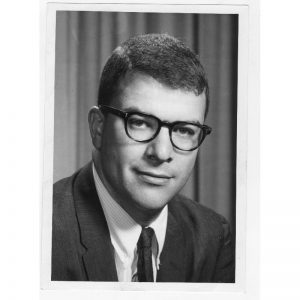
Leonard J. (Liebel) Fein
Leibel Fein says: “We are the tribe that discovered the universal God, but chose to remain a tribe.” We live “where particularism and universalism intersect.” And Leibel characteristically went on to say, “Never again is, after all, an insufficient slogan. It tells us what to avoid, but not what to embrace.” But here is what Leibel wrote in response to the ending of U’ntaneh Tokef: “I am moved by this prayer perhaps more than by any other, but I will not accept its concluding words. Yes, the grass withers and yes the flowers fade and yes the cloud dissolves … but that dream does not vanish. What it comes down to is intentionality, to remain what we have always been, a stiff-necked people that despite the mayhem, dares to speak truth to power, to preserve the capacity for indignation. Not to allow the dream to vanish, but to breathe life into it, to nurture it and to make sure that new seed has been planted, new dreamers have been raised up.” Stella and Shmulik and hope, for example. “And along the way,” Leibel added, “to make sure to feed the hungry and clothe the naked, to visit the sick and comfort the bereaved, to dispense justice in the gates of the city, to be gracious to the stranger in our midst, and always to seek peace; to repair the breach. These are all that we have …that will perhaps defeat the evil decree.” In Isaiah 51:7, we read, Not a book, but “a voice, a Torah within the heart.” And Yehuda Amichai tells us, “I assert with absolute faith that prayers preceded God. / Prayers created God. / God created humans. / Humans create prayers that create God who creates humanity.”
On the Paradox Of Paradise
In 1948, Rabbi Goldfarb identified the core challenge to be: “Can we attain a healthy, mature outlook on religion? The answer depends on the use of our eyes to behold the affirmation of God in the world of nature and to hearken to the divine reverberations within our own soul.” Goldfarb says: “Not I/Thou but We/Thou”—collective consciousness, after Heschel.
Sally Morgan reminded us of the commandment against group hate in her parshah: “Do not despise the Egyptian, because you were a stranger in his land.” She mentioned, quoting Rabbi Jonathan Sacks, that Jews have been subjected to racism more and longer than any other people.
That’s Sof—and that’s The Sof.
L’Shana Tovah ticatevuh v’tichateymuh!
Shelach Lecha
July 9, 2020
A Drash by Fran Margulies

Rabbi Goldfarb used to say, if you don’t stand for something, you will fall for anything. Makes sense. Sometimes, the ground shifts under you; you lose your balance and you can’t steady yourself. I think our world is at such a moment. Covid-19 has shaken our ground. How to keep going? Open your shops for business for income? No! People will spread the virus. Keep them closed? What to do?
Our Parsha occurs in another unstable time. The Hebrews are poised at the base of the mountain range. On the other side is the land that God promised. Almost home! But not quite yet. Still, for weeks now, shvitzing in the desert, their way forward has not been clear, even with God leading them. We even read that Moses begged his father-in-law to camp with them and guide them. Perhaps sensing his uncertainty, God directs Moses to reconnoiter. Shelach Lecha! Send for yourself, scouts to go ahead, see the lay of the land and report back. So Moses does. He sends off a distinguished contingent of tribal leaders with encouraging words: “Vehitchazachtem!” Be strong and of good cheer! Bring us back samples. Maybe some native fruits? The scouts disappear over the mountain and do not reappear for the proverbial forty days. The people wait, worried, on edge. They mill around and fend off wild animals. The scouts return and oh Lordy! Their reports conflict. Yes a good land IS over the mountain. It is rich and fertile, but other tribes have settled in that valley already; those other tribes are dug in and fortified.
Uh Oh! The people look at each other. They shuffle their feet and start murmuring. Caleb, one of the scouts and prince of the tribe of Judah, steps in. “No worries!” he says, “Nothing we can’t handle! We are fighters!” But the other scouts disagree. Could they have been genuinely afraid? Perhaps so. But their motive is unclear to me. Yet the Torah is clear. They were seeing with prejudiced eyes. And reporting with malice. These scouts were spreading “dibat;” slander and deliberate lies. Their rhetoric revved up, it got wilder and more purple. “This land devours its settlers; its people are monsters and giants! Just looking at them made us shrivel. We felt small as grasshoppers-surely we looked like that to them!” Now the people really panic. The ground has shifted beneath them! No way forward! That census was a waste of time! Shall we go back now? What to do? Slavery in Egypt was better than being food for monsters! In their confusion and fear, they forget their covenant. They forget God’s promises to them. They forget their promise to HIM at Sinai. Moses and Aaron have no words to say. They fall on their faces. Joshua and Caleb tear their clothes in mourning. They try and save the mission. “Don’t be afraid God is with us! We will win! Those valley people are toast.”
It doesn’t work. Thoroughly panicked, the people pick up stones to throw at Joshua and Caleb. And the Glory of the Lord appears to stop them. In full sight of all of his people, his luminous cloud descends, and he enters the tabernacle to have a talk with Moses and Aaron. But it is not just talk. “I’ve HAD IT with these people! Forget it! Let’s start over with another people.” “No!” cries Moses, speaking boldly to God, as he had done after the golden calf and, as Abraham had done before Sodom. He appeals to God’s pride. Think of your reputation. What will the Goyim say? That you weren’t strong enough to finish the job, to bring Israel home. You yourself said you were slow to anger and kind and forgiving.
The speech is a rhetorical success. God calms down and says “Salachti!” I forgive. But not completely. He WILL show his stern and punishing side as well. “Those who doubted, those who slandered me and misled my people about the land….they will NEVER get there!” He immediately zaps the slanderous scouts and pronounces sentence on all of the people except Joshua and Caleb. The Hebrews will wander for forty years in the desert before getting another chance at the promised land. And don’t you dare forget what you’ve learned here! The contradictory, inflammatory reports of the scouts! Being led by their lies and fears — and yours! Steady yourselves by thinking of my power and providence. Trust me. Tie fringes, tzitzit on your garments. Let your eyes look at them and you will remember me and follow my mitzvot. It’s a steadying thought for our own, unstable time. True, there is a spreading disease for which we do not yet have a vaccine. But we can trust, as Rabbi Jonathan Sachs remind us, that God who is the author of the disease, is also the author of the cure. We will find it.
So I say to all of you, my fellow Sofers, in the words of Moses “Vehitchazachtem!” Be strong and of good cheer!
Drash: Naso 14 Sivan 5780
July 8, 2020

By Naomi Olstein
With thanks to Rabbi Sacks for his inspiration and to Rabbi Goldfarb for his education.
Once again, I am amazed and impressed by how the weekly parsha of the Torah is relevant to current events. For example, the Israelites are preparing for a census as are we in the United States this year. The parsha of Naso seems to be a collection of utterly unrelated items. First there is the account of the Levitical families of Gershon and Merari and their tasks in carrying parts of the tabernacle when the Isrealites jouneyed. Then, after two brief laws about removing unclean people from the camp and about restitution, there comes the strange ordeal of the Sotah, the woman suspected by her husband of adultery.
Next comes the Law of the Nazirite, the person who, voluntarily and usually for a fixed period of time, took on himself (or herself) special holiness restrictions, among them renunciation of wine and grape products, of haircuts and of defilement by contact with a dead body. This is followed, again seemingly with no connection, by one of the oldest prayers in the world still in continuous use: the Priestly blessings. Then, with inexplicable repetitiousness, comes the account of the gifts brought by the princes of each tribe at the dedication of the tabernacle; a series of long paragraphs repeated no less than twelve times, since each prince brought an identical offering.
Why does the Torah spend so much time describing an event that could have been stated far more briefly by naming the princes and then simply telling that each one brought a silver dish, a silver basin and so on? The question that overshadows all the others though, is: what is the logic of this apparently disconnected series? The answer lies in the last word of the priestly blessing: Shalom, peace. In a long analysis, the 15th century Spanish commentator Rabbi Isaac Arama explains that Shalom “does not mean merely absence of war or strife. It means completeness, perfection, the harmonious working of a complex system, integrated diversity, a state in which everything is in its proper place and all is at one with the physical and ethical laws governing the universe.” Peace is the thread of grace issuing from Him (der aybershteh– meaning the highest one in Yiddish) stringing together all beings, supernal, intermediate, and lower. It underlies and sustains the reality and unique existence of each. Isaac Abrabanel writes: “That is why G-d is called Peace, because it is He who binds the world together and orders all things according to their particular character and posture; for when things are in their proper order, peace will reign.
This is a concept of peace heavily dependent on the vision of Genesis 1, in which G-d brings order out of “תהו ובהו ” (tohu va-vohu–chaos), creating a world in which each object and life form has its place. Peace exists where each element in the system is valued as a vital part of the system as a whole and where there is no discord between them. The various provisions of parsha Naso are all about bringing peace in this sense. The most obvious case is that of the Sotah, the woman suspected by her husband of adultery. What struck the sages most forcefully about the ritual of the Sotah is the fact that it involved obliterating the name of G-d, something strictly forbidden under other circumstances. The officiating priest recited a curse including G-d’s name, wrote it on a parchment scroll, and then dissolved the writing into specially prepared water. The sages inferred from this that G-d was willing to renounce his own honor, allowing His name to be effaced “in order to make peace between husband and wife” by clearing an innocent woman from suspicion. Though the ordeal was eventually abolished by Rabbi Johanan ben Zakkai after the destruction of the second Temple, the law served as a reminder as to how important peace is in the Jewish scale of values.
The passage relating to the Levitical families of Gershon and Merari signals that they were given a role of honor in transporting items of the tabernacle during the people’s journeys through the wilderness. Evidently they were satisfied with the honor, unlike the family of Kehat, detailed at the end of last week’s parsha, one of whose number, Korach, eventually instigated a rebellion against Moses and Aaron. Likewise, the long account of the offerings of the princes of the twelve tribes is a dramatic way of indicating that each was considered important enough to merit its own passage in the Torah. People will do destructive things if they feel slighted, and not given their due role and recognition. Again the case of Korach and his allies is the proof of this. By giving the Levitical families and the princes of the tribes their share of honor and attention, the Torah is telling us how important it is to preserve the harmony of the nation by honoring all.
The case of the Nazirite is in some ways the most interesting. There is an internal conflict within Judaism between, on the one hand, a strong emphasis on the equal dignity of everyone in the eyes of G-d, and the existence of a religious elite in the form of the tribe of Levi in general and the Cohanim in particular. It seems that the Law of the Nazirite was a way of opening up the possibility to non-Cohanim of a special sanctity close to, though not precisely identical with, that of the Cohanim themselves. This too is a way of avoiding the damaging resentments that can occur when people find themselves excluded by birth from certain forms of status within the community.
If this analysis is correct, then a single theme binds the laws and narrative of this parsha: the theme of making special efforts to preserve or restore peace between people. Peace is easily damaged and hard to repair. Much of the rest of the book of Bamidbar is a set of variations on the theme of internal dissension and strife. Naso requires us to go the extra mile in bringing peace between husband and wife, between leaders of the community and among laypeople who aspire to a more-than-usual state of sanctity. It is no accident therefore that the priestly blessings end, as do the vast majority of Jewish prayers, with a prayer for peace. Peace, said the Rabbis is one of the names of G-d Himself, and Maimonides writes that the whole Torah was given to make peace in the world. Naso is a series of practical lessons in how to ensure, as far as possible, that everyone feels recognized and respected. We must all work for peace, not just pray for it. Shabbat Shalom.
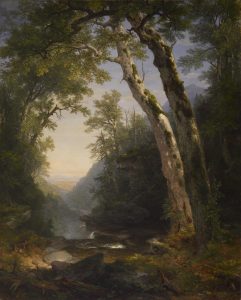
Parshat Tzav: A Drash
May 4, 2020
By Sid Goldstein
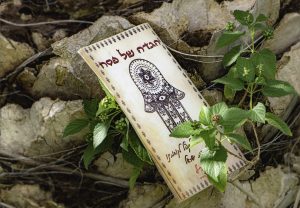
“Such are the rituals of the burnt offering, the meal offering, the guilt offering, the offering of ordination and the sacrifice of well-being which the Lord charged Moses on Mount Sinai.”
– Leviticus 8.37
One of the delights of the Book of Leviticus is the constant barrage of sacrificial details: dead animals, splattered blood, roasted entrails, and eventually, the leftovers — the bones, the rendered fat, and the mounds of ash.
For those not discouraged by such graphic details, the process-minded among us might wonder: at the end of a day of sacrifice, who was in charge of cleaning up?
This week’s Torah portion, Tzav, gives us an answer: The charred remains of roasted animals and their entrails were left not to a sacrificial janitorial team, not to the Israelites or Levites, but to the priests themselves – even to Aaron the High Priest.

For it was commanded in the Torah, “He [the priest] shall take off his [priestly] vestments and put on other vestments and carry the ashes the outside the camp.“
Rashi helps capture this scene in even greater detail, explaining that due to the huge amount of sacrificial ash and rendered fat, the High Priest would take off his sacred garb and don dirty clothes in order to handle the ashes. The spiritual leader, the intermediary between the people and God, ended each day by cleaning ritual refuse while dressed in rags.
Imagine for a moment the President of the United States taking the Oval Office garbage out to the curb every evening. Imagine Mark Zuckerberg or Bill Gates regularly cleaning out the corporate bathroom after a day of making billions. Here we have even Aaron the High Priest commanded to shovel ash in a shmata. This is what it means to be ‘The Chosen People.’ Let us take a moment to remember Fiddler on the Roof’s burdened milkman Tevye who wisely said, “Couldn’t you have chosen someone else?” But let’s look at the notion of sacrifice – for Parsha Tzav is the most prescriptive discussion of sacrifice in the Torah.
One of the most difficult elements of Torah and the way of life it describes is the phenomenon of animal sacrifice. Modern Judaism has survived without it for almost two thousand years. Virtually all the prophets were critical of animal sacrifice, not least Jeremiah in this week’s haftarah. While none of the prophets sought to abolish sacrifices, they were suspicious of those who offered them. What disturbed the prophets most was that many of the ancient Israelites thought of sacrifice as a kind of bribe: ‘If we make a generous enough gift to God then He may overlook our crimes and misdemeanors.’ Which raises the spiritual question, “is it possible to make God an offer he can’t refuse?”
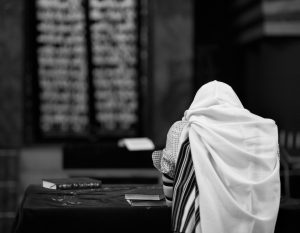
What, then, is the idea of sacrifice in Judaism and why does it remain important, even today? The simplest answer is this: We love what we are willing to make sacrifices for. That is why, when they were a nation of farmers and shepherds, the Israelites demonstrated their love of God by bringing Him a symbolic gift from their flocks and herds or, their grain and their fruit; that is, a bit of their livelihood. As Rabbi Jonathan Sachs wrote: “To love is to thank. To love is to want to bring an offering to the Beloved. To love is to give. Sacrifice is the choreography of love.” This is true in many aspects of life. A happily married couple is constantly making sacrifices for one another. Parents make huge sacrifices for their children. People drawn to a calling – to heal the sick, or care for the poor, or fight for justice – often sacrifice financially lucrative careers for the sake of their ideals.
During World War II those now dubbed “The Greatest Generation” made millions of sacrifices for their country. In strong communities people make sacrifices for one another when someone is in distress or needs help. As the writer Toni Morrison said “Sacrifice is the glue of relationships. It bonds us to one another.” That is why, in the Biblical age, sacrifices were so important. To quote Rabbi Sachs again, “at the beating heart of Judaism is love: “For we are commanded You shall love the Lord your God with all your heart, and with all your soul, and with all your might.” In many faiths, the driving motive behind sacrifice was fear: fear of the anger and power of the multiple gods. In Judaism it was supposed to be love.

Once we realize there can be a benign element to the idea of sacrifice, we begin to understand how deeply relevant the concept of benign sacrifice is in Western Civilization itself. The two major institutions of the modern world – the democratic state and the market economy – were predicated on the notion of benign sacrifice. This was best described by the idea the social contract formulated by the English political theorist Thomas Hobbes.
Hobbes’ account of the social contract was, in a nutshell, it is in the interest of each of us to sacrifice some of our liberty to a central power charged with ensuring the rule of law and the defense of all the people. Adam Smith’s insight into the market economy was that while we will always act to maximize our own advantage, we must do so in way that allows the general society to thrive. In short, there must be some governor of our actions. A governor to whom we must willingly sacrifice the worst of ourselves. As Hobbes says, sacrificing the worst of ourselves results in the growth of the commonwealth. This theory of social morality comes straight from Judaism.
Modern politics and modern economics were built on the foundation of the rational pursuit of self-interest governed by the notion of the sacrifice of total freedom. The democratic state and the market economy were serious attempts to harness the power of self-interest to the sacrifice of those passions that lead to mass violence. It is a system, that for better or worse, has sustained the Western World for over four centuries. And how have Jews survived within that system that their morality helped to create? Jews and Judaism have survived due to the many sacrifices people had to make for it.
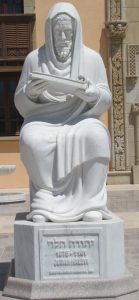
In the eleventh century the great scribe Judah Halevi expressed something close to awe at the fact that Jews stayed Jewish despite the fact that “with a word lightly spoken they could have converted to the majority faith and lived a life of relative ease.” The sacrifice then, is that in both Europe and America, Jews have set limits to their assimilation within the surrounding Gentile world. Among others, The philosopher Baruch Spinoza took note of these limits and the effect they had. He reflected on the hostility that these limits created in the greater Gentile world. That hostility has existed, particularly in Europe, for nearly a millennium. But the hostility against the Jewish decision to set limits on their participation in Gentile society had an unexpected side effect. Spinoza observed in his Theological-Political Treatise that “Gentile enmity has had the ironic effect of preserving Jewish distinctiveness.”
What did this mean in real life? It meant that the Jews’ ongoing adherence to their own set of ritual practices while living under Christian or Muslim regimes guaranteed a permanent minority status. This sacrifice of comfort and – even acceptance – marks the distinct trait of our people’s adherence to the principles, if not the physical actions referred to in Parsha Tzav. God’s commandment to Moses to perform the rituals of the burnt offering, the meal offering, the guilt offering, the offering of ordination and most of all, the sacrifice of well-being, echoes down from Mount Sinai to Sof Ma’arav in 2020. We continue the practice of sacrificing a bit of our time, a bit of our treasure and a bit of individual liberty, to sustain this observant community here in Hawaii. And we will continue to do so until, as Tevye, requested, the Lord chooses “someone else.”
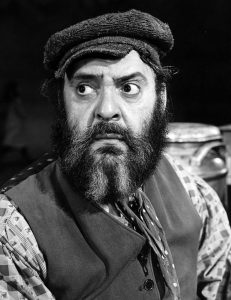
Holy Cow! – Parsha Chukat
August 15, 2019
By Naomi Olstein

While parsha Chukat deals with many topics, it begins with parah adumah, the red heifer. It is the most enigmatic mitzvah in all of Torah. More than a mitzvah, it is chukat haTorah – Law of the Torah. If a person comes in contact with a human corpse, she or he must go for ritual cleansing. The “defiled” individual shall then be sprinkled with a concoction made of the mixture of fresh water, mayim chayim, literally “living waters;” and the ashes of a slaughtered and burned “red” cow that had absolutely no blemishes nor ever bore a yoke. Now, here’s the paradox: the mixture of these “waters of lustration” cleansed the person who had been rendered ritually impure by contact with a corpse. However, the individuals who burned the cow, made contact with its ashes, and sprinkled the mixture on the “defiled” person would be rendered impure in the process. In other words, the act of making one person ritually pure makes the purveyor of purity impure.
At the core of all of this is the notion of tahor and tamai, “pure and impure.” These are states of being, reflective, I believe, of one’s bodily relationship to “life” and “not-life.” The things that make one tamai, “impure” are contact with various entities and conditions. These include dead animals, dead humans, and a number of different types of creeping things; skin diseases involving mortification of the flesh, tzaraat, contact with similar growths of inanimate objects, as well as menstruation and emissions of semen, and childbirth. None of these states of being are permanent, yet they all require “purification.” With the exception of childbirth, each of these “impurifying” things seems to have to do with “not-life,” a condition that would disqualify the individual from participation in the life of the holy. For ancient Israel, nothing was more central than being eligible to be part of the holy community. To do that, one had to be tahor, ritually pure, that is, “of life.”
Perhaps to our modern sensibilities, these notions of ritual purity and impurity are alien, even alienating. It is equally possible that our discomfort with such bodily states reflects a disconnection that we would do well to restore. Often the Torah touches on fundamental realities of the human condition from which we have distanced ourselves. Let’s face it: today death is a taboo subject. In fact, virtually all bodily processes are. Yet our ancestors didn’t have any problems with addressing the normal fluctuations of life. On the contrary, they saw the guf, body and life force, neshama, nefesh, and ruach, for what they are – profound mysteries that bind us to G-d. Our state of being was the essential component in our covenantal relationship with G-d. Just as the animal brought for sacrifice had to be without blemish, so for us to partake in the life of the covenantal community of holiness, we must be in a state of ritual purity.
Our connection with G-d is a corporal one. We are all in this together. Everyone has to be at their best, physically and spiritually. We have to be fully alive. Are we any different today? We might not like to speak of bodily emissions, we might not relate to all behaviors – netilat yadayim, washing of hands before a meal, mikveh, ritual bath, tahara, cleansing of the body before burial – that accompany the traditions surrounding ritual purity. However, we nonetheless live our lives with great attentiveness to our physical and emotional and spiritual states of being. We exercise. We diet. We meditate. We know what it’s like to feel “off” and we do whatever we can to get back “on.” We just don’t necessarily do it within the context of sacred community. Maybe we could learn something from Torah when it come to this.
The Rabbis identified this chok, “law,” from which the name of this week’s portion, Chukat derives, as one for which a reasonable understanding is humanly incomprehensible. It really might not be as elusive as we think. Perhaps there is great wisdom and insight in this seemingly bizarre practice. While we might not be on the lookout for red cows in our local pastures, which would prove a waste of time since the destruction of the Temple made this ritual obsolete, I think the underlying dynamics of these “waters of lustration” still speak to us today.
As far as parah adumah, how is it that the ashes of a dead animal make a corpse-defiled individual ritually pure and, in the process, how the one doing the purifying becomes impure. What is more important, what is essential to this ritual, is that the persons doing the “purifying” – the one who slaughters the cow, the one who burns the carcass, the one who gathers the ashes, the one who mixes the ashes, the one who sprinkled the ashes – are not priests but just members of the community. Indeed, Torah is clear, it is a community-centered ritual. As it says in Number 19:9, “The waters of lustration shall be kept by and for the community of Israel.” Simply put, this process of transitioning from “not-life” back to “life” is something we do to and for each other. Even today — all the time: as it states in Numbers 19:10, Chok Olam, Law for all time.
Every time members of our synagogue or extended Oahu Jewish family go into mourning, the community comes out to take on the mourner’s state of not-life. We sit with them. We pray with them. We embrace them and hold their hands. And we gently usher them back into life. We bring food to them. We affirm their recitation of Kaddish by saying “Amen.” Some of us stand with them. Some recite the Kaddish with them. And in so doing we assume – at least in part – their state of not-life. We adjust our daily lives. We accompany them to the cemetery. We surrender our evening activities. We take on their pain. We allow death to enter our state of being. We immerse ourselves in the spiritual waters of life and death. We transform in order to help others transform. We become community.
Which brings us back to the cow. The red cow. It has become a character of intense interest and mystery within the Jewish tradition. Some say it was incredibly rare. Some say it wasn’t really red, just brown and without any imperfections (Mishna Parah 2.5). Some say it was a symbol of the original sin of the Jewish people, The Golden Calf (as noted in B’midbar Rabbah 19:8). I just think it’s so obvious that…. it was a cow, a maternal life-giving creature whose own life force was surrendered so that the community could restore itself from the impurity of not-life. While I am personally grateful that we have moved on from animal slaughter as a means to ritually find meaning in our lives, I am not willing to lose the meaning our ancestors implicitly understood within the context of these now alien rituals. The great student of religion, Huston Smith called them “forgotten truths.” Perhaps we would do well to try and remember them. They touch at the core of our quest for the sanctification of life.